Save 40% off! Join our newsletter and get 40% off right away!

Sailboat Life
Sailboat Cruising and Lifestyle Magazine.

Sailboat Solar Systems and How-To

Solar on a sailboat goes together like hands and gloves, but sailboat solar systems can be installed in a variety of ways. The solar components themselves create an infinite combination of possibilities for off-grid sailing. Victron Energy chargers, Renogy Panels, Sunpower Yachts, BlueSea Systems, and many more brands have entered the marketplace, and that’s not including the lithium battery companies.
To simplify things, we’ve compiled three sailboat solar systems videos to give you an overview of what’s possible. And to help you decide on your own simple solar panel setup for sailing.
How-To Install Solar Panels on Your Sailboat
This system from Zingaro shows flexible panels summing 300w of power on a 38′ catamaran.
300W Solar System:
- Three 100w solar flexible panels
- 1 MPPT Solar charger controller
View on Amazon >>
100W HQST Flexible Solar Panels $100-$200
20amp Solar Charge Controller by Victron Energy $150-$200

Simple Sunpower Solar System
This simple solar system from The Fosters shows a quick and easy setup with limited space on top of a bimini.
Sunpower Solar Panels are considered by most in the industry as the gold standard. They use the highest-efficiency solar cells and have top-notch build quality. In this simple installation, three 50w panels are just enough to get you started. Plus, it’s the most affordable installation!
150w Starter Solar System
- Three 50w Flexible Solar Panels
- A Single 15amp solar charge controller
50W Sunpower Solar Panels $150-$200
75v/15amp Solar Charge Controller by Victron Energy $100-$124

Off-Grid on a DIY Solar Powered Sailboat
Here’s a special installation that turned a derelict sailboat into an off-grid sailing machine!
Simon has transformed this derelict sailboat into an epic off-grid solar-powered and fossil-fuel-free cruising catamaran. He’s been living aboard and renovating the boat for the past 3.5 years We’re excited to show you the transformation as well as how he plans to propel the boat without the use of diesel or fossil fuels!
5280w Solar System for Electric Powered Catamaran
- 16 Rigid solar panels (330w each)
- 20kwh of Lithium Batteries
240W Rigid Solar Panels $250-$300
200AH Lithium 4d Battery $1200-$1200

Share this post!
Throw in your two cents, start a discussion cancel reply, related articles.

The Voyage of the Sea Star – 35ft Sloop to Bermuda

Living Aboard a 30-36ft Sailboat: A Guide for the Curious and Adventurous

Summer Sailboat Video, Bikinis, Sails, and Fun

Saved Up For This Dream
- BOAT OF THE YEAR
- Newsletters
- Sailboat Reviews
- Boating Safety
- Sailing Totem
- Charter Resources
- Destinations
- Galley Recipes
- Living Aboard
- Sails and Rigging
- Maintenance
- Best Marine Electronics & Technology

Adding Solar Power to a Sailboat
- By Emily Fagan
- Updated: October 18, 2019
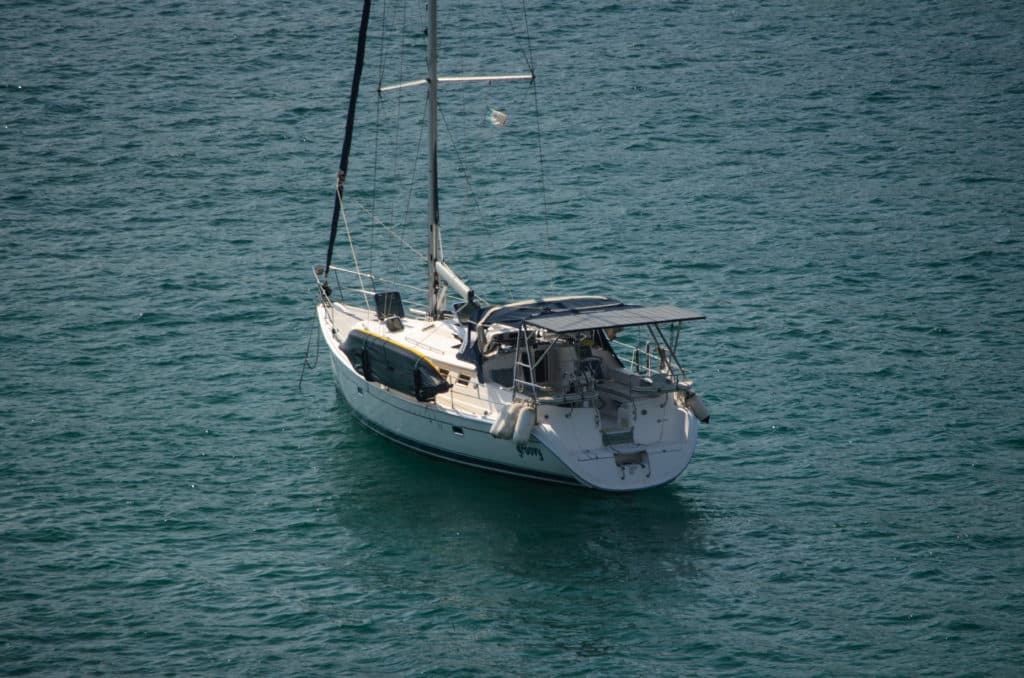
During our nearly four-year cruise of Mexico, my husband, Mark, and I lived almost exclusively on 555 watts of solar power charging a 640-amp-hour house battery bank. We anchored out virtually every night aboard our 2008 Hunter 44DS, Groovy , and relied on the sun for power. During one 10-week stretch, while we waited for a replacement engine alternator to arrive, our boat’s solar panels were our sole source of power. We had no backup charging system to turn to, and yet we lived and sailed comfortably the entire time. Mounting solar panels on a sailboat was not difficult, but a few key decisions made a huge difference in how effective our panels were.
A solar-power installation on a sailboat is made up of two independent systems: one system to charge the batteries, and another system to provide 120-volt AC power for household appliances. In the charging system, the solar panels convert sunlight into electrical current and deliver it to the batteries via a solar charge controller. Similar to a voltage regulator, the charge controller acts as a gatekeeper to protect the batteries from receiving more current than they need as they are being charged. In the AC power system, an inverter or inverter/charger converts the 12-volt DC power in the battery into 120 volts AC whenever it is turned on.
Panel Positioning and Wiring Considerations
One of the biggest challenges for sailors installing solar power on a sailboat is finding a place on the boat where the panels will be shaded as little as possible. Just a few square inches of shade on one panel can render that panel all but inoperable. Unfortunately, between the mast, radome, spreaders and boom, shadows cross the deck all day long, especially as the boat swings back and forth at anchor.
What’s worse, if the panels are wired in series rather than in parallel, this little bit of shade can shut down the entire solar-panel array. When we installed solar power on Groovy , we had already lived exclusively on solar power in an RV for over two years. Our RV solar panels had been wired in series, and we had witnessed the array shutting down current production when just half of one panel was shaded.
Choosing whether to wire the panels in series or parallel on a boat affects the wire gauge required, which is why many solar-power installers lean toward wiring the panels in series. Panels wired in series can be wired all the way to the solar charge controller with a thinner-gauge wire than those wired in parallel. This is because the voltage of panels wired in series is additive, while the current remains constant, so the current flowing is just that of a single panel. In contrast, the current flowing from panels that are wired in parallel is additive, while the voltage across them is not. This means that in a parallel installation, the current going to the charge controller is several times higher and requires much thicker cable to avoid any voltage loss over the length of the wire.
Not only is thinner-gauge wire less expensive, but it is also more supple and easier to work with, making the job of snaking it in and around various crevices in the boat and connecting it to the solar charge controller much less of a struggle. Thus the choice between series and parallel wiring boils down to a trade-off between system performance, expense and ease of solar system installation.
Luckily, the size of the wire can be reduced if higher-voltage solar panels are chosen. Since watts are determined by multiplying volts by amps, a higher-voltage panel that generates the same watts as a lower-voltage panel will produce less current. Therefore, selecting nominal 24-volt panels instead of 12-volt panels allows for the use of thinner wire sizes no matter how they are wired.
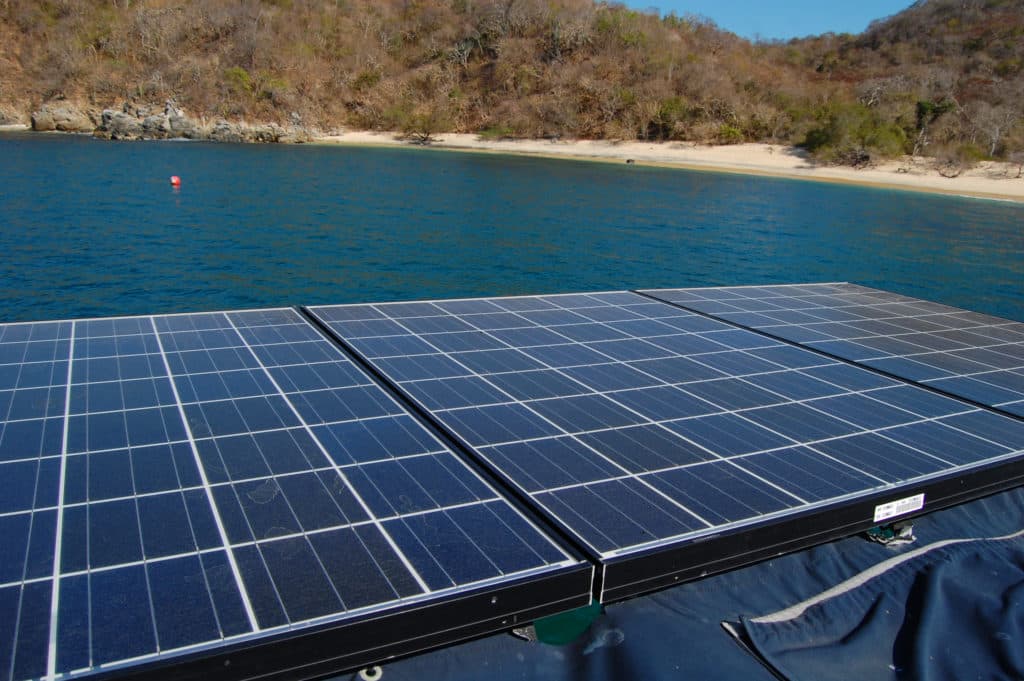
Our Marine Solar Panel Design Choices
In our installation, we decided to mount three 185-watt, 24-volt (nominal) Kyocera solar panels high above the cockpit, well aft of the boom, as far away as possible from potential shade. Our Hunter came with a big, solid stainless-steel arch, and we turned to Alejandro Ulloa, a brilliant metal fabricator at Baja Naval Boatyard in Ensenada, Mexico, to build a polished stainless-steel solar-panel arch extension onto the existing structure. He designed the arch extension with integrated telescoping davits to hoist our dinghy as well as support the solar panels. These davits were strong enough — and the lines and blocks had enough purchase — that either of us could lift our light Porta-Bote dinghy with its 6-horsepower outboard without a winch.
We spaced the panels about a half-inch apart and wired them in parallel. Using two twin-lead wires, we snaked the three positive leads and one common ground down through the inside of the arch tubes so they wouldn’t be visible, and placed wire loom over the exposed wires under the panels.
The junction points for the three parallel panels were on positive and negative bus bars inside a combiner box, all mounted in a cockpit lazarette. Inside the combiner box, we installed three breakers, one for each panel. This gave us the ability to shut off any or all of the panels if we needed to (we never did).
We mounted a Xantrex solar charge controller (model XW MPPT 60-150) in a hanging locker, as close to the batteries as possible, in a spot where it was easy to monitor and program. We ran twin-lead wire from the combiner box to the charge controller and from there to the batteries.
Our boat came with three new 12-volt Mastervolt 4D AGM house batteries, all wired in parallel, for a total of 480 amp-hours of capacity. We wanted a bigger house battery bank, and because it is best for the age, type and size of the batteries to be matched, we added a fourth new Mastervolt 4D AGM house battery, which brought our total to 640 amp-hours. Our batteries were installed at the lowest point in the hull, below the floorboards, and they ran the length of the saloon, from just forward of the companionway stairs to just aft of the V-berth stateroom door.
The best way to charge a bank of batteries that are wired in parallel is to span the entire battery bank with the leads coming from the charge controller. We did this by connecting the positive lead from the charge controller to the positive terminal of the first battery in the bank, and the negative lead from the charge controller to the negative terminal of the last battery. By spanning the entire bank, the batteries were charged equally rather than having the charging current focused on just the first battery in the bank.
We feel that AGM batteries are superior to wet cell (flooded) batteries because they can be installed in any orientation, don’t require maintenance, can’t spill (even in a capsize), and charge more quickly. Our Mastervolt batteries, like almost all AGM batteries on the market, are dual-purpose, combining the very different characteristics of both deep-cycle and start batteries. Our batteries work well, but if we were doing an installation from scratch today, we would consider the new Trojan Reliant AGM batteries. These batteries are engineered strictly for deep-cycle use and have been optimized to provide consistent current and maximize battery life.
Our boat came with a Xantrex Freedom 2,500-watt inverter/charger wired into the boat’s AC wiring system with a transfer switch. The inverter/charger performed two functions. While the boat was disconnected from shore power, it converted the batteries’ 12-volt DC power into 120-volt AC power, allowing us to operate 120-volt appliances, like our microwave. When the boat was connected to shore power, it charged the batteries.
Because this inverter/charger was a modified-sine-wave inverter, mimicking AC current with a stair-stepped square wave, we also had a 600-watt pure-sine-wave inverter to power our potentially more sensitive electronic devices. We chose Exeltech because its inverters produce an electrical signal that is clean enough to power medical equipment, and they are NASA’s choice for both the Russian and American sides of the International Space Station. For simplicity, rather than wiring the inverter into the cabin’s AC wiring, we plugged ordinary household power strips into the AC outlets on the inverter and plugged our appliances into the power strips. Like the charge controller, the inverter must be located as close to the batteries as possible. Ours was under a settee.
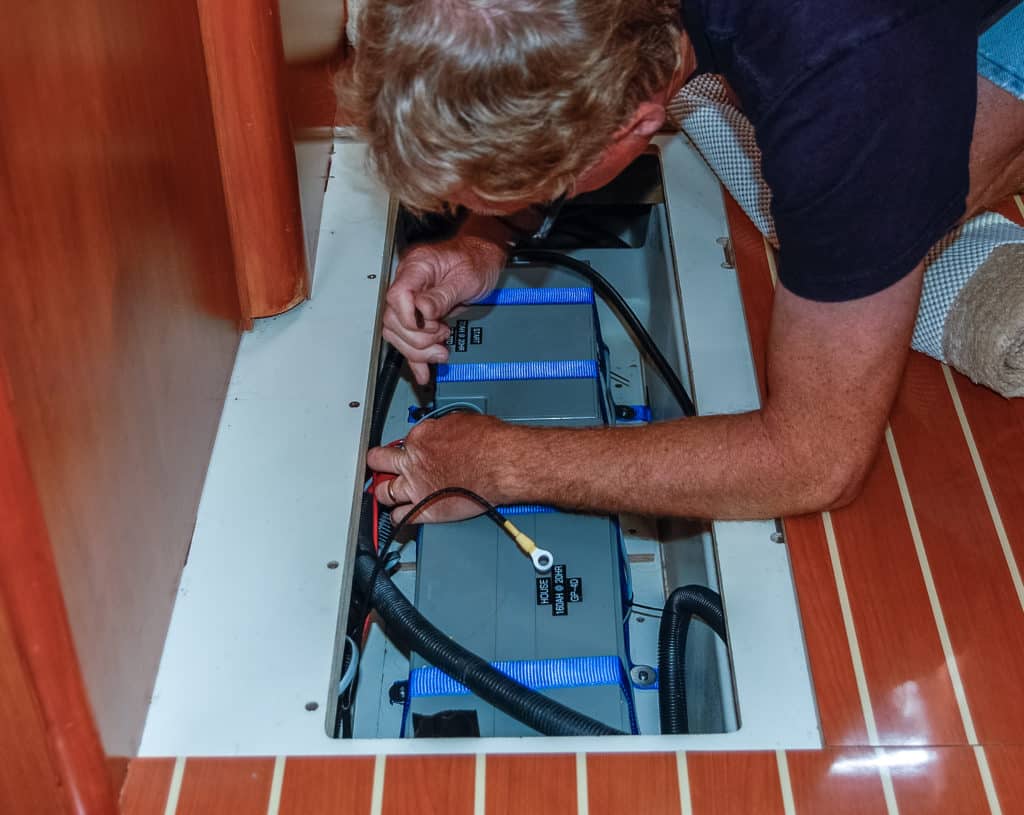
Shade’s Impact on Sailboat Solar Panels
Once our solar installation was completed on our sailboat, we closely observed the effects of shade on our solar-panel array. We were often anchored in an orientation that put the panels in full sun. Just as often, however, we were angled in such a way that shade from the mast and boom covered portions of our panels. It was fascinating to monitor the solar charge controller’s LCD display whenever the sun was forward of the beam — the current from the panels to the batteries fluctuated up and down as we swung at anchor.
Taking notes one morning, we noticed that the charging current was repeatedly creeping up and down between 9.5 and 24.5 amps as the boat moved to and fro. When the entire solar-panel array was in full sun, it generated 24.5 amps of current. When we moved so the mast shaded a portion of one panel, the array generated 15 amps. When it shaded portions of two panels and only one was in full sun, the array produced just 9.5 amps. Of course, it would have been preferable to see a steady 24.5 amps all morning, but this sure beat watching the current drop to zero whenever a shadow crossed a panel.
We discovered that shade makes a huge impact while sailing, too. Surprisingly, it is far worse to have the panels shaded by the sails than to have the panels in full sun but tilted away from its direct rays. One afternoon, we noticed that while we were on a tack that tilted the panels away from the sun, they generated 24.5 amps of current, whereas on a tack where the panels were tilted toward the sun but two of the three were partially shaded by the sails, the current dropped to a mere 10 amps.
Reflections On Our Solar Panel Installation
A wonderful and surprising side benefit of our large solar panels and arch system was that the setup created fabulous shade over the jumpseats at the stern end of the cockpit. Our metal fabricator, Alejandro, placed a support strut at hand-holding height, and sitting in those seats feels secure and comfortable while sailing, no matter the conditions.
After living on solar power for eight years of cruising and land-yacht travel, we’ve learned that you can never have too much solar power. Groovy’s 555 watts was enough to run all our household appliances as needed, including our nearly 4-cubic-foot DC refrigerator, two laptops, a TV/DVD player, and lights at night. However, it was not quite enough power to run all that plus our stand-alone 2.5-cubic-foot DC freezer during the short days and low sun angles of the winter months without supplemental charging from the engine alternator every few days. For the 10 weeks that we did not have a functioning alternator, our solution was to turn off the freezer, which enabled our batteries to reach full charge every afternoon.
Solar power made a world of difference in our cruise. Not only did it allow us to live comfortably and with ample electricity for weeks on end when our engine alternator went on the blink, but as a “set-it-and-forget-it” system, it also gave us the freedom to anchor out for as long as we wished without worrying about the batteries. In our eyes, the solar-panel arch enhanced the beauty and lines of our boat, giving her a sleek and clean appearance. It was true icing on the cake to discover that the panels and arch system also provided much-needed shade over the cockpit and helm from the hot tropical sunshine. If you are preparing for a cruise, consider turning to the sun for electricity and outfitting your sailboat with solar power.
The Installation:
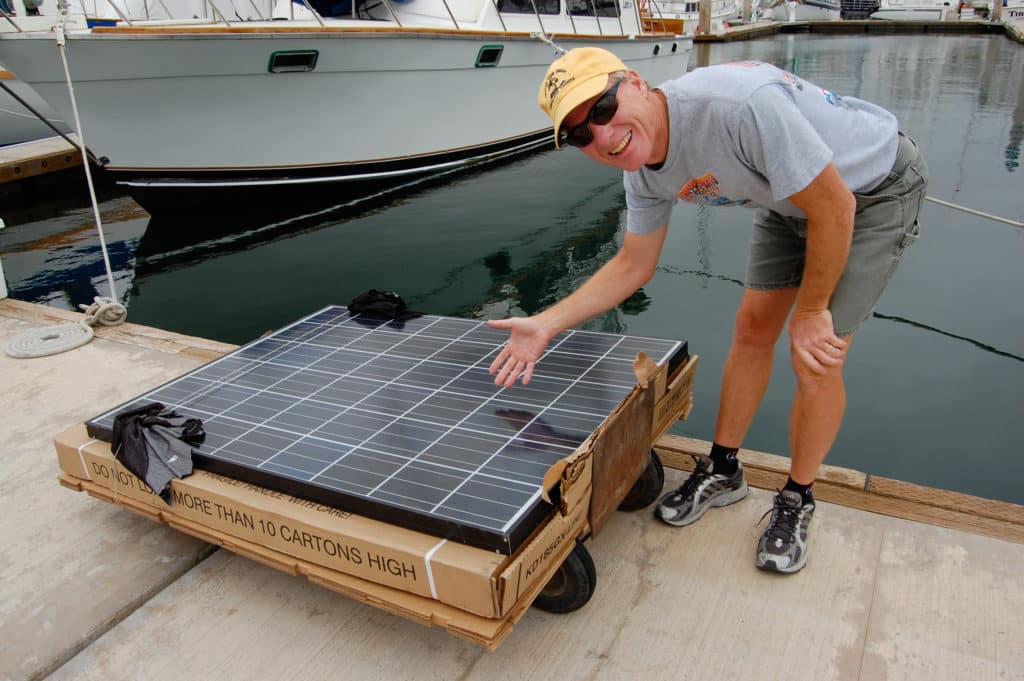
Emily and Mark Fagan offer cruising tips and share their stories and photos on their website, roadslesstraveled.us . They are currently enjoying a land cruise across America aboard an RV.
- More: DIY Sailboat Projects , green sailing , How To , installations , Refits , Sail Green , solar , solar panel , Upgrades
- More How To

3 Clutch Sails For Peak Performance

It’s Time to Rethink Your Ditch Kit

8 Ways to Prevent Seasickness

How To De-Winterize Your Diesel Engine

Kirsten Neuschäfer Receives CCA Blue Water Medal

2024 Regata del Sol al Sol Registration Closing Soon

US Sailing Honors Bob Johnstone

Bitter End Expands Watersports Program
- Digital Edition
- Customer Service
- Privacy Policy
- Email Newsletters
- Cruising World
- Sailing World
- Salt Water Sportsman
- Sport Fishing
- Wakeboarding

Top 3 Best Solar Panels For Sailboats

Last Updated by
Daniel Wade
June 15, 2022
Choosing whether or not to install solar panels on your sailboat is a big decision. They are not exactly cheap, though they can start to pay themselves off pretty quickly.
This article is going to cover not only why you might want to use solar panels but all the benefits they provide. You will also find a helpful guide on which solar panels would be best for you and your budget. Hopefully, by the end, you will feel confident in your decision to install solar panels on your sailboat and even have an idea of which ones you might like.
Table of contents
Are solar panels on sailboats necessary?
Whether or not you should be installing solar panels on your boat is a matter of choice, not out of necessity. Sailboats get their power from the wind, by harnassing it in their sail. So if you plan to be sailing for the afternoon you probably don’t need solar panels.
You could charge a battery pack from the marina and that will probably see you through several trips. The problems only really start to arise if you are planning to be on your sailboat for longer periods, or even permanently. If you plan to live on your sailboat year-round, even if you spend 80% of it in a marina, you would be better off with some solar panels. Even if it is just as a backup source of power.
Are solar panels on boats safe?
Solar panels are generally pretty safe. They have no moving parts and typically have a very strong protective cover over them so you never come in contact with the electrics themself. So, as a source of power, they are generally pretty safe. The only time they may become unsafe is if they are badly damaged.
Solar panels are often covered by glass plating that keeps them safe. It also helps them absorb sunlight and warmth. This is great, except when the glass breaks. If the glass protective cover on your solar panels should crack and splinter you are at risk of serious injury from sharp shards of glass. Not only is the glass itself dangerous at this point, so are the electronic components inside. They have powerful currents running through them, and if you come in contact with them you may be in for a shock.
Furthermore, if these electronics get wet they can become deadly. Electricity and water do not mix well at all. Being as you are on a sailboat, at sea, the chances of them getting wet is very high. Luckily, the chances of them breaking in the first place are slim to none. The only real way they would break, besides vandalism, is by debris hitting them during a bad storm. There is not often debris at sea, so this shouldn’t be too much of a problem.
What are the benefits of having solar panels on a sailboat?
There are so many great benefits of having solar panels on a sailboat. They can be a lifesaver if you find yourself at sea for a long time. There benefits range from trivial comforts to being the difference between life and death. Here are some of the benefits you might not have considered about having solar panels installed on your sailboat.
Money-saving
Solar panels are not cheap, it is far cheaper to just run a generator or charge your batteries from the marina the whole time. At least, it is in the short term. Over time, it can start to become very expensive. With solar panels, you are looking at a big initial cost (the solar panels themself) and then it’s smooth sailing. You don’t need to pay for power again. Solar panels last for about 40 years before they start to become too inefficient at producing power. The cost of a few solar panels upfront compared to 40 years of marina fees and gasoline for a generator is the financially savvy move.
Emergency power
If you find yourself at sea, the wind dies down (or becomes too strong), and you find yourself stuck bobbing around waiting for more favorable conditions you may run into trouble. Depending on how long you are out there, you may find yourself with dead electronics. Be it a satellite phone, radio, or secondary engine (depending on the boat). Having a set of solar panels and a power bank can be a genuine lifesaver in these situations.
Comfort amenities
Whether you are day sailing or making a week-long voyage, having access to the comforts in life can make the whole journey so much more enjoyable. The amenities may not be available to you without having a constant source of power at sea. Having access to a kettle, tv, videogame system, radio or microwave oven may be the only thing keeping you going at rougher times. As exciting as sailing can be, when you aren’t sailing and are just bobbing around it can be quite dull. The sea is beautiful, but there is only so much time you can spend looking at the water before you miss the comforts of land. With solar panels, you can bring those comforts with you.
Eco-friendly
There are only two alternatives to solar panels. A gasoline generator, and taking power from the grid. Neither of these is good for the environment. Luckily, solar panels are a great third option. Solar panels are completely eco-friendly and are great for the environment. This is not just great for the earth, and your conscience, but for the journey itself. If you are running a gasoline generator at sea you are going to be listening to it thrumming away and smell the burning gasoline. Wouldnt you prefer silence and nothing but the smell of the sea breeze?
How much do solar panels cost?
How much solar panels cost is almost entirely tied into both their voltage/wattage and whether or not they are portable panels. Portable solar panels are great for people who don’t spend a lot of time on their boat or are happy enough living off the marina’s power grid. Permanent solar panels, the kind that may need to professionally installed, can end up costing far more. They are also likely to be far superior and you can pretty much forget about them once they are installed.
Portable solar panels will cost just a few hundred dollars each. You will need a few to be sustainable, but that’s not going to be much of a problem. These portable solar panels can just be rolled out on the deck of your boat, weighed down, and then hooked up to a battery pack. The battery itself here is going to be the most expensive part of the whole set up. A decent-sized battery could set you back a $1000. But, when charged fully it will last days. Even with constant use.
Permanently installed solar panels can cost one or two thousand dollars in some cases. The advantage here though is once they are installed that’s it, you can forget about them. You don’t have to put them up, take them down, and find somewhere to stow them every time they need using. They too will need to be hooked up to a battery, the battery is still only going to cost you $1000. If you are installing permanent solar panels because you plan to be making long voyages, it is ideal to have two or perhaps even three large batteries hooked up to your boat. One to run off, one or two for emergencies.
How do I maintain my solar panels?
Solar panels, unlike gasoline generators, are generally pretty easy to maintain. They have no moving parts and are thus pretty self-sufficient. They don’t need taking apart and they last as long as 40 years. That being said, if they do break they need repairing as soon as possible. The exposed electrics can be deadly when water is thrown into the mix. Which, on a boat, is almost always. The glass cover will need replacing and the electronics inside may need repairing, though not always. Don’t ever attempt to do this yourself unless you are experienced at making these repairs. The cost of hiring someone to do it for you is preferable to being dead. Solar panels have very powerful electric currents, that when in contact with water and yourself can be fatal. As mentioned above, these panels rarely break so you will likely not ever run into this problem. If you do, hire a contractor.
Do my solar panels need cleaning?
Solar panels work by converting the light and heat of the sun into useable power. The process itself is rather complicated but the results are simple to understand. That being said, there are some reasons that your solar panels will stop working as effectively. They all revolve around a lack of sunlight. It could be because it is night time. It could be because it is very cloudy. Or, it could be because they are dirty. If solar panels become too dusty, dirty, and become too covered in grime they stop operating at maximum efficiency. This is not as much of a problem at sea, the sea spray stops dust settling. The biggest thing you will need to clean off your solar panels is salt build-up and slime. This is easy enough to do with some warm soapy water. Freshwater, not seawater. You want to be removing as much salt as possible. Salt is corrosive to electronics, so removing it is important. Never clean your solar panels using pressure washers as they can crack the glass.
Which are the best solar panels for sailing?
There are so many options on the market at various price points. Here are three very different options that will all make good choices, depending on your needs. It is important to consider not just price but power output. Spending a lot of money on solar panels now might not feel ideal, but it is the most cost-effective decision.
1. Renogy Starter Kit
This starter kit is going to be perfect for installing on almost any sized boat. There are four solar panels, each can be fitted permanently to the boat. They can be mounted (and unmounted) easily, for your convenience. They do require a flat surface, but they are small enough that that likely won’t be too much of a problem. This starter kit is very middle of the pack price-wise but should provide enough power for a small to medium-sized vessel easily. It is also possible to buy extra panels individually should you need them.
Wattage: 400/4 (100 per panel)
2. Nature Power Rigid
The nature power rigid is a large, powerful, single solar panel. If you are looking for the right panels to power your entire boat comfortably, these are the ones for you. They are very large so they will need a large flat surface area. alternatively, they can be hung vertically from rails. This is an inefficient way of using them, so you would need to buy more this way. Nature power makes various solar panels so you could find some smaller ones of the same brand to supplement it. This one is not so easy to install, you might need to hire someone to install it for you.
Wattage: 165
3. Nature Power Monocrystalline
Nature power makes a portable solar panel that fits inside a special briefcase. It is perfect for stowing away easily and only taking it out when it is needed. It is decently powerful considering its portable, but there is the inconvenience factor of having to set it up each time. If you planned to buy the nature power rigid, buying one of these portable panels might be ideal for supplementing your power supply when it is especially sunny. Though, it may be cheaper for you to just fit more of the Nature Power Rigids.
Wattage: 120
Hopefully, you now have a good idea about whether solar panels would be right for you and your sailboat. Sailing is great, but the lack of power at sea can be dreadfully boring. Luckily, there are so many great options available on the market. Not just the ones mentioned above. Buying a solar panel is an investment, the initial cost is minor compared to the steady return from all the savings you will make.
Related Articles
I've personally had thousands of questions about sailing and sailboats over the years. As I learn and experience sailing, and the community, I share the answers that work and make sense to me, here on Life of Sailing.
by this author
Sailboat Upgrades
Most Recent

What Does "Sailing By The Lee" Mean?
October 3, 2023

The Best Sailing Schools And Programs: Reviews & Ratings
September 26, 2023
Important Legal Info
Lifeofsailing.com is a participant in the Amazon Services LLC Associates Program, an affiliate advertising program designed to provide a means for sites to earn advertising fees by advertising and linking to Amazon. This site also participates in other affiliate programs and is compensated for referring traffic and business to these companies.
Similar Posts

How To Choose The Right Sailing Instructor
August 16, 2023

Cost To Sail Around The World
May 16, 2023

Small Sailboat Sizes: A Complete Guide
October 30, 2022
Popular Posts

Best Liveaboard Catamaran Sailboats
December 28, 2023

Can a Novice Sail Around the World?
Elizabeth O'Malley

4 Best Electric Outboard Motors

How Long Did It Take The Vikings To Sail To England?

10 Best Sailboat Brands (And Why)
December 20, 2023

7 Best Places To Liveaboard A Sailboat
Get the best sailing content.
Top Rated Posts
Lifeofsailing.com is a participant in the Amazon Services LLC Associates Program, an affiliate advertising program designed to provide a means for sites to earn advertising fees by advertising and linking to Amazon. This site also participates in other affiliate programs and is compensated for referring traffic and business to these companies. (866) 342-SAIL
© 2024 Life of Sailing Email: [email protected] Address: 11816 Inwood Rd #3024 Dallas, TX 75244 Disclaimer Privacy Policy

Service Locator
- Angler Endorsement
- Boat Towing Coverage
- Mechanical Breakdown
- Insurance Requirements in Mexico
- Agreed Hull Value
- Actual Cash Value
- Liability Only
- Insurance Payment Options
- Claims Information
- Towing Service Agreement
- Membership Plans
- Boat Show Tickets
- BoatUS Boats For Sale
- Membership Payment Options
- Consumer Affairs
- Boat Documentation Requirements
- Installation Instructions
- Shipping & Handling Information
- Contact Boat Lettering
- End User Agreement
- Frequently Asked Questions
- Vessel Documentation
- BoatUS Foundation
- Government Affairs
- Powercruisers
- Buying & Selling Advice
- Maintenance
- Tow Vehicles
- Make & Create
- Makeovers & Refitting
- Accessories
- Electronics
- Skills, Tips, Tools
- Spring Preparation
- Winterization
- Boaters’ Rights
- Environment & Clean Water
- Boat Safety
- Navigational Hazards
- Personal Safety
- Batteries & Onboard Power
- Motors, Engines, Propulsion
- Best Day on the Water
- Books & Movies
- Communication & Etiquette
- Contests & Sweepstakes
- Colleges & Tech Schools
- Food, Drink, Entertainment
- New To Boating
- Travel & Destinations
- Watersports
- Anchors & Anchoring
- Boat Handling
- ← Technology
What You Need To Know About Boat Solar Panels
Advertisement
Sunshine and boats are a natural together, so why not use all that free energy? Here’s the lowdown on solar panel selection and installation
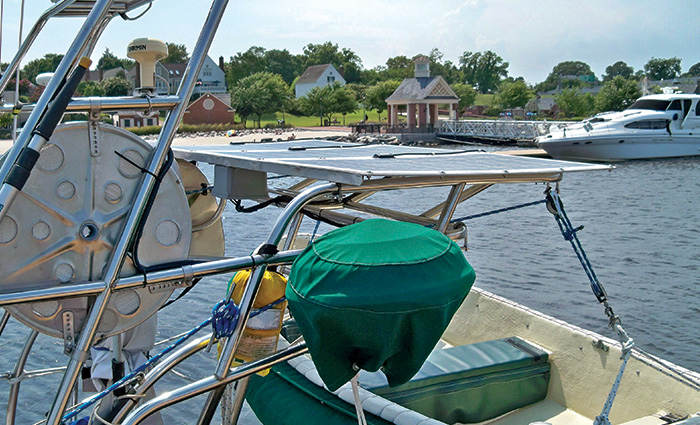
I first embraced the idea of solar power while up a pole (literally) in the Atlantic Intracoastal Waterway replacing dead batteries. It was the early 1980s, and I was maintaining buoys, beacons, and other such Aids To Navigation (ATON) for the U.S. Coast Guard, replacing massive, nonrechargeable batteries with rechargeable solar-powered ones. The higher-ups said the solar rechargeables would last six years – twice as long as the one-shot batteries. As the deck-ape in charge of lugging all those batteries up and down the ladders, my back and I immediately appreciated the whole “free power from the sun” thing, a concept I continue to embrace.
The strategy behind s olar energy onboard is simple: A solar panel converts sunlight into electricity, after which wiring conducts it to your batteries for storage until needed. Solar panels are used to keep batteries or banks charged rather than to power equipment directly. This arrangement allows the panels to store generated power whenever produced, while providing a steady source of power to a piece of equipment even when the panel is producing no power.
While they do require an initial outlay, solar panels can easily pay for themselves in money saved and independence gained over their service life. They’re noiseless, have no moving parts, and they provide free electricity for years with minimal maintenance. Solar panels also have the benefit of being modular, letting you start small and add more as your power requirements increase.
The benefits of solar
Almost any boat can benefit from solar power. Whether at a slip, mooring, or on a trailer, boats can keep their batteries topped off without the need for external power. You can also use solar power to supplement or even replace other onboard charging sources, reducing or eliminating the need to run engines or generators to keep batteries topped off (a wasteful practice that burns fuel while wearing down the costliest pieces of equipment onboard).
While underway, it’s a plus to be able to recharge a dead battery in an emergency – say, to operate a VHF radio or navigation gear. While dockside, solar panels keep batteries charged and vital systems (such as bilge pumps) up and running without the need for shore power.
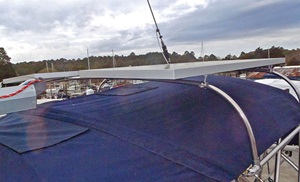
Just about any boat can benefit from solar power, whether it’s to keep batteries topped off or supplement other onboard charging sources.
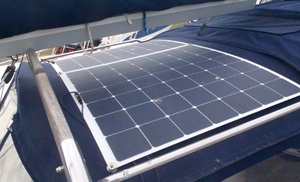
Mount solar panels where they are exposed to maximum sunlight but do not interfere with operation of the vessel.
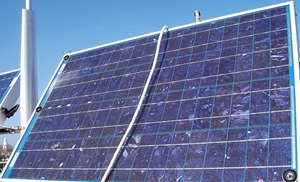
Bottom: Something as simple as the shadow of a line or shroud can reduce or halt output.
Types of panels
Solar panels contain photovoltaic cells – small silicon semiconductor devices that convert sunlight into electricity. Each cell generates between 0.45 and 0.5 volts, depending on exposure to direct sunlight. Cell size determines amperage, with a 3-inch cell producing roughly 2 amps, a 4-inch cell a little over 3 amps, and a 5-inch cell around 5 amps.
Construction-wise, the three main types of solar panels are monocrystalline, polycrystalline, and amorphous (or thin-film) technology.
Monocrystalline panels have been around the longest and remain the most popular. The panels are constructed of thin slices of crystal silicon (each cell is cut from a single crystal) housed in a rigid, aluminum frame and covered with tempered shatterproof glass. The panels have a uniform black, blue, or gray appearance and are generally quite rugged, although they can be cracked or broken if subjected to extreme abuse.
Monocrystalline panels have the longest service life of the three types. With a conversion efficiency of around 17%, they’re also the most efficient and have the highest electrical output per area, but they are also the most expensive.
Polycrystalline cells are sliced from a cast silicon block and have a shattered glass appearance. Built in much the same way as monocrystalline panels, they’re rectangular, giving the panel itself a tiled look. Their life span is similar to monocrystalline panels, and while their conversion efficiency is lower (by 14%), they’re also a bit less expensive.
Amorphous panels are made by placing a thin film of active silicon on a solid or flexible backing (such as stainless or aluminum sheeting) depending on whether the panel is to be rigid-framed and glass-fronted or flexible. Flexible amorphous panels, in which cells are sandwiched between rubber and polymer covers, are light and tough enough that you can walk on them and, in some cases, even roll them up for storage.
This type of solar panel is also better if shade is an issue. With crystalline panels, even the thin shadow of a rope or shroud across one cell can reduce or halt output of an entire module. Amorphous panels have “bypass” diodes that essentially turn off shaded cells and provide a current path around them. Some monocrystalline panels also have bypass diodes, but this feature comes at an increase in cost.
Amorphous panels are the least expensive of the three types, but their efficiency is also lower – around 8%, or roughly half that of a monocrystalline type. This lower output is somewhat mitigated in newer panels, however, which use three-layer construction. Each layer absorbs different colors of the solar spectrum, so the panel will deliver more power longer each day and during lower light conditions than the other two types.
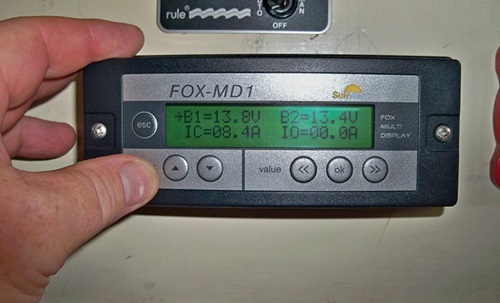
The charge controller should be mounted below decks and as close to the battery as possible.
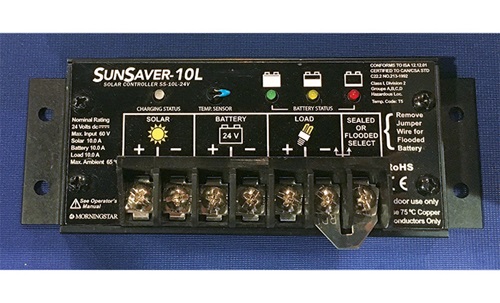
Follow manufacturer instructions for wire connections.
Planning the system
While factors such as cost, mounting options, and output are important, a successful installation depends on knowing what you want the system to accomplish. Is the goal to float-charge a single battery or supplement an overall vessel energy plan? Answering these questions up front will help determine the type, size, and number of panels required.
To understand the process better, let’s walk through the basic steps to determine power requirements and installation considerations for a single solar panel installation. While the example itself is simple, the steps are the same used to plan more complicated installations.
For our example, the goal is to install a solar panel to provide charging for a single 12-volt, 100-amp-hour wet-cell battery used to power an automatic anchor light on a moored vessel.
The first step is compiling a daily power consumption estimate to determine how much solar power is needed.
The daily self-discharge rate for a wet-cell battery is roughly 1%, meaning our 100-amp-hour battery requires one amp every 24 hours just to maintain the status quo. The anchor light draws 50 milliamps per hour of operation, and we’ll assume it operates 10 hours each night. Multiplying current draw (50 milliamps) by hours of daily operation (10) generates a daily energy expense of 500 milliamps or .5 amps.
This means our solar panel must meet a minimum daily energy tab of 1.5 amps – one amp of battery self-discharge rate plus .5 amps of power draw for the anchor light.
Next up is figuring out panel size and the best mounting location. For our example, let’s assume the panel will be a horizontal, fixed-mount installation. A 10-watt horizontally mounted panel should generate between 3- and 5-amp hours per day.
We’ll need at least 13 volts to fully charge our 12-volt battery. As most solar cells generate at least 0.45 volts, you’ll want a panel with a minimum of 33 cells, which should provide around 14.85 volts.
Keep in mind that’s the minimum needed, which may not be enough once you factor in a few cloudy days. Most panels are designed to generate between 15 and 20 volts to overcome problems like cloudy days or inherent electrical resistance within the panel or installation components. While this higher voltage lets you make up for less electrically productive days, it also means you’ll want to install a solar charge controller (voltage regulator) to avoid battery damage due to overcharging.
Attempts to plan a system that tries to use the output of the panel and capacity of the battery to prevent overcharging (and avoid the installation of a charge controller) is false economy and should not be done. The system will never meet its full output potential and, worst case, can damage the battery due to overcharging.
A word on ‘charge controller confliction’
If your vessel has multiple charging sources, such as solar panels and a wind turbine, a crucial but often overlooked consideration is “charge controller confliction.” In short, this is an issue where the charge controller for your solar panel and the charge controller for your wind turbine are internally adjusted to the same maximum charge voltage set point. This means they are constantly fighting each other to be the dominant power source, which results in diminished overall charging output and performance. An in-depth article on this issue can be found at missioncriticalenergy.com (in the website footer, click “Superwind Turbine Manuals & Technical Bulletins.” Under the header “Charge Controllers,” select the document “Resolving Charge Controller Confliction”).
While this article addresses charge controller confliction at remote, off-grid sites, the information provided is also applicable to vessel installations. — F.L.
Location and mounting
Solar panels should be mounted in a location where they are exposed to the maximum amount of sunlight but do not interfere with operation of the vessel or the movement of passengers and crew. Solar panels will typically be either fixed or mounted on some type of movable bracket that allows you to actively point the panel toward the sun for maximum output. Both methods have their pros and cons. Fixed panels (which are normally mounted horizontally) don’t produce as much power as a panel that can be adjusted to face the sun. The downside is that adjustable panels must be aimed throughout the day to maximize their output.
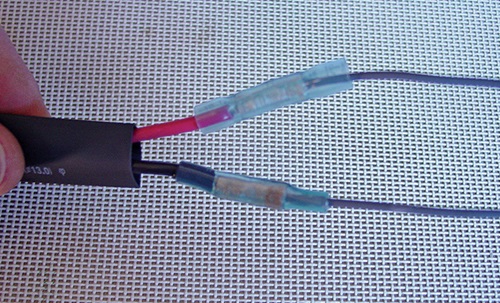
Use good quality, marine-grade heat shrink connectors (top) and liquid electrical tape (right) to create airtight, waterproof seals and reduce corrosion.
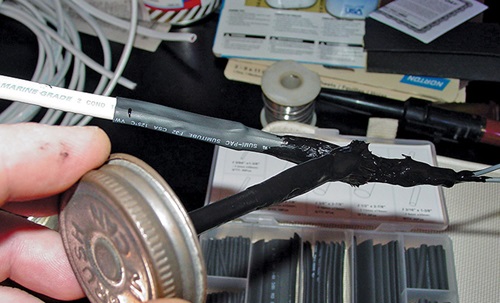
Installation
After choosing and mounting your panel, it’s time to connect it. The first thing you need to determine is the size (gauge) of the wiring to be used. Multiply your panel’s rated amp output by 1.25 (which adds a 25% safety factor). Then measure the length of the entire wiring run, panel to battery, and multiply by 2. Once you have these two numbers, refer to the American Boat and Yacht Council’s (ABYC) 3% voltage-drop table for wire size. Ancor Products offers a handy wire calculator on its website ( ancorproducts.com/resources ).
Always use good quality marine grade connectors and tinned, multi-stranded copper wire with vinyl sheathing. The wire will run from the solar panel to the charge controller first, then to the battery. Try to keep the wire run as short as possible, and if it transits an external deck or cabin house (it likely will), be sure to use an appropriate weatherproof deck fitting.
The charge controller should be mounted below decks and as close to the battery as possible. You’ll always want to follow the manufacturer’s instructions for connections, but in a typical installation you’ll connect the solar panel’s positive (red wire) lead to the charge controller’s positive input wire or terminal and the negative (black wire) lead to the charge controller’s negative input wire or terminal.
Next, connect the charge controller’s negative output to the battery negative terminal and the controller’s positive output to the battery’s positive terminal via an appropriately sized in-line fuse (or circuit breaker). ABYC recommends these be installed within 7 inches of connection to the battery or other point in the DC system. To reiterate, the installation of the charge controller can vary among models, so follow the manufacturer’s installation instructions.
Finally, ensure all connections are waterproof and secure any loose wire runs with wire ties and cable clamps for a neat installation. Then get ready to lean back and soak up some free sun.
Related Articles
The truth about ceramic coatings for boats.
Our editor investigates the marketing claims of consumer-grade ceramic coatings.
Fine-Tune Your Side Scan Fishfinder
Take your side-scanning fishfinder off auto mode, and you’ll be spotting your prey from afar in no time
DIY Boat Foam Decking
Closed-cell foam flooring helps make boating more comfortable. Here’s how to install it on your vessel
Click to explore related articles
Frank Lanier
Contributing Editor, BoatUS Magazine
Capt. Frank Lanier is a SAMS Accredited Marine Surveyor with more than 40 years of experience in the marine and diving industries. He’s also an author, public speaker, and multiple award-winning journalist whose articles on boat maintenance, repair, and seamanship appear regularly in numerous marine publications worldwide. He can be reached via his YouTube channel “Everything Boats with Capt. Frank Lanier” and website captfklanier.com.
BoatUS Magazine Is A Benefit Of BoatUS Membership
Membership Benefits Include:
Subscription to the print version of BoatUS Magazine
4% back on purchases from West Marine stores or online at WestMarine.com
Discounts on fuel, transient slips, repairs and more at over 1,200 businesses
Deals on cruises, charters, car rentals, hotel stays and more…
All for only $25/year!
We use cookies to enhance your visit to our website and to improve your experience. By continuing to use our website, you’re agreeing to our cookie policy.

9 Best Solar Panels for Sailboats
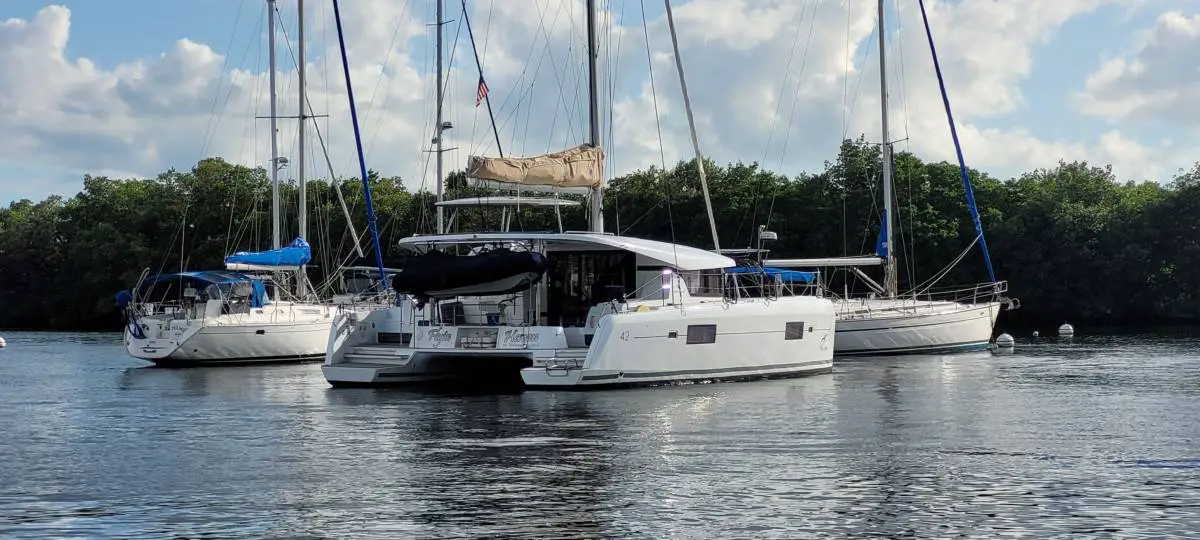
As an Amazon Associate, we earn from qualifying purchases. We may also earn commissions if you purchase products from other retailers after clicking on a link from our site.
Solar panels have become game changers when it comes to supplying power while off the grid. Marine solar panels can charge anything from batteries to computers to bigger electronic appliances. What are the best solar panels for sailboats?
The 9 best solar panels for sailboats are:
- Renogy Flexible Solar Panel
- Newpowa Solar Panel
- SunPower Flexible Sol ar Panel
- Eco-Worthy Off-Grid Solar Panel
- Rich Solar Polycrystalline
- Topsolar Flexible Solar Panel
- HQST Monocrystalline Solar Panel
- WindyNation Solar Panel Complete Off-Grid
- DOKIO Solar Panel Kit
This article will explore everything you need to know about the best marine solar panels.
Table of Contents
Solar Panels on Sailboats: An Overview
Before exploring the best solar panels, it is helpful to consider how solar panels on sailboats work and how many you need. Solar panels sit on different parts of a sailboat’s surface and absorb the sun’s rays, converting them into energy. This energy is used to power chargers, fridges, cooking stoves, and other electronics you need for self-sufficient sailing.
Worth noting is that today we will only discuss solar panels and not the batteries, which of course is an essential part of a complete system; we will also not discuss charges or charge controllers.
The products in this post will get you started in the right direction, but if you’re looking for a high-output system, then I suggest you contact someone that can help you calculate your energy requirements.
How Many Solar Panels Do I Need for My Sailboat?
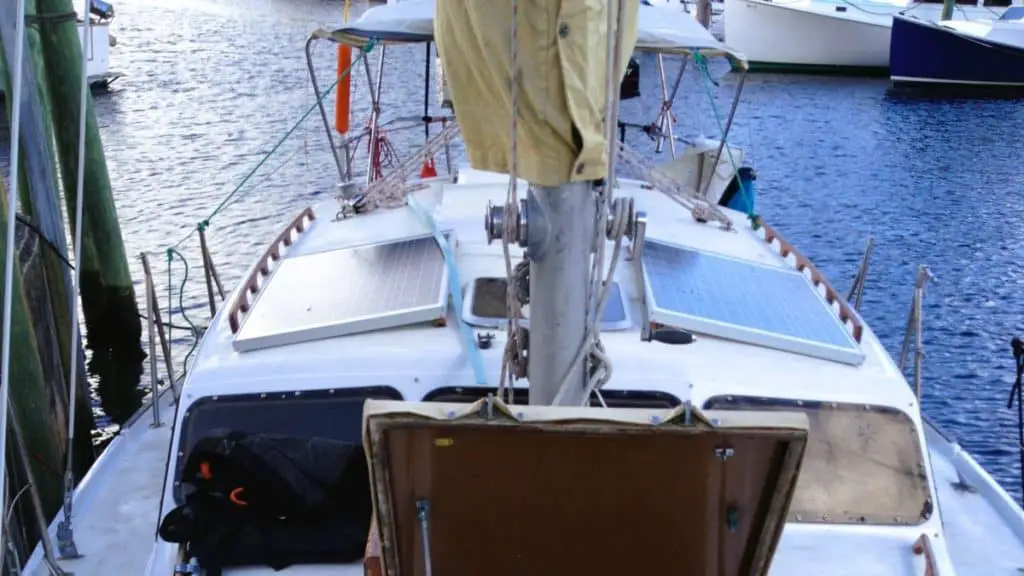
You will need between 2-8 solar panels for your sailboat. The exact amount depends on your sailboat’s space and how many electronics you need to power. Most solar panels can absorb between 100-300 watts per hour. On average, you will need approximately 1500 watts of power each day.
If your solar panels absorb 1500 watts daily, here’s what they can power on your sailboat:
- A laptop charger
- A microwave
- A coffee maker
- An induction cooker
If you want to power more heavy-duty electronics like a washing machine or a television, look for solar panels that absorb 400 watts. For heavy-duty electronics, try installing 5-8 solar panels.
Flexible vs. Rigid Solar Panels
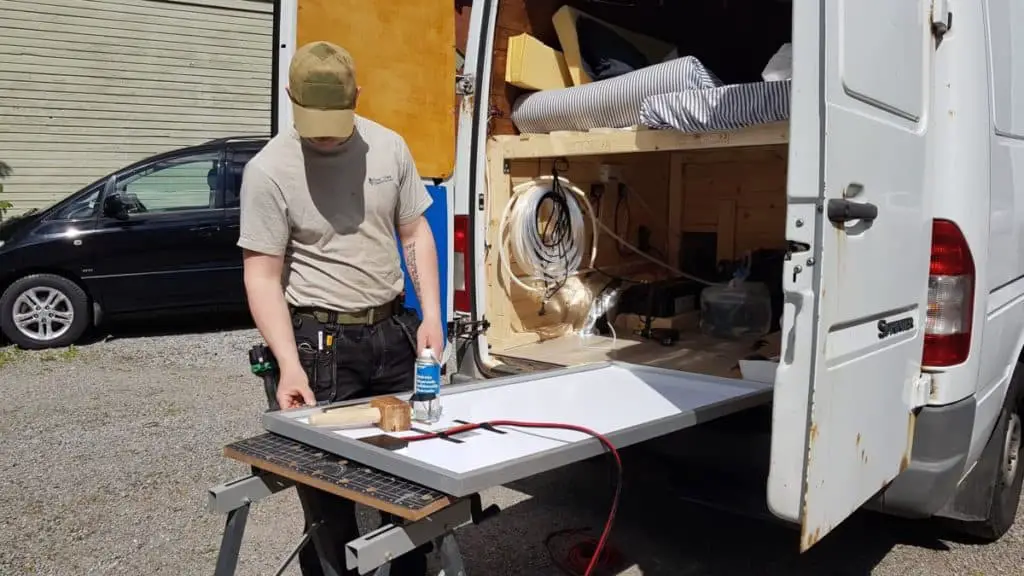
The three main types of solar panels are rigid panels, flexible panels, and semi-flexible panels.
Rigid panels are surrounded by aluminum and made with sturdy tempered glass. They are resilient against various weather conditions but require flat space to install.
Semi-flexible panels can be slightly bent to fit the shape of the installation surface. However, they can’t absorb a lot of power.
One very common type of solar panel used on boats is the flexible panel . Flexible panels are thin and lightweight, and, as their name suggests, they can be added to a wide variety of surfaces.
Here are the pros of flexible panels:
- They are thin and light. Flexible panels are approximately one-eighth the weight and size of rigid and semi-flexible panels. This allows you to add them to various sailboat sizes and surfaces. It also reduces the load on your sailboat.
- They are easy to install. Flexible panels are easy to work with and can be self-installed by following the instructions that come with the panels. Meanwhile, rigid and semi-flexible panels may require expert installations.
- They’re sturdy. Despite being light, flexible panels can bear a lot of pressure – you can easily walk over them.
However, there are also some drawbacks to using flexible solar panels:
- May fly away . As flexible panels are fragile, they can easily be dislodged and fly away, especially in strong winds.
- Vulnerable to scratches . While flexible panels can bear much weight, they may get scratched more easily. Over time this may affect their functionality.
- Not easy to reposition. Flexible panels are generally adhered to the surface of a sailboat using a specially prepared adhesive. Because of this, it is challenging to reposition the solar panels when there is a change of season.
- Less efficient. Flexible solar panels don’t convert energy to electricity or rigid panels. It may be harder to power heavy-duty appliances from a flexible solar panel.
How Many Panels Can I Fit on a Sailboat (Catamaran and Monohull)?
The amount of panels you can fit on your sailboat depends on the size of the panels and the surface space you have available.
You can fit at least two 400W panels on a Monohull and at least four on a Catamaran around 35ft in length. You will be able to fit 4-8 more solar panels if you add a solar panel bracket at the stern.
Renogy Flexible Solar Panel 100W
Renogy is a popular solar panel producer that designs high-quality solar panels. The Renogy Flexible Solar Panel is specially designed for marine vehicles, including sailboats.
Here are the best features of this solar panel:
- Flexibility . These solar panels are fragile, making them flexible and easy to mount on served surfaces.
- Easy to install. These are made with high-quality Monocrystalline, allowing them to be easily bent and easy to install.
- Lightweight. One solar panel weighs only 4 pounds, ensuring that no extra pressure or weight is displaced on your boat.
- Durability . User reviews have noted that these panels are highly durable and can last you a few years.
- Users have noted that these panels do not have the best outputs. They also can’t be stacked, which impacts their accessibility. To ensure that these panels can be connected, you may purchase extra extension cords.
Newpowa Rigid 160W Solar Panel
The Newpowa Right Solar Panel is a new design with a maximum power of 160W. It is weather-resistant and can be used on various surfaces and vehicles.
Here are the pros of the Newpowa Solar Panel:
- Weatherproof . The design features of this solar panel ensure that it survives under a range of different weather conditions. It has a heavy-duty frame preventing it from strong wind and waves. Its mainframe has a further layer of protection for the Junction box.
- Long warranty . Newpowa offers a 25-year transferrable output power warranty.
- Easy to install . These solar panels are made with mono cells and bypass diodes. Consequently, the solar panels can be immediately unpacked and are ready to install.
- High wattage. As these solar panels have 160 Watts of power, you need less of them to power all the devices on your boat.
- If you are planning on buying the Newpowa Solar Panel, you should note that they only make rigid panels. As a result, you may find it to be difficult to install them on curved spaces.
SunPower 110W Flexible Solar Panel
SunPower’s Flexible Solar Panels are made with high-quality materials ensuring durability. They are especially ideal for sailboats as their warranty also covers saltwater damage.
Here are the standout features of the SunPower 110W Flexible Solar Panel:
- Flexibility . This solar panel can be bent up to 30 degrees, making it easy to install on various surfaces.
- Easily portable. These solar panels are incredibly lightweight (4.4 pounds or 2 kilograms) and can be easily uninstalled and transported.
- Extended warranty . SunPower offers a five-year warranty on power and a two-year warranty on the product. The warranty includes damage caused by saltwater which many other solar panel warranties do not.
- Some users have noted that the output quality of these solar panels deteriorates over time. However, you can use the extended warranty to address any quality deterioration.
ECO-WORTHY Rigid 25W Off-Grid Solar Panel
This is a rigid, 25-watt solar panel that is waterproof, making it ideal for your boat. It is highly durable and has inbuilt indicators that highlight the battery’s status. Its low output makes it only suitable for charging phones or smaller electronics.
Here are some notable features of the Eco-Worthy Solar Panel:
- Ease of use. This solar panel is easy to install and requires no maintenance.
- Warranty. Eco-Worthy offers one year of warranty on all of its products and free maintenance if needed.
- USB control. This solar panel is attached to a USB control panel, preventing it from overcharging and getting damaged.
- Waterproof. All solar panel parts are entirely waterproof and can handle exposure to both saltwater and freshwater.
Some of the drawbacks to this solar panel include:
- Low watt absorption. Unlike many of the other solar panels on this list, this one can only absorb up to 25 watts of power at a time. So, it can only power smaller devices like batteries.
- Instruction manual. Some users have noted that the instructions to set up the Eco-worth solar panel are confusing for beginners. If you have never installed solar panels before, it’s best to call in an expert to help.
RICH SOLAR 100W Rigid 12V Polycrystalline
This 100W rigid solar panel is designed to absorb energy even in low light conditions. It is easy to install and ideal for marine environments.
Here’s why you should consider buying Rich Solar Panels:
- Works well in low light. This solar panel has been tested in various low light conditions, including cloudiness and during sunrise and sunset. It is certified to be able to harvest energy in low light conditions.
- Extended warranty. Rich Solar Panels offers a 25-year warranty on limited power output and a five-year warranty on quality.
- Water and weatherproof . The Rich Solar panels have used selective design elements to ensure they are water-resistant. They have high transparency and are made with tempered glass to withstand high winds and water pressure.
- Cost-effective . These are significantly cost-effective, making it easy to equip your sailboat fully.
- While solar panels can easily resist strong winds and water, they can be vulnerable to hail. Hail storms can cause dents on the solar panels, which can eventually cause damage.
Topsolar Flexible 100W Solar Panel
Topsolar provides premium flexible solar panels that are easy to move and install. They are ideal for installing on water vessels like sailboats with waterproof materials.
Here are some of the pros of choosing the Topsolar Flexible Solar Panel:
- Flexibility . The arc radius of this solar panel is 16 inches (40 centimeters) and can be bent to fit several curved surfaces allowing your solar panel to harvest the most sun.
- Efficiency . These solar panels are made with ETFE (ethylene tetrafluoroethylene) materials. They are extremely energy efficient and can rapidly convert energy.
- Some users have noted that these solar panels don’t have as long a life as other panels. In addition, some panels may only be able to absorb up to 75 watts of power at a time.
HQST Rigid 100w Monocrystalline Solar Panel
This is a 100-watt solar panel that has been specially designed to perform well in low light. It is made with high-quality materials and is ideal for sailing boats as it is durable even in unfavorable weather conditions.
Here are the pros of installing the HQST Solar Panel:
- Durability . These solar panels are designed to withstand strong winds and snowfall. They’re made with tempered glass and aluminum and are resistant to corrosion, ensuring longevity.
- Testing and warranty. Each solar panel is quality tested before it is distributed. It also comes with a three-year warranty.
- Easy to install . While these are rigid solar panels, they have pre-drilled holes, making them easier to install.
WindyNation 100W Solar Panel Complete Off-Grid
As its name suggests, this solar panel is designed for off-the-grid living and is helpful if you need to access power when you’re in the middle of the sea.
Here is why you should consider the WindyNation Solar Panel:
- Includes a charge controller. This controller lets you quickly see the amount of power the solar panel has absorbed.
- High power. Several positive user reviews have indicated that this solar panel is highly efficient in absorbing and converting power.
- This solar panel is more expensive than many others on the market.
DOKIO 300W 18V Portable Solar Panel Kit
If you are looking for a heavy-duty solar panel, the Dokio Solar Panel Kit is excellent. It can absorb a lot of energy and power a wide range of appliances on your sailboat.
Here’s why you should consider this solar panel:
- Versatile and flexible. While this is a rigid solar panel, it can be folded, making it easy to transport and install.
- High efficiency. This solar panel is highly efficient at converting energy into power. As it absorbs up to 300 watts, you can install just two of these panels to get significant energy.
- Some users have noted that this solar panel does not work well in low-light conditions. You may want to have a backup solar panel for days when it’s rainy and windy.
Here are Some of My Favorite Catamaran Cruising Resources
Thank you for reading this article. I hope you found it helpful as you hopefully start your sailing adventures. Here are some resources that I use as a sailor that I hope you’ll also find helpful. These are affiliate links, so if you do decide to use any of them, I’ll earn a commission. But in all honesty, these are the exact things that I use and recommend to everyone, even my own family. Sailboats: If you’re looking for the best boat to suit your needs, I would recommend a catamaran. If you’re interested, I can show you the differences between catamarans and other types of sailboats .
Books: For getting started, I really like Cruising catamarans made easy . It is actually a textbook from the American sailing association; it is used to get a cruising catamaran certification. There are some other great books, and I have compiled a list of books about cruising catamarans that you will find useful.
Communication: Being out on adventures, whether it be sailing or climbing mountains, good communications are essential to being safe. I recommend two things Google fi (incredibly simple cellular data all over the world) and Garmin inreach mini (for text and voice in remote areas without cell coverage)
Sailing courses: Online sailing courses are great for beginners starting out their sailing career; it’s an efficient way of learning the basics of navigation, throttle controls, and maritime safety. I suggest starting with two free courses from NauticEd .
To see all my most up-to-date recommendations, check out this resource that I made for you!
Owner of CatamaranFreedom.com. A minimalist that has lived in a caravan in Sweden, 35ft Monohull in the Bahamas, and right now in his self-built Van. He just started the next adventure, to circumnavigate the world on a Catamaran!
Leave a Reply Cancel reply
Your email address will not be published. Required fields are marked *
Save my name and email in this browser for the next time I comment.
Recent Posts
Must-Have Boat Gear for Catamaran Sailors!
Sailing is probably the most gear-intensive activity I've ever done; there are so many decisions to be made about what gear to buy now, for tomorrow, and what to definitely never buy. The gear on...
6 Best Trailerable Trimarans For Bluewater and Coastal Sailing
Having a boat costs a lot of money, even when you are not using it, marina fees, etc. And once it is in the water most sailors never go very far from their "home marina" and sailing will be somewhat...
- Sign in / Register
- Comparison list
- Solar on the go
Picking the best solar panels for a sailboat: Buyer’s guide
- 18 Aug 2022

You might have already heard of brave sailors that conquer the oceans with nothing but wits and solar panels. For instance, this year 83-year-old Kenichi Horie became the oldest person to sail solo from the US to Japan on a solar-powered boat. These stories are inspiring, but picking panels for your boat yourself can be a small challenge in itself. That’s why we wrote a short article about the best solar panels for sailboats and how to recognize them.
Start from type of solar panels
When it comes to solar panels for sailboats, their weight and size matters more than with PV modules for residential systems. Efficiency is important but power — not that much, because the energy needs of a boat are relatively low. The first thing you’ll have to decide about your panels is their type.
Generally, you’ll choose between thin-film panels and monocrystalline modules. While polycrystalline panels are still around and they are indeed cheaper than mono panels, they are much less efficient, which means they’ll need more space and add more weight to your boat.

Thin-film panels are light and cheap
Thin-film or flexible solar panels bend well and they are very easy to install which makes them a great choice for boats with difficult configurations. Some sailors say that flexible panels are the best choice for fast boats because they don’t impact the aerodynamics of a vessel as much as rigid panels do.
The downside of flexible panels is their low wattage. If there are many appliances on board, you’ll need several panels and you’ll need to find the right place for each of them. They also age faster than rigid panels — a thin-film panel generally lasts for 10-15 years.
Monocrystalline panels are powerful and reliable
Rigid solar modules, monocrystalline and polycrystalline, are heavier and bulkier than thin-film panels. You can fix flexible panels with adhesives, but rigid panels require drilling. They are also more expensive than flexible panels.
On the other hand, monocrystalline panels are the most efficient type of panels which means that they provide more power for less space. Even one powerful mono panel can be enough for everything that you’ve got on board. They are also much more reliable and will survive any storm that is coming your way. A monocrystalline panel lasts for at least 25 years.
Panels for boat should be efficient and sturdy
The best solar panels for sailboats don’t have to be powerful, but they better be efficient — find the number in the datasheet. For rigid panels anything over 18-19% is fine. Panels also should be sturdy enough to withstand seastorms. You generally also want good shading tolerance since panels often get shaded by masts and sails. Finally, good performance in low-light conditions is appreciated.
Picking bifacial panels, 72/144-cell panels or larger, anything too powerful generally doesn't make a lot of sense. Performance at high temperatures matters less than it does with home systems. Warranties also play a lesser role. You won’t be able to make use of them because they generally have effect only for residential installations.
The markets of thin-film and rigid panels are different. Generally, a manufacturer of flexible panels doesn’t offer mono- or poly-panels. Canadian Solar, Q CELLS and Jinko Solar are good choices when it comes to monocrystalline modules for boats. Renogy , WindyNation and PowerFilm make fine thin-film panels.
Do the math before purchase
The amount of power for your boat depends on the number of appliances on your board. There are two main ways to determine the size of installation that you need. You can take a test trip and see how much of your battery’s charge you’ve spent in one day. You can also do the calculations manually: write down all the appliances on the board with their power rating and number of hours in use per day. You can read about it in detail in our article " How much solar power to sail the seas? " It doesn’t make sense to oversize a marine PV system, because all the excess power will just go to waste.
Keep in mind that adding photovoltaics doesn’t make your vessel a solar boat, unless you have a solar-powered motor. You can switch your boat to solar energy fully, especially if it’s small, but you’ll have to calculate your energy needs accordingly.

Once you’ve purchased your panels, you’ll have to install them properly. You can order professional service or do it yourself. The most popular places for solar panels on a boat are a stern rail, masts, deck and canvas. Thin-film panels can even go on the sails. Ideally, you want a place where panels wouldn’t be shaded by masts on any other parts of a boat.
List of solar panels for a sailboat
We’ve asked our engineer to pick the panels that would complement a small boat well. These are his choices:
ZNShine Solar ZXM6-NH120-370/M

Solar panels from ZNShine Solar are inexpensive and fit all kinds of applications, including boat systems. ZXM6-NH120-370/M provides 370 Watts of power with a 19.88% efficiency. It performs well in low-light conditions. Graphene coating increases power generation and allows self-cleaning. The only downside is a lower wind tolerance, compared to other models: it is rated to withstand 2400 Pa pressure which is comparable to 140 mph wind.
Mission Solar MSE345SX5T

MSE 345 is a simple solar panel for all kinds of applications, including boat installations. Mission Solar panels are manufactured in Texas. The module provides 345 Watts of power with 18.7% efficiency. It is certified for high snow (5400 Pa) and wind loads (4000 Pa). The model is resistant to salt mist corrosion.
Suntech STP 365 S

Suntech is a Chinese company that offers quality budget-friendly solar panels. The STP365S model stands out in line because of its great performance in weak light, such as cloudy weather and mornings. It is designed to withstand harsh weather conditions, and the module is certified to tolerate wind of over 170 mph. Half-cut design makes cells sturdier and improves shading tolerance. Overall, this panel earns a place among the best boat solar panels.

Andrey had been a news editor and freelance writer for a number of medias before joining A1SolarStore team. Climate change and its impact on people's lives has always been among his interests and it partially explains his degree in Philosophy and Ethics.
Solar monitoring systems: All under control
Inergy solar generators review: Taking charge
AC vs DC-coupled solar battery systems: Pros and cons
How to clean RV solar panels
Solar panel size range: From tiny to large
Learn about the latest arrivals and discounts first!
By clicking "Subscribe", I agree by electronic signature to: (1) receive marketing and other texts and messages from A1SolarStore, directly or from third parties acting on its behalf, at the email address I entered above; (2) the Terms and Conditions ; and (3) the Privacy Policy .
Yachting Monthly
- Digital edition

Best Solar panels for off-grid power and keeping batteries charged
- Phil Sampson
- November 28, 2022
We take a look at 6 of the best solar panels for boats, from folding units to cutting-edge flexible panels

Free power forever? If only it was that simple! Photo: Graham Snook
For many in the boating community, solar panels represent something of a holy grail. They are, after all, the gift that keeps on giving, aren’t they? Free power forever, (or many years anyway), coupled with zero running costs – what could possibly be better than that?
All you have to do to make this dream come true is banish the memory of the purchase price from your mind – something boaters are notoriously adept at doing – and wait for the sun to shine. If only it were that simple…
The fact of the matter is that there are costs associated with solar panels beyond the price of the panels themselves. While some types of panels can be simply laid on the deck, in many cases some form of mount will be required.
Then there’s the wiring to hook them up to your battery, plus any fitment and/or cosmetic work needed to hide the cabling from view. If your panels are to be left connected permanently, you’ll require a regulator too.
This will prevent both overcharging and a reverse flow of power out of the battery after dark. If you do not fit a regulator, a blocking diode can be used to halt the reverse flow instead.
But once all of the above have been overcome – and providing you’ve done your homework to ensure your panels will generate sufficient power to cover your needs – then, yes, it’s a power free for all!
There are many other benefits to boat solar panels too: First and foremost, they work all on their own – solar panels are automatic, so you can just let them get on with the job.
Apart from the occasional wipe over and a wiring check, they’re largely maintenance-free too. Unlike wind generators, (especially like the one with wonky bearings on that boat moored next to you), they don’t make any noise.
And finally, your batteries will be pleased, because keeping them from going flat can extend their life.
Here’s our choice of the best boat solar panels.
6 of the best boat solar panels available right now

Giosolar 1,000W flexible solar panel
Best flexible boat solar panel
Delivering a mighty kilowatt of power, (not far off the amount used by a one bedroom house), this Giostar package comprises ten separate 100W panels, each of which is 1,050 x 540 x 2.5mm in size.
Capable of charging either 12 or 24V batteries, a kit of this magnitude is one for the most serious of solar enthusiasts – Eco Experts reckons 660-990W is sufficient for a liveaboard.
Giostar panels are abrasion resistant, anti-rust and dust proof and their junction boxes are sealed and waterproof. The panels are also light, thin and flexible, and can withstand being bent up to 30 degrees.
Reasons to buy: Incredible amount of power, panels are abrasion resistant as well as anti rust + dust proof
Reasons to avoid: Premium price
Price: £1,464.45
Buy it now on Amazon (UK)
Note: We may earn a commission when you buy through links on our site, at no extra cost to you. This doesn’t affect our editorial independence.
Ecoflow 160w portable solar panel.

Mobisolar 100W foldable solar panel
Best foldable boat solar panel
Mobisolar’s foldable panels are light (4.5kg) and measure 121 x 56.5 x 3 cm when unfolded, with the longest dimension reducing to 60 cm when folded, making them easy to transport.
The panels use advanced technology to provide superior performance, with each panel subjected to a thorough testing routine before and after assembly.
So confident is Mobisolar in its products that the company stands behind its panels with a two-year defect warranty and a five years’ electrical performance warranty.
For maximum flexibility in operation, three USB power outputs are fitted per panel, one delivering 100W, the second 60W and the third 10W.
Reasons to buy: Foldable, lightweight and long warranty
Reasons to avoid: Not resistant to the elements, doesn’t feature mounting holes
Price: £145.00
Buy it now on eBay

Eco-worthy 100W solar panel kit
With 100W panels being ideal for keeping batteries topped up, our second offering in this power class is from Eco-worthy, a major player in the solar panel field.
Competitively priced, our link below is for a kit which includes an LCD control unit and four ‘Z’ brackets in addition to the panel itself.
The Eco-worthy 100W panel is of the monocrystalline type, which means their cells are made from an ingot grown from a single silicon crystal of high purity. It’s also a rigid panel, so this particular product would need to be mounted on a frame or flat surface.
Reasons to buy: Competitively priced, Features LCD panel, brackets
Reasons to avoid: Only a year warranty, not resistant to elements
Price: £113.99

PV Logic 20W Flexi solar panel
Offered by Force 4 Chandlery, this lightweight semi-flexible solar panel comes complete with a dual battery solar charge controller.
The panel is completely waterproof thanks to its six-layer, heavy-duty laminate finish, and should a wayward crew member plod over it in their size 9s the panel’s dimpled top surface is ‘self healing’.
The controller can handle both 12 and 24V systems and the panel’s PWM (Pulse Width Modulation) charging system is efficient and battery-lifetime friendly.
Supplied with LED battery-status indicators and 4 metres of cable, PV Logic Flexi panels can be bonded to flat or curved surfaces.
Reasons to buy: Lightweight, waterproof, dual controller
Reasons to avoid: Lacks mounting options
Price: £149.95
Buy it now on Force 4 Chandlery

Powoxi 10W solar panel
At the budget end of the market comes this Powoxi 10W solar panel charger kit. While you won’t go far on just 10W of power, this kit claims to be capable of charging and maintaining various 12V batteries.
The kit features a fully automatic charging and maintenance controller, which provides intelligent three-level charging and protection against short- and open-circuits, under voltage and overloading.
A reverse flow system is included and the interface is described as ‘plug and play’. While the panel is rainproof, it will not withstand immersion in water, so this is a product to perhaps leave behind on the dock when you take to the water.
Reasons to buy: Great budget option, plug and play
Reasons to avoid: Not waterproof, won’t go far on 10V
Price: £27.59

Eco-worthy 10W/5W solar panel
The least pricey option we could find anywhere, this baby 5W solar panel is simply a trickle charger. But if that’s all you need then look no further, for this is another Eco-worthy product.
The technology in the panel is polycrystalline, so it’s not the most efficient on the market, but for this power that’s hardly a great concern.
The panel is supplied with two charging options; a pair of crocodile clips which attach directly to the battery, and a cigarette lighter plug.
According to the product’s eBay listing, this seller alone has sold approaching 3,000 of these units – and at this price, we can understand why!
Reasons to buy: Incredible price, can be charged via car lighter plug
Reasons to avoid: Small, not very efficient
Price: £9.99
- Hiking Shoes
- Hiking Boots
- Hiking Sandals
- Trail Runners
- Base layers
- Hiking Shirts
- Fleece Jackets
- Softshell Jackets
- Rain jackets
- Down Jackets
- Hiking Pants
- Hiking Shorts
- Base Layers
- Rain Jackets
- Hiking Bras
- Baby Carriers
- Cookware Sets
- Water Filters
- Water Purifiers
- Sleeping Bags
- Sleeping Pads
- Hiking Poles
- GPS Devices
- Solar Chargers
- Dive Regulators
- Dive Computers
- Dive Watches
- Dive Wetsuits
- Dive Gloves
- Dive Lights
- Dive Knives
- Spearfishing Wetsuits
- Spearfishing Masks
- Spearfishing Fins
- Spearfishing Watches
- Freediving Wetsuits
- Freediving Masks
- Freediving Fins
- Freediving Watches
- Sit On Top Kayaks
- Inflatable Kayaks
- Fishing Kayaks
- Tandem Kayaks
- Touring Kayaks
- Kayak Paddles
- Kayak Seats
- Kayak Roof Racks
- Kayak Carts
- Stand Up Paddle Boards
- Touring SUPs
- Inflatable SUPs
- Fishing SUPs
- SUPs For Yoga
- SUPs For Surfing
- SUP Paddles
- Climbing Boots
- Belay Devices
- Climbing Shoes
- Women's Climbing Shoes
- Bouldering Shoes
- Approach Shoes
- Climbing Pants
- Bouldering Pants
- Mountain Bikes for Men
- Mountain Bikes for Women
- MTB Handlebars
- Bike Saddles
- Bike Computers
- Bike Lights
- MTB Jackets
- Bike Helmets
- Bike Packing Gear
- Fat Biking Gear
- Ski Bindings
- Ski Helmets
- Ski Goggles
- Ski Jackets
- Snowboarding Bindings
- Snowboarding Boots
- Snowboard Helmets
- Snowboard Goggles
- Snowboard Pants
- Snowboard Jackets
- Snowshoe Poles
- Avalanche Beacons
- Avalanche Probes
- Avalanche Shovels
- Ski Backpacks
- Surfboards For Beginners
- Surfboards For Kids
- Surfboard For Small Waves
- Soft Top Surfboards
- Foam Surfboards
- Body Boards
- Boogie Boards
- Kiteboarding Kites
- Kitesurfing Boards
- Kiteboarding Harnesses
- Surfing Wetsuits
- Men's Rash Guards
- Women's Rash Guards
- Board Leashes
- DLSR Travel Cameras
- Mirrorles Travel Cameras
- Point and Shoot Travel Cameras
- Fuji Travel Lenses
- Nikon Travel Lenses
- Tripods for Travel
- DLSR Landscape Cameras
- Mirrorles Landscape Cameras
- Point and Shoot Landscape Cameras
- Fuji Landscape Lenses
- Nikon Landcape Lenses
- Canon Landcape Lenses
- Tripods for Landscape Photo
- Wildlife Cameras
- Wildlife Lenses
- Wildlife Tripods
- Wildlife Monopods
- Birdlife Cameras
- Birdlife Lenses
- Surfboards For Small Waves
Best Solar Panels For Sailboats of 2024
Sailing uses the power of the wind to move, so why not use the power of the sun to charge your batteries? Solar panels offer the best way to charge boat batteries. This method can also save the engine from being used just for charging. Getting the best solar panels for sailboats means choosing the right size and power for your boat.
But, how much power will you need? Will your panels be able to keep up even on cloudy days? Do you plan to sail in cold water or deep in the tropics? Do you need the panels to sit on a curved surface? There’s a surprising amount of factors to consider when purchasing sailboat solar panels.
Whether you’re replacing old panels or buying for the first time, let us do the hard work of comparing the best solar panels for your boat.
For more of our top sailing gear recommendations, check out the Best Wind Generators for Sailboats .
QUICK ANSWER – THE BEST SOLAR PANELS FOR SAILBOATS
- Nature Power Monocrystalline
- Nature Power Rigid
- Renogy Starter Kit (4 panels)
- Newpowa Poly Solar Panel
- Acopower Polycrystalline
- Nature Power 90W Rigid
- Newpowa 150W
- Suaoki SunPower
- Eco-Worthy Semi-Flexible
SAILBOAT SOLAR PANEL REVIEWS
Nature power monocrystalline.
Check out the latest price on: Amazon | West Marine
BEST FOR: Efficient high-power use
WEIGHT: Unspecified
WATTS/AMPS: 120W/6.6A
SIZE: 45.1” x 33.6” x 3”
PROS: Foldable for easy storage and portability, pop-out legs that allow it to easily sit at an angle, sturdy design
CONS: On the upper end of the price spectrum, short warranty
NATURE POWER RIGID
BEST FOR: Energy-hungry boats
WATTS/AMPS: 165W/9.4A
SIZE: 57.8” x 26.3” x 1.4”
PROS: Powerful and efficient, scratch resistant and anti-reflective coating, well-built aluminum frame, easy-to-use connections
CONS: Powerful but expensive, only suitable for larger boats with a big flat space to set it up on
RENOGY STARTER KIT (PACK OF 4 PANELS)
Check out the latest price on: Amazon
BEST FOR: Large boats needing lots of power
WEIGHT: 18.0lbs
WATTS/AMPS: 400W/22A
SIZE: 4 x 47.0” x 21.3” x 2.0”
PROS: Includes x4 100W panels along with a charge controller and everything else needed to set up, ideal for sailors looking for a lot of power, easy mounting system, great price for a comprehensive kit
CONS: Rigid solar panels can only be on flat surfaces or mounted on rails, included charge controller might not be the charge controller for your needs
NEWPOWA POLY SOLAR PANEL
BEST FOR: Keeping small battery banks topped up
WEIGHT: 6.3lbs
WATTS/AMPS: 30W/1.7A
SIZE: 27.0” x 14.3” x 1.9”
PROS: Sturdy design, small and slim making it ideal for stern rail, wattage should be enough to trickle-charge medium battery banks, very affordable
CONS: Rigid design means placement is limited, heavy for a small panel
ACOPOWER POLYCRYSTALLINE
BEST FOR: Larger sailboat trickle-charging
WEIGHT: 6.9lbs
WATTS/AMPS: 35W/2A
SIZE: 29.9” x 16.1” x 1.7”
PROS: Looks neat with silver aluminum frame, should be able to easily keep batteries topped up and contribute to energy requirements when boat is in use, very affordable and slim, other wattages available
CONS: Weighty, aluminum frames can have sharp corners
NATURE POWER 90W RIGID
Check out the latest price on: West Marine
BEST FOR: Permanent mounting
WEIGHT: 15.2lbs
WATTS/AMPS: 90W/4.9A
SIZE: 33.7” x 26.5” x 1.0”
PROS: Sturdy frame can be mounted on gantry rails permanently, good power output and small enough to be mounted alongside an identical panel for double power, long warranty, reputable brand
CONS: Awkward to move about the deck so not ideal for portable panel, fairly heavy
NEWPOWA 150W
BEST FOR: Medium to large sailboats
WEIGHT: 24.4lbs
WATTS/AMPS: 150W/8.3A
SIZE: 58.4” x 26.6” x 1.2”
PROS: Great for permanent mounting, powerful and well-built,
CONS: Very heavy, only comes with 3ft of cable which may well be too short and require extension
SUAOKI SUNPOWER
BEST FOR: Smaller, lightweight sailboats
WEIGHT: 4.8lbs
WATTS/AMPS: 100W/5.6A
SIZE: 43.3” x 22.4” x 0.1”
PROS: 30-degree curve possible making this ideal for boat coach roofs, very thin makes for less dirt buildup and less wind resistance, good price for a powerful panel
CONS: Cable connections are on the top of the panel which may encourage corrosion and UV damage
ECO-WORTHY SEMI-FLEXIBLE
BEST FOR: Coach roofs and curved deck areas
WATTS/AMPS: 100W/5.5A
SIZE: 47.4” x 21.6” x 0.1”
PROS: Capable of a 30-degree curve making it suitable for coach roofs and curved decks, thin and durable construction
CONS: Connector on top allowing salt build-up and accidental damage
COMPARISON TABLE – THE BEST SOLAR PANELS FOR SAILBOATS
How to choose the best solar panels for sailboats, 1. required energy.
Buying solar panels for your sailboat involves more than going over a few models at random. You need to know how much power you’ll need daily. Also, you need to determine whether you will rely solely on solar power or use the engine as well.
SOLAR AND ENGINE
Will you use solar power most of or all the time? If yes, then you will need higher power, larger or more solar panels. If you plan to use the engine more, then you won’t need as much solar power.
Your sailing goals come into play in this decision. If you want to cruise the intercoastal waterways, chances are you’ll be using your engine a lot. If you plan on cruising the Caribbean, you can often rely on good winds for sailing.
Once you’ve worked out how you plan on powering your sailboat – solar and engine, or just solar – you’ll need to work out your daily amp draw . If you’ll be running a fridge, freezer, water maker, VHF and SAT NAV all day long, you’re definitely going to need a lot of power!
It can be difficult to determine how many amps your sailboat will need, especially if you still don’t have all the electronics you plan to bring on board. Some products will give you an idea of their power draw in their technical specifications. For others that don’t provide that information, you may have to settle for an estimate.
Once you have an idea of your daily amp draw, then you can work out the solar output required to keep up with that power draw. But there are other considerations too, namely, actual output vs maximum output.
ACTUAL OUTPUT VS MAXIMUM OUTPUT
While a 90W solar panel might sound like it’ll give out 90W, remember that this is its maximum output. That is, it refers to a clean panel in full sunshine. It won’t be giving anywhere near that output on cloudy days. In the case of a fixed panel, ask yourself if the sail will be casting a shadow over it on one tack.
Unless you plan on running the engine to top up the batteries on cloudy days, you will find yourself needing enough solar panel output for these times. Make sure to also consider the times when your panels aren’t giving out their optimum performance.
TEMPERATURE CHANGES
If you’re starting in Nova Scotia, your fridge won’t take much power to keep it at a cool temperature. But, what happens when you sail south to go diving in Mexico ? Suddenly, the water temperature is higher and the fridge would have to work twice as hard to stay cool. While good insulation is a bonus on a sailboat, it’s important to remember that atmospheric changes like temperature may mean an increase (or decrease) in your power requirement.
ARE WE TALKING AMPS OR WATTS?
While you need to know how many amps your sailboat will draw on a daily basis, solar panels are sold by watts. There’s no need for that to be confusing though, as we’ve also provided the amps in the chart. You can read more about watts and amps to get a better understanding.
2. HOW MANY SOLAR PANELS DO YOU NEED?
Many sailboats have more than one solar panel. This means you won’t need to move the panels to follow the sun or as the boat shifts at anchor. Having multiple solar panels also allows you to have smaller panels, which tend to get in the way less. Your required power output can be divided among them as well.
If you need 200W a day, then you could have three 90W solar panels on different parts of the boat and be covered power-wise, even on different tacks.
How much space do you have on deck? Where you place your solar panels is very boat and sailor dependent. Day-sailing in hot places? Solar panels on the bimini rack are an easy solution. Long-distance cruising? You’ll need solar panels that are efficient yet out of the way to improve windward performance.
If you spend a large amount of time on board, your energy consumption will be higher. You’ll need your solar panels to be as efficient as possible. Many cruisers have panels on top of gantries on the stern to keep them in sunshine all the time. This is terrible for sailing performance, so you have to think about where you want to compromise. Don’t forget to consider the other on-deck items, such as your paddle board , as well.
Solar panels generally come in two types: mono- and multicrystalline and amorphous thin film silicone. However, all solar panels listed in this article will be mono- or multicrystalline as they are the most effective.
MONO- AND MULTI-CRYSTALLINE
Efficient and sturdy, these panels will probably make up your core solar panel collection. For everything on board like lights, fridge, radio and navigation electrics, mono-and multicrystalline are your best bets. They aren’t forgiving on cloudy days though, and even a shadow over the corner of a panel will pull down the output by a lot.
AMORPHOUS THIN FILM SILICONE
Not as efficient as crystalline panels, amorphous panels are cheaper and flexible. They’re good for trickle-charging batteries while the boat is left unattended.
Solar panels are expensive, but their prices have been dropping over the years. If you only use your sailboat for summer weekends, chances are you won’t need pricey, hyper-efficient panels. You just need enough to keep up with your power consumption for two days a week and let the trickle-charge solar panel do the rest.
Take your solar panel budget and split it between the number of solar panels you think you’ll need. Keep in mind though that you’ll most likely need to buy a charge controller as well.
For more of our top sailing gear recommendations, check out these popular buyer's guides:
Sailboat Anchors
Sailboat Winches
Sailing Shoes
Solar Panels for Sailboats
Bilge Pumps

The best of EcoWatch right in your inbox. Sign up for our email newsletter!
- About EcoWatch
- Contact EcoWatch
- Terms of Use
- Privacy Policy
- Learn About Solar Energy

Top 5 Best Solar Panels for Boats (2024 Marine Buyer’s Guide)
In this guide, you’ll learn:
- Why photovoltaic (PV) equipment is great to have on your boat
- Which panels are best suited for use on the water
- What qualities make for a great boat solar panel
Each product and or company featured here has been independently selected by the writer. You can learn more about our review methodology here. If you make a purchase using the links included, we may earn commission.
Why Should You Install Solar Panels On Your Boat?
Before we dive into the best panels to bring your boat into the world of clean energy, it’s worth discussing why you’d want a solar panel system on your boat in the first place.
There are a few use cases that are important to consider. These not only dictate whether or not you need panels on your boat, but they can also help you decide which system is the best and most cost-effective for you. We’ll discuss the different reasons to go solar on your boat below.

Blue Raven Solar

Regional Service
EcoWatch rating
Average cost
- Industry-leading in-house financing
- Competitive pricing
- Excellent reputation
- Doesn't offer solar batteries (coming 2022)
Charging Emergency Equipment
For anyone who has run into issues out at sea, the need for reliable emergency equipment is well understood. Whether you run out of gas, your boat breaks down or you have some other issue that precludes you from getting back to shore, having a way to reach out for help will keep your mind at ease.
Depending on the type of boat you have and how well it’s equipped, you may have a radio system, a satellite phone, a regular phone or some other communication device for emergencies. All of these require power, and having a solar system on your boat ensures that you’ll always have access to these devices.
Charging Recreational Equipment
Even if you’re not running into problems at sea, you might want the ability to charge recreational equipment. It’s always nice to have the ability to charge smartphones, e-readers, speakers and other devices you might use for entertainment.
This is especially important if you plan on spending a few days at sea and don’t want to rely on your boat’s batteries. Keeping those well charged for lighting, navigation tools and starting your boat’s engine is more important than getting your phone up to a full charge.
Quality of Life at Sea
For a lot of people, there’s a lot of joy in upgrading life at sea and making things just a little more comfortable. One of the perks of installing a solar system on your vessel is that you don’t have to worry about using your boat’s batteries for non-necessities.
For example, many recreational boaters connect their solar array to an electric cooler. Others use their solar modules to power electric water heaters for hot showers and constant hot water.
The possibilities for improving your at-sea experience with solar are really up to you, which is part of what makes bringing renewable energy to your boat so exciting.

What Are the Top 5 Best Solar Panels for Boats?
If you’re convinced you want to install solar on your boat, but you don’t know much about the available options, you might be overwhelmed by the choices. You’ll have access to seemingly countless brands and models.
To help you narrow down your options and choose panels that will meet your needs, we’ve done extensive research and chosen just a few product lines that we recommend. We’ll provide a quick breakdown of the different options below, and we’ll dive deeper into the specifications in later sections.
SunPower 170W Solar Panel
SunPower is a leader in the residential solar industry, so it’s no surprise that we found that the company also makes the best solar panels for use on boats.
This panel is pricey, but it’s significantly more powerful than most other options. At 170 watts, you can use these panels to charge your boat’s main battery, provide backup power for emergencies, or live large on the water by powering coolers, hot water heaters and much more.
This panel doesn’t come with a solar charge controller like many other options do, so not only is it expensive, but you’ll have to lay out more money for a controller, inverter and battery. However, we believe the efficiency and power output are well worth the investment.
These panels are also rated with a waterproof rating of IP67, which means they can withstand immersion in water up to about three feet for around half an hour. If you need more protection than that, you have bigger problems on your hands than losing a panel.
- High-efficiency panel for maximum power
- High-quality, durable materials
- Trusted and reliable brand
- Waterproof up to a meter for 30 minutes
- Doesn’t include any equipment other than the panel
Renogy 100W Flexible Marine Solar Panel
The Renogy Flexible solar panel designed specifically for use on the water is our pick for the best bang for your buck. It’s about half the price of the SunPower panel, although it does have a little more than just half the power capacity.
At 100 watts, this panel is great for middle-of-the-road power. It can serve as a reliable backup source of energy, or you can use it to recharge phones, GPS devices, e-readers, laptops and other electronics. It’s possible to use it for the quality-of-life items mentioned above as well.
This panel also has an IP67 waterproof rating, which is ideal for maintaining peace of mind on the water. Although it’s less expensive than our top pick, it includes a controller and wiring to connect your panels. You’ll just need an inverter and a battery to complete your setup.
- Excellent power output
- IP67 waterproof rating
- Includes controller and wiring
- Reliable brand name
- More expensive than many other options
- Doesn’t include a battery or inverter
EcoWorthy 25W Solar Panel Kit
The EcoWorthy solar panel kit is one of the easiest photovoltaic (PV) systems to install, so it’s our top pick for those looking to get started with clean energy. You can purchase this kit with a 10 amp-hour (AH), 12-volt battery, and the MC4 connectors are plug-and-play for a quick and painless installation.
This panel has a much smaller output than our top two picks, so it’s best reserved for backup power or for charging cell phones and other small electronics.
This kit has a waterproof rating of IP65, which means it can withstand being submerged in around five feet of water for up to a half hour, and it will also be protected from sprays of water. This is a great option for maintaining peace of mind when you’re on the water, especially if conditions are rough.
Lastly, the kit includes a panel, a controller and wiring, so you’ll just need to add a battery and an inverter to complete your kit.
- IP65 waterproof rating
- Includes a controller and wiring
- Very affordable
- Significantly less power than our top picks – Only ideal for light-duty use
NewPowa 30W Solar Panel Kit
This 30 watt solar panel kit from NewPowa includes a panel, a controller and wiring. If you add a backup battery and an inverter, you can create a complete off-grid solar kit for less than $150 without leaving your home (thanks to Amazon).
With an output of 30 watts, this is the best marine solar panel for light-duty use, although you could use it for non-essential electronics like an electric cooler or a small solar water heater. Those more demanding devices should be low-use, though.
The panels and controller are IP67-rated, so they’re suitable for use on just about any boat.
Best of all, the partial solar kit is just $60, so this makes our list as our top budget pick for going solar without breaking the bank.
The kit has pre-drilled mounting holes and is compatible with a wide variety of mounting brackets. As such, your installation process should be relatively straightforward.
- Includes a controller and plug-and-play wiring
- Relatively low wattage
TopSolar Monocrystalline Solar Panel Kit
The off-grid solar kit from TopSolar is a great affordable option, and it’s what we’d recommend as a starter kit for backup energy for beginners. It only puts out 20 watts, so this is not the best option if you’re looking for something to charge your recreational devices or quality-of-life equipment. However, it’s an affordable and easy-to-install kit for emergency power.
Unfortunately, this kit doesn’t include a specific ingress protection (IP) rating, but the manufacturer does note that the product is waterproof. Based on customer reviews, it appears that this product is safe for use on the water.
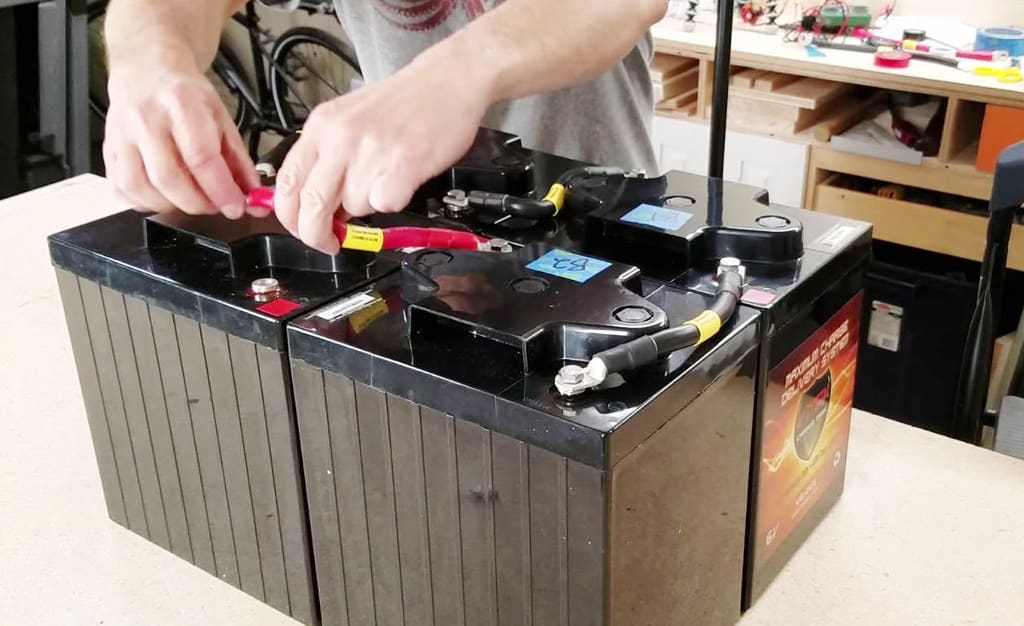
The kit includes a small PV panel, a controller and wiring, so you’ll need to buy an inverter and battery separately if you want AC power or backup power.
Best of all, the kit is super easy to install. It has pre-drilled holes and is compatible with most mounting brackets and clips.
- Great option for backup power
- Easy to install
- No official IP rating
- Low wattage
What Should Boat Owners Look for When Buying Solar Panels?
Solar panels can be a great option for marine use, but not all panels and solar kits are suitable for use around water. Additionally, the panel you choose needs to be selected based on how you want to use your solar power system.
In the sections below, we’ll include a few key things you’ll want to consider when choosing a solar module for your boat.
Energy Needs
One of the first things we recommend thinking about is how much energy you need your panels to generate. This will help guide you to what size panel and how much energy output you need.
If you’re just looking for reliable backup power for your boat’s internal 12-volt battery, or you want your panels to provide power for emergencies only, you’ll probably only need a panel of around 20 watts.
If you use your boat frequently for entertaining guests, or you spend days at a time on your boat, you might want something above 100 watts to provide backup power plus electricity for electric coolers, water heaters and more. Consider everything you’ll use your solar array for and size your system accordingly.
The chart below provides a quick breakdown of what size solar panels you need for different purposes on a boat.
If you plan on using your panels to replace an on-board generator, you can calculate how much electricity your boat uses and then size your system accordingly. It’s always advisable to go a little bigger than you think you need, as cloud coverage and the angle of the sunlight hitting your panels can cause fluctuations in solar power production.
If you have high energy needs, we also recommend considering a Maximum Power Point Tracker (MPPT) controller, which is more efficient than a Pulse Width Modulation (PWM) controller, which is more common.
Space Available for Installation
Just like residential solar systems are limited by available roof square footage, marine solar systems are limited by the available space for installation. This is an important consideration to make to ensure you don’t buy a panel that you won’t be able to mount or use in your vessel.
Before you buy any equipment, we recommend checking the measurements of the panel and deciding where on your boat you can install it. Some portable, foldable panels come with kickstands for temporary setups, but the smaller of our top picks can be set up just about anywhere without mounting brackets as well.
Type of Solar Panel
You’ll have a few choices for the type of panel you purchase for your boat as well.
First, you’ll need to decide between thin-film solar panels, polycrystalline solar panels and monocrystalline solar panels.
- Monocrystalline panels are the most efficient, so they’re the best suited for use on boats. The higher efficiency ratings will let you produce more energy per square foot, which is essential on a boat where space is limited. All of our recommendations above are monocrystalline.
- Polycrystalline solar panels can also work, but they won’t provide as much solar power.
- Thin-film panels are the most affordable, but they generate even less electricity and aren’t ideal for use where available space is minimal.
Second, you should think about whether you want a rigid solar panel with an aluminum frame or a semi-flexible one. Flexible panels contain special solar cells that can be a bit pricier, but they’re easier to install and are a bit more versatile. They can be mounted on curved surfaces, giving you more placement options.
Waterproof Rating
Since you’ll be using your panels on the water, it’s essential that you choose one with a good waterproof rating. Some of the best options are IP67 and IP65. These will ensure your panels and charge controllers or regulators remain safe and at low risk of fire even when exposed to moisture and direct water contact.
Accessories
Finally, you should consider what your kit comes with. Some come with only panels, so you’ll need to buy a controller, an inverter and a battery to complete your setup. Some come with a combination of these parts, although batteries and inverters aren’t commonly included. Some panels also include mounting brackets, although this is also uncommon.
Thinking about the additional equipment you’ll need to purchase after buying your panels will help you budget more effectively for your entire system.
How Do Solar Panels Work With Boats?
PV panels for boats work just like panels for residential use — they collect sunlight and route the energy either to a storage or use system.
Since boat solar systems are entirely off-grid, most require the following:
- Solar panels
- A charge controller
- An inverter
- Mounting brackets or other mounting hardware
- A backup battery for energy storage
We’ll explain what each of these components does in the section below, and then we’ll get into how to set up and maintain your system.
Equipment for a Marine Solar System
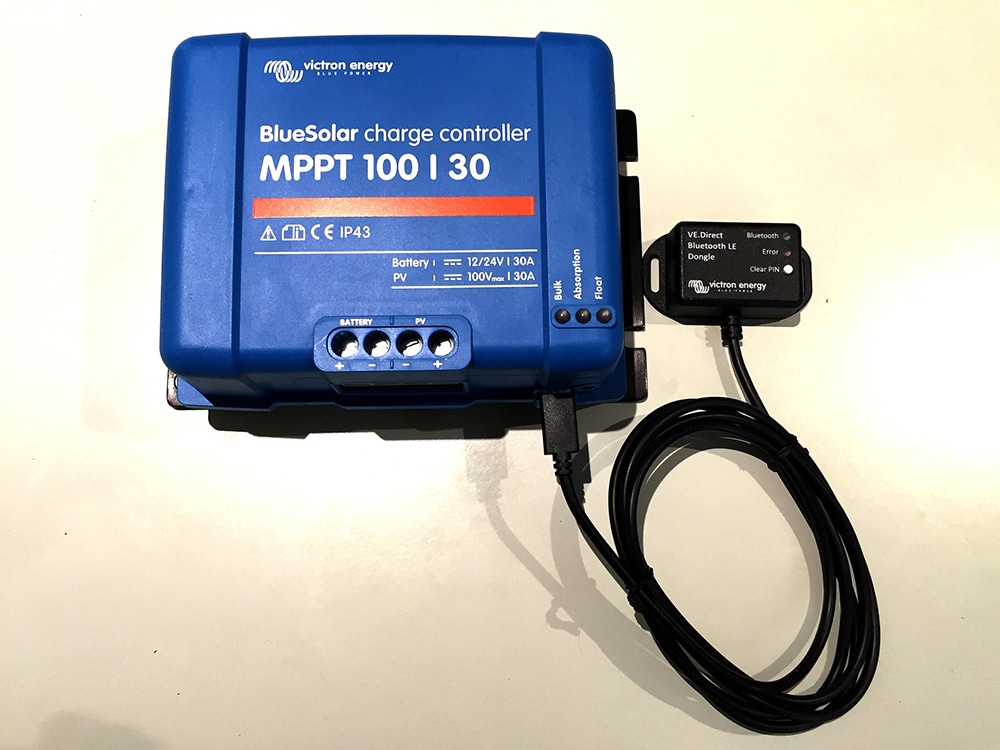
The main components you’ll absolutely need for your boat solar system are PV panels and a controller. If you plan to store energy or use it to charge common electronics, you’ll also need a battery and an inverter.
The panels are the pieces of the system that collect energy from the sun. The electricity generated is then passed to your controller, which limits the amount of power that flows through the wires to your battery or device.
The charge controller helps prevent overcharging batteries or electronics when production is high, and it also prevents battery drainage when production is low. Some panels are equipped with bypass diodes to provide the same safety features.
The solar energy that’s collected is direct current (DC), while most electronics, including standard light fixtures, use alternating current (AC) power. An inverter is used to convert DC current to AC so that you can use your solar power to power devices directly. If you don’t have DC lights in your boat, for example, an inverter might be necessary to provide lighting.
A battery storage system is exactly what it sounds like: it’s a battery bank that stores solar energy for later use.
Solar batteries are useful for two main reasons on boats.
- First, if you ever experience cloudy days, your solar production might very well drop below what you need to provide power to your devices. In that case, having a battery to pull stored energy from can be helpful in maintaining charging capability or electricity.
- Additionally, a battery on board can be useful for maintaining backup power for emergencies. If your boat’s built-in battery ever fails or you need to charge emergency communication or navigation devices, a battery will come in handy.
Installation
Since you want your solar panels to be exposed to as much sun as possible, it’s best to install them at or near the highest point on your boat — often the bimini. This will prevent them from getting shade from other parts of your boat during the day, regardless of which direction your vessel is moving.
It’s also typically best to install your panels as close to parallel with the surface of the earth as possible. Since your boat will be moving around a lot, it’s not realistic to install them facing the path of the sun in the sky as you would on a home. Laying them flat gives you the best chance of always collecting at least some sunlight.
You, of course, need to consider available space as well, so remember to take measurements of your installation site and compare them to your panels before beginning the process.
Finally, you should consider where your batteries will be — if applicable — and where your wiring will run once your installation is complete. Keeping these things in mind will help ensure that the installation process goes as smoothly as possible.
Below, we’ll include a brief step-by-step guide on how to install a solar system on your boat.
- First, take measurements of where your panels will be installed, the path the wiring will take to all components and where your battery, inverter and controller will be placed. Making sure you have enough room for all of your components will help avoid headaches once you get started.
- We recommend mounting your batteries, inverter and controller first. These are generally the easier components to mount, so they’re the easiest to move once installed.
- Next, mount your panels. The process for this will depend on the panels you choose and where you plan to install them. You should follow the installation instructions for the mounting brackets or hardware you purchase.
- Finally, you can wire your system, beginning with the connection between the panels and the controller and then the connections to the inverter and battery.
- You can test your system by using a voltmeter or by checking to see if your powered devices function as intended. Some controllers will also show you if your panels are providing energy and how much they’re producing.
For more guidance and information on how to set up your boat solar system, you can check out the video below:
Maintenance
Thankfully, solar systems are relatively maintenance-free once installed, although you should carry out routine system checks and cleaning to ensure you continue to enjoy maximum safety and energy production.
You should spray down your panels with water about once every six months to get any accumulation of dirt or salt off of them. This will help maximize energy generation. Around the same time, you should also check the wires and connectors for corrosion, which is more likely to occur if you use your boat in saltwater.
After major storms, it’s a good idea to ensure that none of the connections between components were lost. A simple disconnect could lead to your battery charging issues, which could be an issue if you ever need backup power.
Lastly, it’s worth mentioning that solar systems on boats are generally considered safe. There is a small risk of fire but provided you carry out the proper maintenance, you should avoid any serious issues.
Are Marine Solar Panels Worth It?
The answer to this question really depends on who you ask. For some boat owners, PV panels are essential. Not only can they provide backup power for emergencies, but they can also improve your quality of life at sea and the enjoyment of your boat.
For many people, these things are indispensable, so solar systems are well worth the investment. For certain types of boats — like small fishing boats and sailboats — solar panels will be the only source of electricity.
Other boat owners feel comfortable relying on generators if they have them, and some use their boats only for short durations, which makes having an on-board solar array less valuable.
For most people, though, having at least a small solar system to provide backup power for emergencies is worthwhile. From there, opting to up the size of your system to improve your time at sea isn’t hard to get behind.
FAQ: Marine Solar Panels
Below, we’ll answer a few of the most common questions we get about solar panel systems made for boats.
What are the best marine solar panels?
In our opinion, the best solar panels for boat use are the SunPower 170W solar panels. These are flexible panels that allow for easy and versatile installation.
They are some of the most efficient panels suitable for boat use, and they provide an incredible 170 watts each. This is enough power for just about anything you need electricity for on your boat and for emergency equipment in low-light conditions.
These panels are a bit expensive, and they don’t come with any additional equipment. However, the junction boxes have a waterproof rating of IP67, come with a five-year warranty for equipment and high efficiency and are made from high-quality, durable materials for years of use.
Will solar panels keep my boat battery charged?
Yes, solar panels can be hooked up to keep your boat’s 12 volt battery charged. However, you need to make sure you install a system that is sized appropriately for your boat’s needs.
You can check how much power your boat draws from its battery system by looking at the loads (in amps or watts) of each device. You can also use your battery monitor if you have one to check the energy demand of each individual component pulling power. Then, choose solar panels that produce a bit more energy than your system needs.
If you live in an area that experiences a lot of cloudy weather, you might want to size up your system even more to ensure your system generates enough electricity.
How much does it cost to put solar panels on a boat?
The cost to install a solar array on your boat can range from around $150 up to well over $1,000. Where in this range your total falls depends primarily on how much energy you need to produce.
If you’re looking for portable solar panels to take on and off a small boat with you for emergency use only — which is typical for sailboats and smaller boats that don’t normally have electricity — you’ll likely be looking at the $150 end of the spectrum.
If you have a much larger boat and want to be able to maintain power for your essential equipment and some non-essentials, then you’ll likely push your all-in cost closer to the higher end of the range.
What are the benefits of solar panels on boats?
Installing solar panels on your boat can provide quite a few key benefits, although the perks you’ll actually experience depend on your situation and your specific boat.
Perhaps most importantly, solar panels can charge your boat’s battery and maintain electricity for emergencies. Most systems — even small ones — can serve to charge your phone, GPS or other emergency devices in case you run into problems out on the water.
Larger systems can also provide power for recreational use, like charging phones, powering speaker systems, keeping beer cold and more.

Related articles
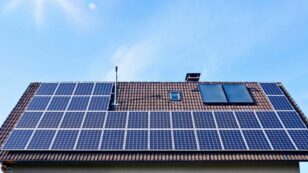
Calculate Your Solar Panel Payback Period (How Long To Recoup Costs?)

Solar Panel Cost In 2024 (Homeowner’s Installation Savings Guide)
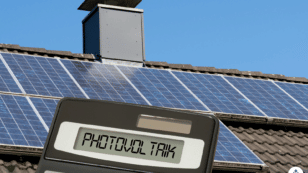
Solar Calculator
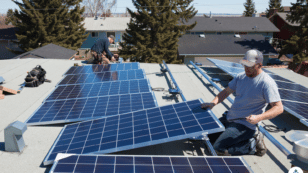
Top 6 Best Solar Companies Review
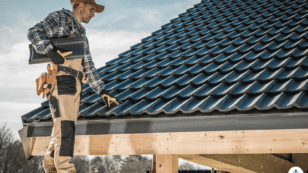
Solar Roof Shingles 2024 Cost and Buying Guide
Related Solar Panel Guides
- Buyer’s Guide: Best Solar Panels for Camping (2022)
- 7 Best Solar Panels for Mobile Homes (2022 Guide)
- What Are the Best Solar Panels for Farming Solar for Agriculture Guide (2022)
- The Best Solar Panels for Portable Solar Generators
- 5 Best Flexible Solar Panels (2022 Reviews and Buyer’s Guide)
Comparing authorized solar partners
Having trouble deciding? Click below and use our process to receive multiple quotes instead:
- Solar accessories
- Solar panels for boats: What..
Solar panels for boats: What you need to know
- Share to LinkedIn
- Share to Facebook
- Kerry Thoubboron
As subject matter experts, we provide only objective information. We design every article to provide you with deeply-researched, factual, useful information so that you can make informed home electrification and financial decisions. We have:
Sourced the majority of our data from hundreds of thousands of quotes through our own marketplace.
Incorporated third-party data and information from primary sources, government agencies, educational institutions, peer-reviewed research, or well-researched nonprofit organizations.
Built our own database and rating system for solar equipment, including solar panels, inverters, and batteries.
We won't charge you anything to get quotes through our marketplace. Instead, installers and other service providers pay us a small fee to participate after we vet them for reliability and suitability. To learn more, read about how we make money and our Editorial Guidelines .
)
Owning a boat can be expensive; you have to pay an upfront cost to purchase it, and you'll also have to spend money on maintenance and fuel charges. Solar panels may be the answer if you're looking for a reliable, cost-effective way to power your boat.
- 100% free to use, 100% online
- Access the lowest prices from installers near you
- Unbiased Energy Advisors ready to help
How do solar panels work on boats?
Solar energy systems on boats work similarly to other portable , off-grid systems. There are four important components to a marine solar panel system:
Solar panels
Charge controller
Most marine solar panel systems require charge controllers to prevent the batteries from receiving more voltage than they can handle. Without charge controllers, you risk overcharging and damaging your battery.
Depending on your boat's electrical setup and the appliances you need to power, you may also need an inverter to convert direct current (DC) electricity into alternating current (AC) electricity. Some boat electronics use DC and don't need an inverter. However, if you use everyday household appliances on your boat (i.e., TVs, microwaves, or hairdryers), they likely run on AC electricity, and you'll need an inverter.
You can buy all of these components separately, but you can find solar panel kits that include some or all of the necessary parts. Some marine solar panel kits include the wires, cables, and mounting equipment required to get your boat's solar panel system up and running.
Best solar panel kits for boats
Below are a few products tailored to off-grid marine solar power systems.
Boat solar panel options
If your solar panel kit does not include an inverter or charge controller, you must buy those components separately. Battery storage products occasionally have built-in inverters and/or charge controllers.
Should you install solar panels on your boat?
There are numerous benefits to powering your boat with solar energy. One of the most attractive benefits of marine solar power systems is the monetary savings. You'll need to invest money upfront to purchase solar equipment; however, once it's up and running, you'll generate free electricity for your boat. Alternatives to electrifying your boat, like gasoline-powered generators, require purchasing fuel on an ongoing basis. Switching to solar power can reduce these purchases while protecting you against rising fuel costs.
Another benefit of marine solar panel systems is the quietness of operation. Running a generator can be a noisy disturbance for those going out on the open water to experience nature. Powering your boat with solar allows you to enjoy peace and quiet without losing power.
Furthermore, you can also safely generate electricity and charge your battery with solar power while you're away from your boat. This isn't feasible with generators - running a generator requires manual operation and monitoring. With solar panels, you can produce usable electricity during the day and then use it for weekend boating adventures.
However, there can be obstacles to installing solar on a boat, perhaps the largest of which is available space. Ideally, your solar panels can be installed in an area with uninterrupted sunshine. Depending on your boat type, this space may be easy or difficult to come by. While you likely get a lot of sun out on the water, the area may be too small or have too many obstacles that make fitting the number of solar panels necessary to generate your electricity needs difficult.
Consider your boat's deck or canvas when you're looking for spots to install a marine solar panel system. Remember that the positioning of your solar panels will also impact the type of equipment you should purchase – you may be able to use traditional monocrystalline and polycrystalline solar panels if you're installing on a fixed, rigid section of your boat. However, if your only open space available isn't suitable for fixed mounting, installing lower-efficiency flexible solar panels may be a better option. Some flexible solar options have an adhesive backing, so you won't need to worry about the constraints of traditional mounting and racking materials.

How many solar panels do you need for your boat?
Unsurprisingly, a yacht has very different power requirements than a sailboat. The number of solar panels you'll need for your boat not only depends on the type and size of your boat, but also the quality of the equipment you choose, how many sun-hours the boat sees, and the amount of electricity you require. Some boats can get by with one 100-watt solar panel (or even smaller), while others need a multi-panel setup.
Calculating your electricity load is the first step in determining how many solar panels you need. Below are some common appliances you may use on your boat and what they draw for power.
How many solar panels do you need for common appliances?
The last column of the above table is the amount of energy you'll consume in watt-hours running each appliance for the number of hours identified in column three. One 100-watt solar panel that receives direct sunlight for 5 hours will produce approximately 500 Wh of electricity (5 hours x 100 W = 500 Wh). Not considering conversion losses, that's enough electricity to power a mini-fridge for 24 hours or power a boat's GPS display for 10 hours. Running all of the appliances above for everyday use will require multiple 100-watt solar panels or fewer higher-wattage panels.
Install solar to save on electric bills
You can save money by installing a marine solar panel system, but you'll save even more by installing solar on your home or business. If you want to evaluate your solar options, check out the EnergySage Solar Marketplace . You can receive up to seven custom solar quotes from local installers to compare. You can also try our solar calculator for a quick estimate of solar costs and savings on your property.
Create your own clean energy with solar panels.
Enjoy the benefits of solar without rooftop panels.
Explore heat pumps, the latest in clean heating & cooling technology.
See solar prices near you.
Enter your zip code to find out what typical solar installations cost in your neighborhood.
- Our offerings
- Community solar
- Heating & cooling
- Backup power
- EV charging
- For your business
- Other energy options
- Solar calculator
- Solar rebates
- Help center
- Home solar guide
- Market intel
- Refer a friend
- Mission & values
- How it works
- Editorial guidelines
- Work with us
- Solar & HVAC installers
- Corporate partnerships
- Community programs
- Utility programs
ENERGYSAGE is a registered trademark and the EnergySage logo is a trademark of EnergySage, Inc. Other trademarks are the property of either EnergySage, Inc. or our licensors and are used with permission.
© Copyright 2009-2024 EnergySage, Inc. All rights reserved.
Learn more about our success working with the U.S. Department of Energy.
You are using an outdated browser. Please upgrade your browser or activate Google Chrome Frame to improve your experience.
- Commercial & industrial PV
- Grids & integration
- Residential PV
- Utility scale PV
- Energy storage
- Balance of systems
- Modules & upstream manufacturing
- Opinion & analysis
- Opinion & analysis guidelines
- Press Releases
- Technology and R&D
- Sustainability
- 50 States of Solar
- pv magazine UP initiative
- pv magazine Hydrogen Hub
- Magazine features
- US module maker directory
- pv magazine Roundtables & Insights
- pv magazine Webinars
- Event calendar
- Past events
- Special Edition Las Vegas 2023
- OMCO Solar white paper
- Print archive
- pv magazine test
- pv magazine team
- Newsletter subscription
- Magazine subscription
- Community standards
This yacht sets sail with solar
The 60 square meters of solar panels produces 30-50 kWh of energy per day, enough to power all of the onboard electronic equipment for around seven hours.
- Commercial & Industrial PV
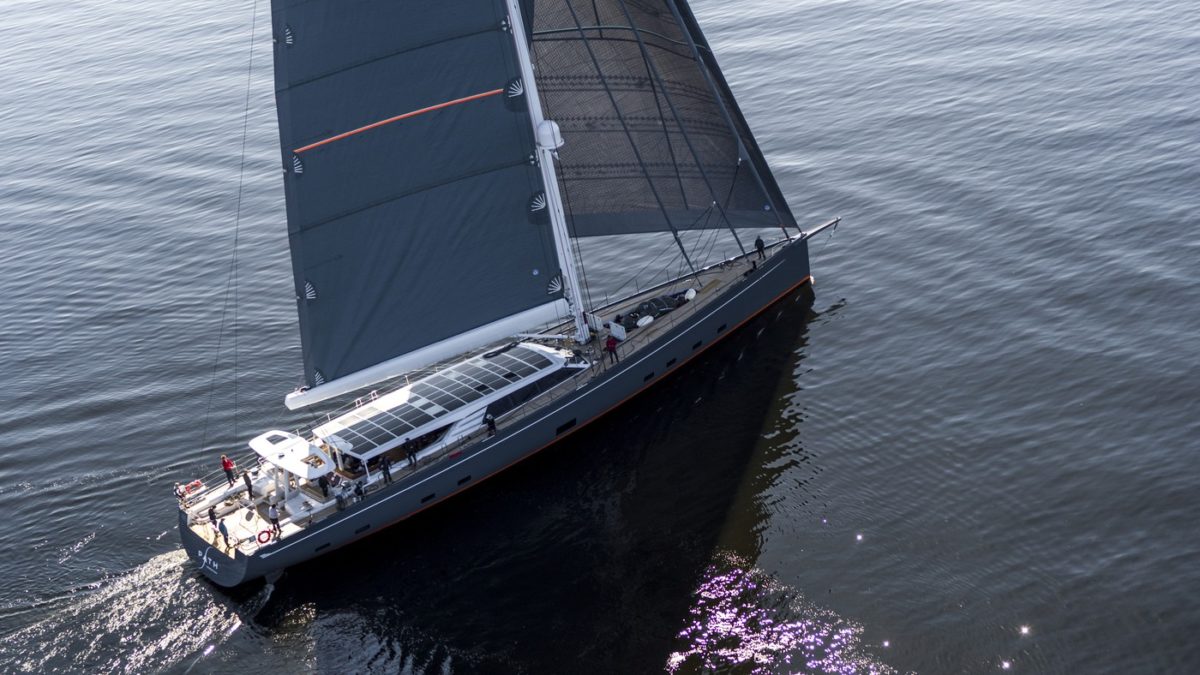
Solar-powered Baltic yacht.
Image: Solbian Solar
Baltic Yachts began delivery in July of its Baltic 146 Path, which includes an 8,714 watt solar rooftop and energy storage system designed by Solbian Solar using the company’s walkable solar modules.
Recently, some of the yacht’s technical work has been shared online. Built from 1,742 monocrystalline solar cells, many of the 86 solar panels were custom cut to fit the deck’s shape by the Solibian team in Italy. The units were based on the company’s Super Rugged (SR) Series .
The SR series has solar cell busbar technology developed by Merlin Solar. In one video, the Merlin team drives over the solar panel, throws bags of cement on it, and even shoots it with a bow and arrow in an effort to prove the product’s resilience. The company said its busbar technology makes this kind of abuse possible.
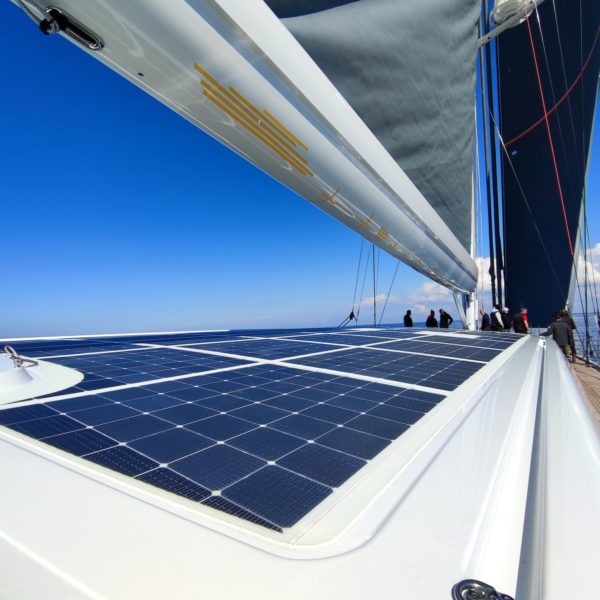
The 60 square meters of solar panels produces 30-50 kWh of energy per day. The company said that’s enough to power all of the onboard electronic equipment–including navigation, autopilot, lighting, and entertainment–for around seven hours.
Once the sun goes down, a Mastervolt MLI 44kWh LiFePO4 battery pack allows the diesel generator mostly to stay off, providing generally silent operation for 14-18 hours.
Baltic Yacht’s solar system is roughly half the size of the Silent 60’s 16.8 kWdc solar plus storage system. The Silent 60 is a solar-propelled yacht less than half the lengthBaltic yacht and price, which reaches 6-8 knots on solar power alone. The Path does not feature electric propulsion and therefore relies on diesel engines when the wind dies down.
Since the Path uses a sail for propulsion, the team installed 154 bypass diodes and 12 solar panel strings and trackers – Mastervolt SCM-60 MPPTS – in an effort to maximize power output and minimize the effect of the sail’s shadows on the panels. The entire solar system, including wiring, controllers and small parts, weighs less than 300kg, the company said
The 146 Path has an overall length of 146 feet. The yacht can accommodate eight in addition to the ship’s owner, as well as eight crew members. Path carries two tenders, an 8hp Torqeedo electric outboard-powered RIB, and a 6.5m twin-engined RibEye. There are also two ultra-lightweight Reverso Match sailing dinghies.
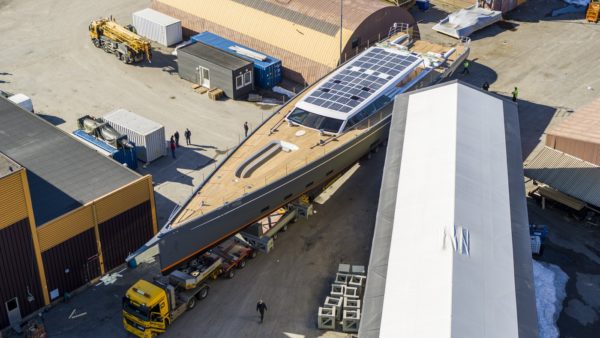
When the front tender is deployed, its storage container can be turned into a pool.
The ship’s main diesel engine is a 405kW (550hp), six-cylinder Scania. The specific model isn’t listed, however the “ DI13 092M IMO Tier III, EU Stage IIIA ” lines up with all of the stats and looks like the unit in a video of the engine being installed.
The owner’s suite includes a sleeping cabin, and an en suite lounge with a glass divider doubling as a movie, tv, and sailing information screen. An upper lounge features a 2.7m-long video wall.
This content is protected by copyright and may not be reused. If you want to cooperate with us and would like to reuse some of our content, please contact: editors@pv-magazine.com .
John Fitzgerald Weaver

More articles from John Fitzgerald Weaver
People on the Move: ACORE, Sunnova Energy, Lighthouse bp, and more
Sandia offers public access to csp archives, related content, elsewhere on pv magazine....
Since it is E propulsion all they have to do to change while sailing is use the motor in regen it’ll generate power back into the pack at much larger amounts. And a small RE fueled generator just in case. As a sailor who does solar, not a chance it’ll get that much from the solar from all the shading from the rigging. More likely 10-30kwh/day. On mine, I made the sails small with 2 masts so I can lower them to not shade the panels.
Any photos of your boat you can share?
Leave a Reply Cancel reply
Please be mindful of our community standards .
Your email address will not be published. Required fields are marked *
Save my name, email, and website in this browser for the next time I comment.
Notify me of follow-up comments by email.
Notify me of new posts by email.
By submitting this form you agree to pv magazine using your data for the purposes of publishing your comment.
Your personal data will only be disclosed or otherwise transmitted to third parties for the purposes of spam filtering or if this is necessary for technical maintenance of the website. Any other transfer to third parties will not take place unless this is justified on the basis of applicable data protection regulations or if pv magazine is legally obliged to do so.
You may revoke this consent at any time with effect for the future, in which case your personal data will be deleted immediately. Otherwise, your data will be deleted if pv magazine has processed your request or the purpose of data storage is fulfilled.
Further information on data privacy can be found in our Data Protection Policy .
pv magazine USA offers daily updates of the latest photovoltaics news. We also offer comprehensive global coverage of the most important solar markets worldwide. Select one or more editions for targeted, up to date information delivered straight to your inbox.
- Select Edition(s) * Hold Ctrl or Cmd to select multiple editions. Tap to select multiple editions. U.S. (English, daily) Global (English, daily) Germany (German, daily) Australia (English, daily) China (Chinese, weekly) India (English, daily) Latin America (Spanish, daily) Brazil (Portuguese, daily) Mexico (Spanish, daily) Spain (Spanish, daily) France (French, daily) Italy (Italian, daily)
- Read our Data Protection Policy .
Subscribe to our global magazine

Most popular
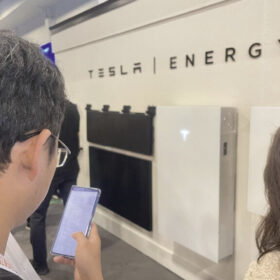
Keep up to date
FEATURED PRODUCT - MADE IN THE USA ULTRA HIGH EFFICIENCY BI-FACIAL RIGID PANEL KITS
(800) 788-2322 [email protected]

- SUNPOWER Semi-Flex Kits
- RIGID Mono Kits
- Marine Solar Panels
- Portable / USB Chargers
- Controllers & Accessories
- Inverters / Chargers
- Lithium and AGM Batteries
- Customer Testimonials
- Customer Installations
- Manuals & Specifications
- Owner's Blog
outstanding customer service and unbeatable prices
Customer Reviews

Marina, Dealer, and Consumer Services member
All installations are done by our highly skilled abyc certified technicians.

Imagine the freedom of endless power
Chris purchas - founder and managing director.
Chris has always been an early adopter of technology and thought it would be amazing to be able to spend endless days out on the water without having to run the generator. Being on a boat at anchor is a place to relax and unwind, that loud reverberating noise from the generator just crushed the mood.
Marine Solar Innovations Inc. was created offering innovative high quality products, competitive pricing and better service than any other enterprise in this area. Our company goal is to offer the boating and RV community "Outstanding Customer Service and Unbeatable Pricing" .
Direct Contact:
1-800-788-2322 EXT 700
Luc Dubeau - Marine Systems Specialist
Luc performs a vital role at MSI in the capacity of our Marine Systems Specialist. He is an ABYC certified technician , he has substantial knowledge and experience with Victron Energy systems and has completed numerous marine electrical installations within Southern Ontario. He is an avid boater with vast experience in marine electrical systems and provides training and support to our dealer network and marina partners. Our company goal is to offer the boating and RV community "Outstanding Customer Service and Unbeatable Pricing" .
1-800-788-2322 EXT 701
about our products
How does a solar charging system work.
- A solar charging system works exactly the same as your on-board house battery charging system. The big difference is that the solar battery charger is powered by the sun instead of shore power or a generator.
- The solar charge controller is a full multi-stage battery charger that provides a bulk, absorb and float charge cycles, keeping your onboard battery bank in tip-top condition when you're away from shore power.
- Depending on the configuration, a solar charging system can provide between 6 to 50 amps of power, all harnessed from the solar panels installed on your boat. This charging power replenishes the energy drained by fridges, lights, stereos, inverter loads, wash-down pumps etc. This natural charging cycle means that your battery bank is never depleted, you can stay on your boat away from shore power for indefinite periods of time, using all of your on-board electronics freely without worrying about battery drain.
- A Solar Charging System will significantly extend the life of your battery bank as it virtually eliminates the risk of detrimental deep discharges and keeps the charging cycles within the optimum ranges.
- Best of all, it's noise and pollution free !
What are Inverters or Inverter/Chargers?
- Most boats have a stock DC system which supplies power at anchor from a dedicated house battery bank. A DC power system can supply energy to operate lights, refrigeration, navigational instruments, water pumps etc.
- An inverter is a device that simply converts DC power to AC allowing you to operate larger higher power devices such as laptop computers, televisions, coffee makers, microwave ovens, toasters, blenders etc.
- Without and inverter, these AC devices require you start up the generator, if your vessel is equipped with one. The inverter affords you the ability to operate these AC devices directly from your DC battery bank. When mated with a solar charging system, the power used by the inverter is easily replenished by the solar giving you virtually limitless power. Many of our customers really appreciate the ability to make coffee in the morning and watch TV at night without running the generator.
- Keep in mind that generally speaking, you cannot operate air conditioners, water heaters, or other devices that have super high current loads.
- An inverter/charger is a very popular option as it combines an inverter with a high powered charger. This allows you to quickly recharge your battery bank when connected to shore power or operating your generator.
What are Battery Monitor Kits?
- Battery Monitor Kits are super easy to install and provide a ton of functionality at a very reasonable price. They are programmed with your battery bank specifications and using that information, they calculate and display a realtime state of charge and current flow.
- These are especially useful when a solar charging system is installed as the battery voltage is no longer an accurate measure of the battery's state of charge. When a solar charging system is charging, the battery voltage is inflated, giving the user a false nexus to the actual state of charge. A battery monitor will always provide an accurate state of charge reading even when the solar is charging the battery.
- Battery Monitor Kits can also be programmed to notify you if your house or starting battery falls below a pre-defined threshold. This provides for a stress free boating experience.
- We offer two versions of battery monitor kits. The Victron BMV-712 displays it's data on a physical screen and via bluetooth. The Victron Smart Shunt displays it's data via bluetooth only. Both are equally reliable and offer the same functionality, one has the additional option of a physical screen.
How do our innovative products differ from the competition?
- We are boaters, all of our systems are designed and engineered for the marine environment. All components are rigorously tested to ensure 100% compatibility . We use our solar systems every weekend and we are continuously conducting research and development on how to improve the operation and efficiency to offer our customers the best possible experience.
- Customer service is our #1 priority. We encourage our customers to do their due diligence and research. Our customer testimonial page provides numerous examples of what our customers have to say about our reputation within the boating community.
- We offer the largest selection of solar panel kits and marine installation options in the industry. From portable systems to fixed permanent installations, we have a solution for every boating application.
- Authorized dealers for major industry brands such as Sunpower USA, Victron Energy, Solbian, Battleborn, Volthium and EPEVER , we offer our customers a comprehensive solution for every application.
- Our semi-flexible panels are of the highest quality, manufactured in a state of the art ISO9001 facility. We use only SunPower USA Premium Quality solar cells providing you with the most efficient performance. Be careful of panels purchased on eBay or Amazon, they use low grade cells which are discounted due to cracks and imperfections. Although the panels look similar, the cells are much less efficient resulting in very poor performance.
- All of our solar panels are tested at the factory and our customers receive I-V Curve and EL reports detailing the performance of the specific panels they purchase.
- Don't be fooled by creative cosmetic finishes and other gimmicks designed to disguise sub-standard build quality and internal components. All premium quality solar panels will utilize Ultra High Efficiency SUNPOWER cells backed by a solid warranty that gives the customer the assurance that they are purchasing a premium quality product
- We offer the full line of Victron Energy products which provide a comprehensive ecosystem of devices that share data, interfacing with striking visual displays and remote monitoring options.
2024 BOAT SHOW Featured Products
We use only premium quality cells in our panels, dock link members receive an exclusive discount ask us for details, browse our marine solar kits, we look forward to hearing from you, marine solar innovations inc..
(800) 788-2322
Drop us a line!
This site is protected by reCAPTCHA and the Google Privacy Policy and Terms of Service apply.
Copyright © 2018 Marine Solar Innovations Inc.
Designed by MSI Web Development Team
- Privacy Policy
- Terms and Conditions

- Gear Directory
- Multihull Sailor
- Boats for Sale
- Real Estate
- Maintenance & Hardware
- Water Sports
The Best Solar Panels for Boats of 2024
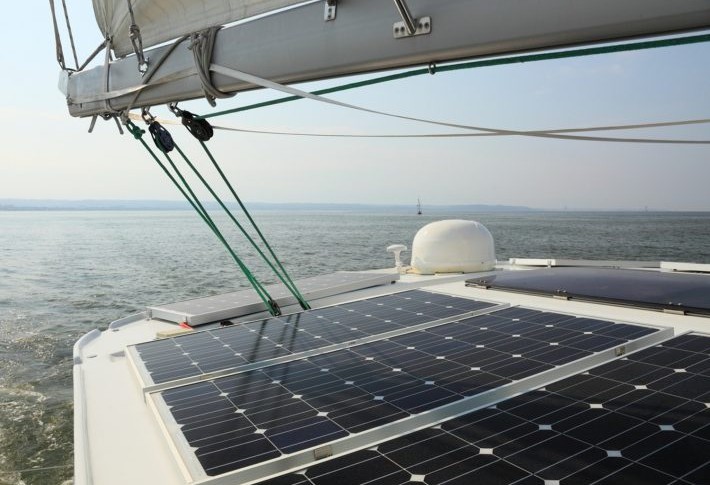
Solar panels are a great way to give your boat energy and power. If you like taking long rides on motorized watercraft, having solar panels can reduce your energy costs. They also make sure that the boat is efficient and never runs out of power in an emergency. There are multiple options for solar panels available, which can make the market search even more confusing. To help you find a suitable pick, we have shortlisted and keenly reviewed our favorite solar panels for boats in 2024.
A top-quality product not only lasts long but also delivers efficient results. This is why it is essential to invest your money in high-end solar panels. All our products are selected based on their overall performance and ability to deliver high-end results.
Our Top Picks
- Best Overall: Renogy Solar Panels for Boats Shop Now ➔
- Most Lightweight Design: Rophie Solar Panels for Boats Shop Now ➔
- Premium Kit: TopSolar Solar Panels for Boats Shop Now ➔
- Best Backup Kit: ECO-WORTHY Solar Panels for Boats Shop Now ➔
- Simple Installation: Sunway Solar Panels for Boats Shop Now ➔
- Premier Foldable Panel: EF ECOFLOW Solar Panels for Boats Shop Now ➔
- 1 What to Consider When Buying Solar Panels?
- 2 Size
- 3 Type
- 4 Accessories
- 5 How Do Solar Panels for Boats Work?
- 6 Installation
- 7 What Are Care Requirements to Enhance the Life of Solar Panels for Boats?
- 9 Cleaning
- 10 What Are the Properties of Charge Controllers for Solar Panels for Boats?
- 11 Basic charge controllers
- 12 Mid-range charge controllers
- 13 Max power charge controllers
- 14 Conclusion
Can solar panels for boats run a trolling boat motor?
How long does it take for a solar panel to charge your boat’s battery, why do people consider installing solar panels for boats, the best solar panels for boats, best overall.
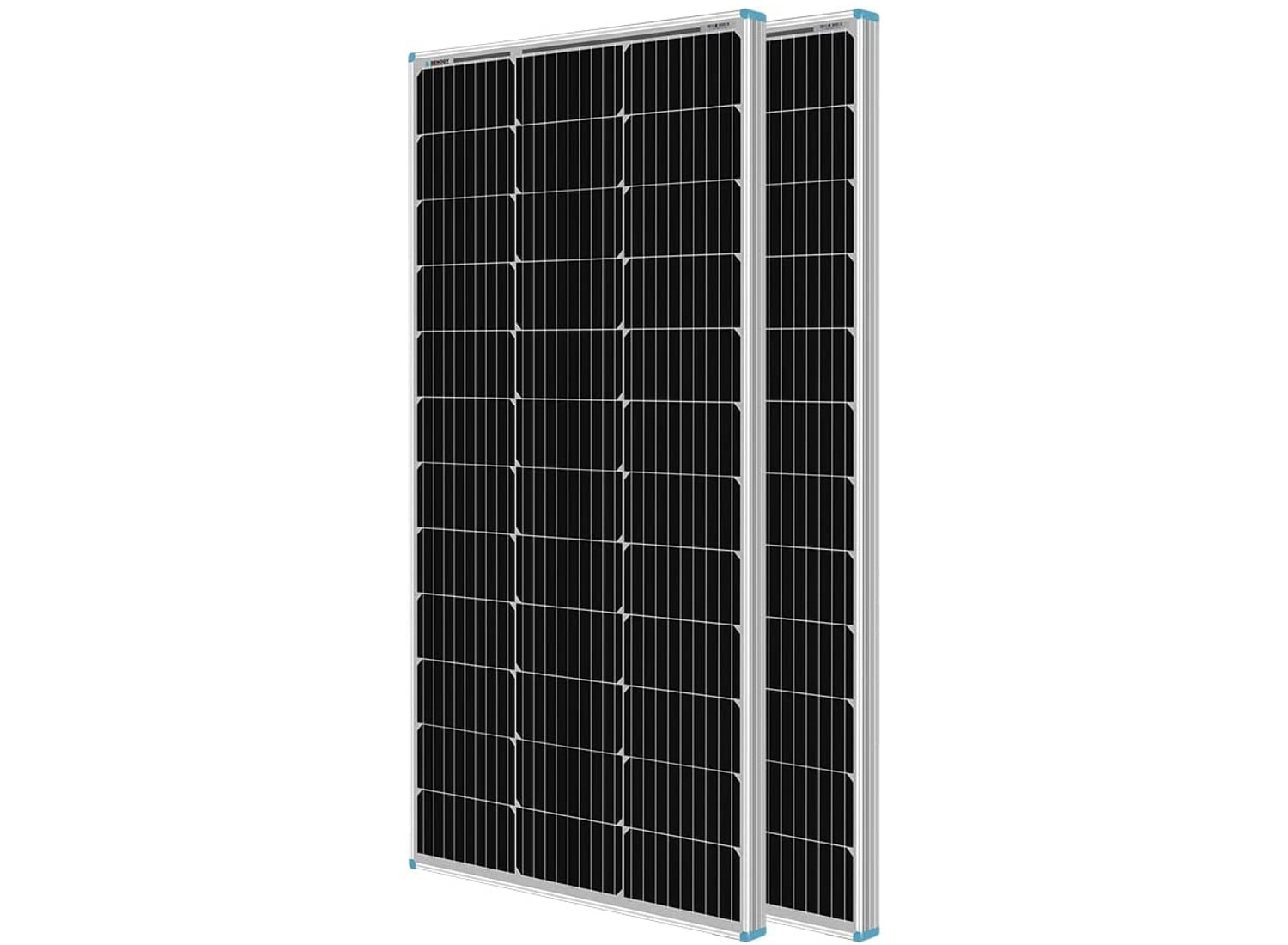
Renogy Solar Panels for Boats
The Renogy are 100W monocrystalline solar panels providing an average of 400-500Wh or 33-41Ah of electricity per day, so you have reliable performance. It has bypass diodes that protect the solar cells from overheating, so you don’t have to worry about maintenance. In addition, it features a corrosion-resistant aluminum train providing extended outdoor use without any extra damage.
These solar panels come with pre-drilled holes on the back so that you can install and mount them without spending money on professional help. They measure 42.2 x 19.6 x 1.38 inches and weigh 14.3 pounds, making them lightweight and convenient. Moreover, you can install them on boats, rooftops, cabins, and more for multifunctional use. Because of their efficiency and reliability, these solar panels stand at the top of our list.
- They are weather-resistant
- These solar panels maintain cell temperature
- Provide reliable performance
- Only compatible with Renogy ground mounts and brackets
Most Lightweight Design
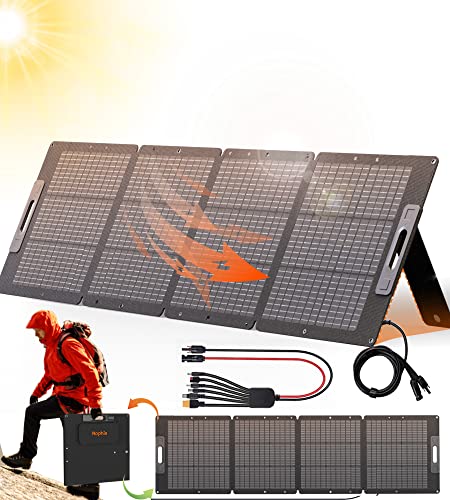
Rophie Solar Panels for Boats
The Rophie Solar Panels easily stands out on this list. Designed with impeccable efficiency, they accelerate solar charging to the next level, making it ideal for outdoor enthusiasts and off-grid boat owners. These solar panels convert sunlight into power rapidly, while their ultra-light, foldable design ensures convenience during transport and installation. Don’t let their light weight fool you, though, as they pack an impressive 200 watts, delivering unmatched power performance for your boat or outdoor camping.
These panels don’t just excel in efficiency and power; they’re also built to endure. Their IP67 waterproof grading ensures that they remain operational even under challenging weather conditions. Their high-quality MC-4 connectors further optimize power transfer while ensuring safe and secure connections. Plus, their compact design won’t take up much space, proving to be the optimal choice for boat owners who value both power and convenience.
- Lightweight and easily transportable
- Durable and water-resistant
- High-performance with 200W
- Can be a little pricey
Premium Kit
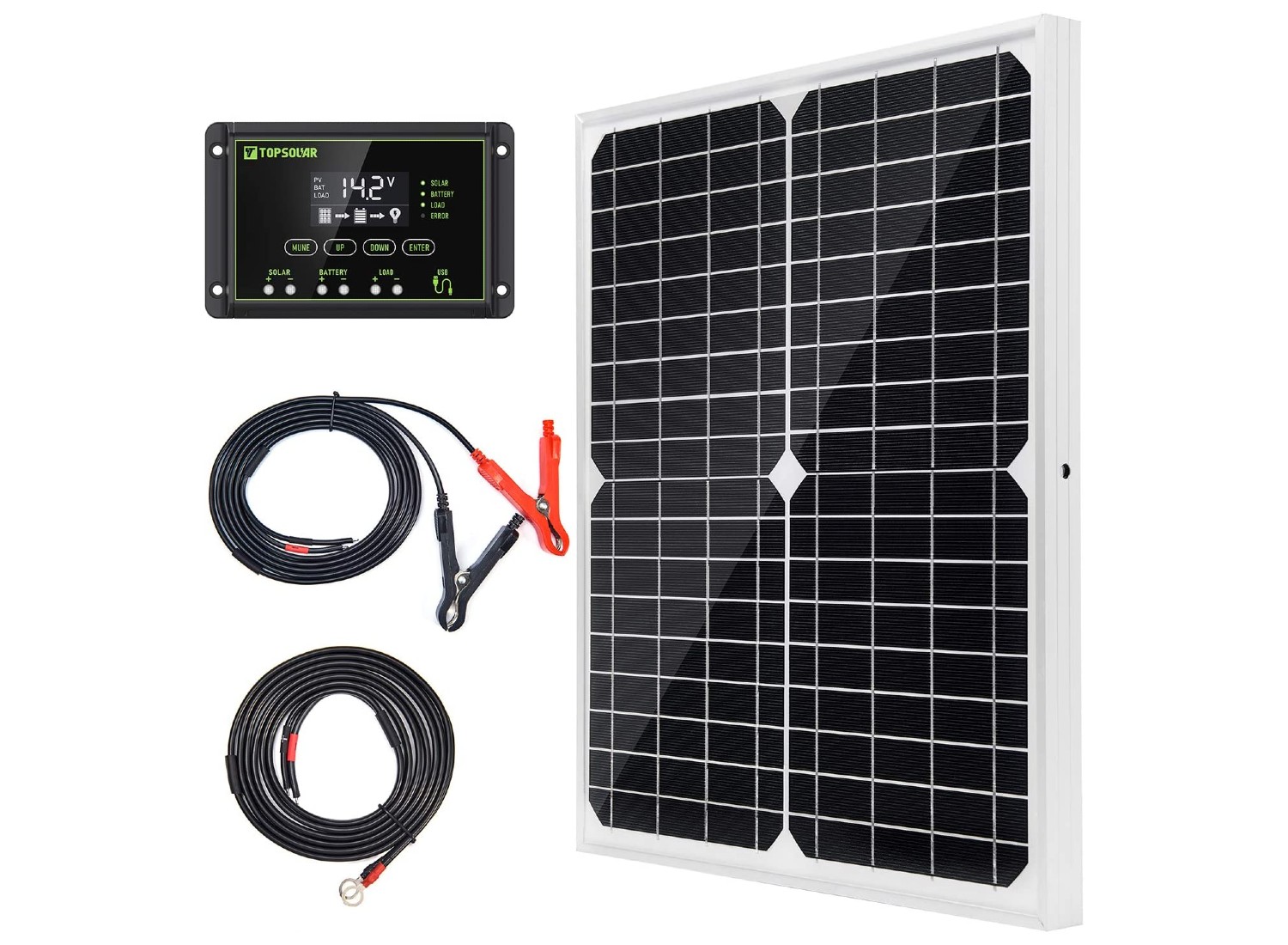
TopSolar Solar Panels for Boats
The TopSolar Solar Panels are available in a kit containing 20W solar panels, a solar charger regulator of 12V/24V, two 6.5-foot cables with alligator clips, and an O-ring terminal to have a complete experience while on the go. They are perfect for off-grid 12-volt battery charging systems providing you with various DC applications like cabins, boats, battery-operated gates, and more. They come with a 10A solar charger controller preventing the battery from overcharging, discharging, and risk of short circuit for a safe experience.
These solar panels have aluminum and tempered glass frames, ensuring a durable and weather-resistant use. Weighing 2.75 pounds and measuring 2.32 x 13.86 x 17.13 inches, they are compact and portable.
- Easy to store and carry
- They come in a complete kit
- Provide excellent weather resistance
- Not suitable for large areas and machinery
Best Backup Kit
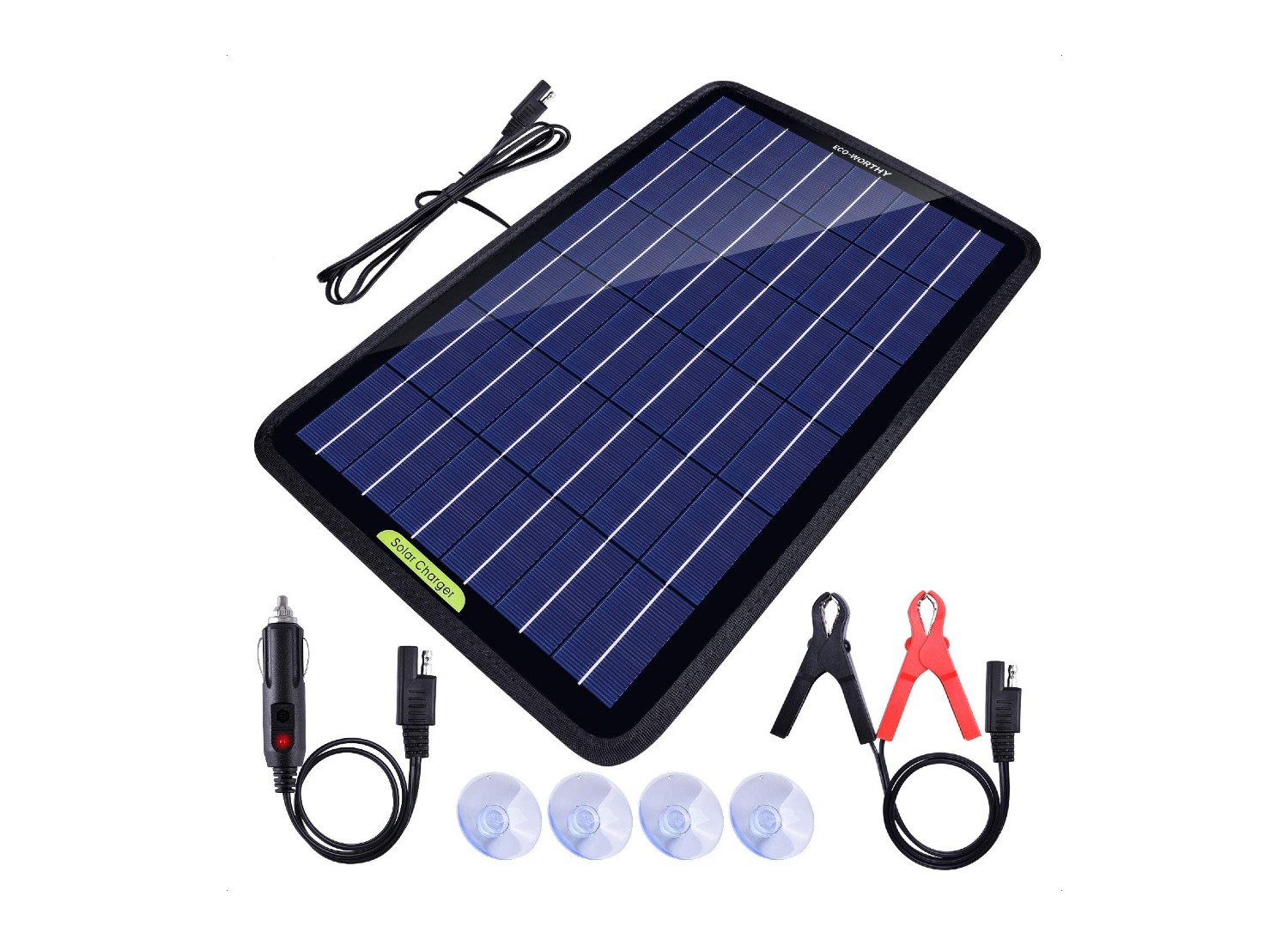
ECO-WORTHY Solar Panels for Boats
The Eco-Worthy Solar Panels are 10W 12V solar car battery chargers that can be used to recharge boats, motorcycles, boats, snowmobiles, and tractors. They feature a cigarette plug option supplying you with constant power when needed. This kit includes a cigarette lighter adapter, one pair of battery clips, and four-piece PVC suckers ensuring maximum results in no time.
They also have energy-saving, built-in blocking diodes that prevent reverse discharge from maintaining and extending battery life for maximum durability. It measures 1.4 x 9.6 x 15.3 inches and weighs only 1.5 pounds, so you have a compact product at hand
- They are available in a complete kit
- These panels are lightweight and compact
- They can recharge different types of vehicles
- Only designed for vehicles
Simple Installation
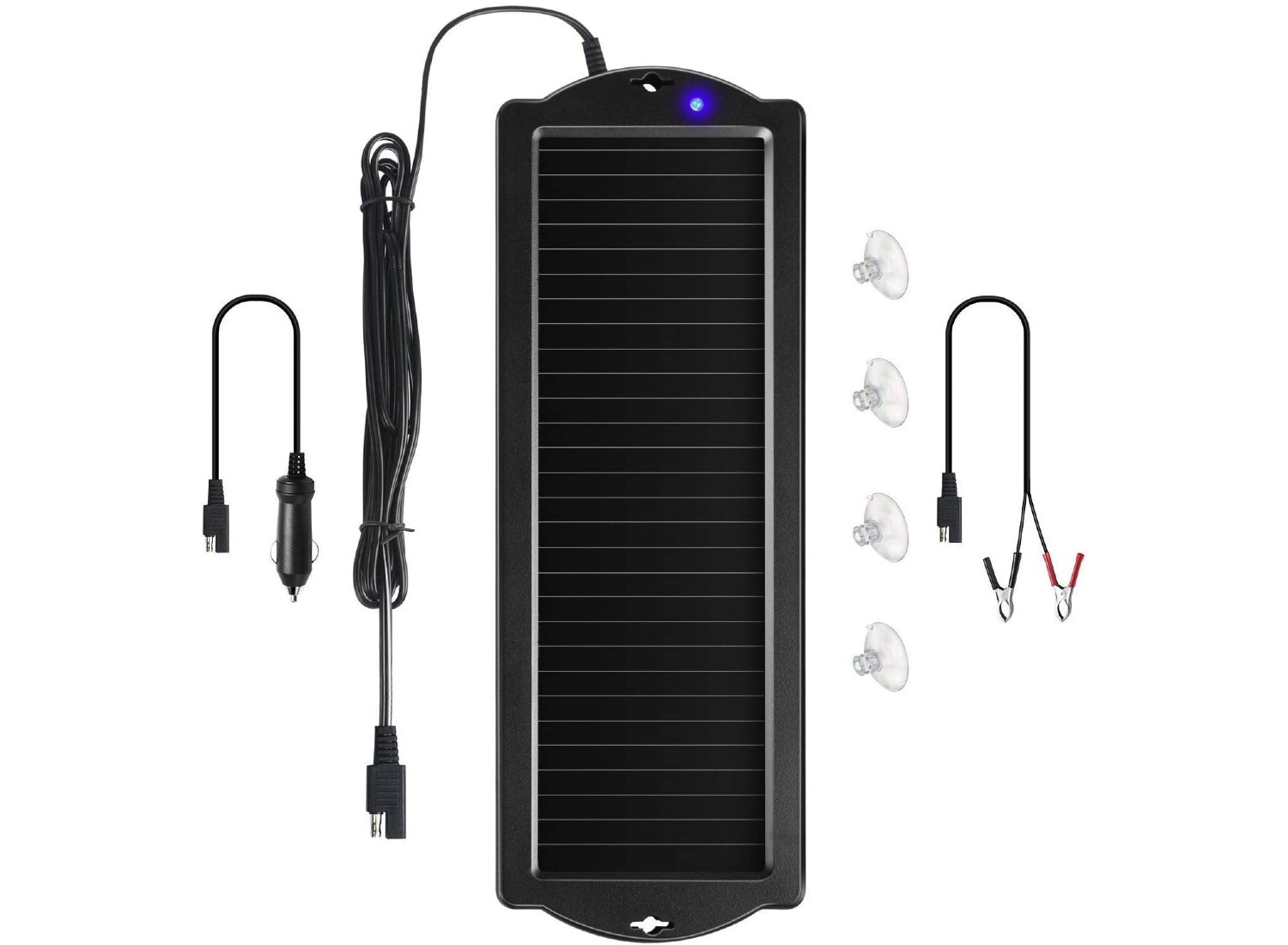
Sunway Solar Panels for Boats
The Sunway Solar Panels are battery charger panel mounts that require a simple installation on any windshield or dash, giving you a quick and convenient experience. They come with 12-volt batteries and a maintainer that protect your panels from overheating and discharging, ensuring safe and convenient use. In addition, these panels are equipped with ultra-clear PC glass, so you have a strong and durable product.
They contain built-in blocking diodes that prevent reverse charging allowing your battery to maintain its useful life. Moreover, they also come with a blinking LED charge indicator that lets you know when the job is done.
- Comes with a battery maintainer
- Do not require professional installation
- Comes with charging indicators
- Suitable to recharge small batteries only
Premier Foldable Panel
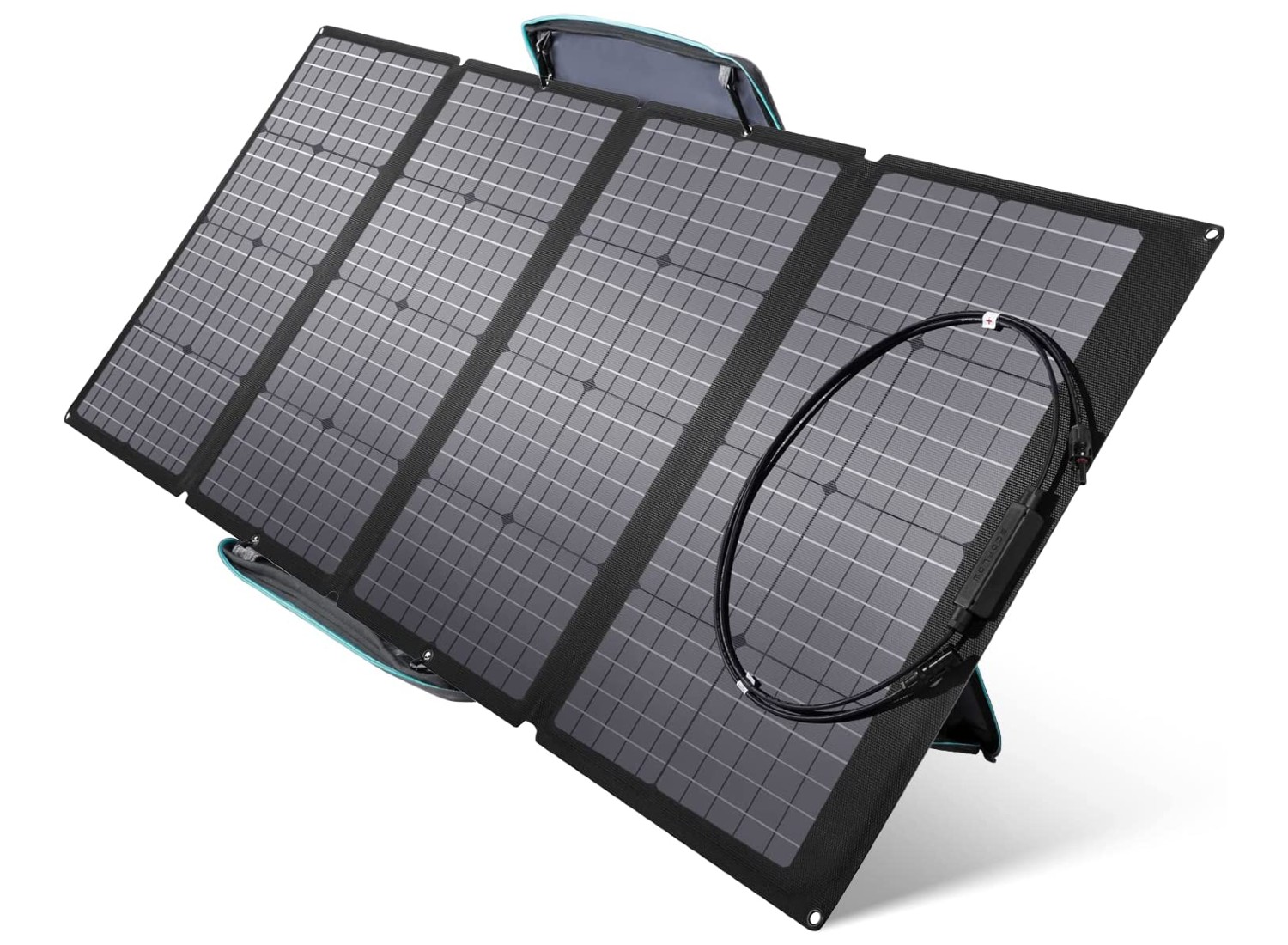
EF ECOFLOW Solar Panels for Boats
The EF Ecoflow provides 160W solar portable and foldable solar panels, delivering a compact and easy-to-carry experience. They are designed to produce maximum power at any time of the day when paired with an EcoFlow power station, so you never run out of electricity. Moreover, they have a seamless one-piece waterproof design, so you can use them during outdoor activities like camping and hiking.
These solar panels are also equipped with protection during transportation, enabling you to carry them without any concerns. Each pack comes with an Ecoflow 160W solar panel, kickstand case, user manual, and warranty card, so you don’t have to make any additional purchases.
- They can be folded for easy storage
- Comes in a complete kit
- Suitable for different outdoor activities
- Can only be paired with an Ecoflow power station
Solar Panels for Boats Buying Guide
We have compiled a detailed buying guide to help you pick a suitable product. It will give you an idea about your requirements for solar panels for boats.
What to Consider When Buying Solar Panels?
Since solar panels are an expensive addition to your asset list, here are a couple of essentials to remember when purchasing.
The size of panels is directly related to the size of your boat. You must get something to match the energy requirements of your boat or greater. A solar panel too small might not power it and leave you frustrated. Other than this, smaller products have less battery time which means they will turn off much quicker than something explicitly designed for the size of your boat.
From PVC to glass covering and fully flexible panels, the type you choose determines their cost. This helps you establish your budget according to your needs. A glass-fronted solar panel is among the most budget-friendly options, but they are not as weather resistant. Besides this, a polycarbonate version is more expensive, but they are incredibly weather resistant and have a longer life.
Accessories
A charge controller or maintainer is an essential component available for your boat’s solar panels. This product protects your panels from battery damage. They prevent any risk of overheating, battery discharge, or sudden drops. A charge controller is essential if you want to elongate the battery’s life. Most brands also offer mount brackets, so you don’t have to purchase them separately.
How Do Solar Panels for Boats Work?
Solar panels for boats work just like any other portable energy provider. To install it successfully, you must have four components: the solar panel itself, charge controller, inverter, and battery. When solar panels in the boat hit sunlight, they convert it into the electrical current, supplying your boat with the required energy.
Boat solar panels can work without a charger maintainer (controller), but there is a risk of overcharging your device. Therefore, you must keep it in place to avoid any risk of battery damage.
The need for an inverter depends on the number of appliances that need a charge. For instance, if you wish to charge multiple devices other than the boat, consider buying a large-capacity product.
You can opt for professional installation if offered by the brand or any other reputed company. But individuals who have the basics can do it all by themselves. However, you must make sure that all the relevant accessories are available at your convenience.
Installation
The installation method is divided into three main stages. The first stage is to conduct an energy assessment. In this, you will determine the level of energy that your boat needs to function. Buy a panel that has a higher voltage than your requirements. This gives more room and flexibility to charge other devices.
Check whether the solar panel can produce that level of energy. Once the capacity is determined, you can decide the exterior of your panels. In most cases, you choose between glass-fronted, polycarbonate, and fully flexible panels.
What Are Care Requirements to Enhance the Life of Solar Panels for Boats?
Caring for solar panels is essential as they are a long-term investment and should last accordingly.
Most solar panels are designed to last two to three decades. Caring for them is fairly simple but requires regular attention. All you have to do is keep them clean from dirt, leaves, and other obstructions. Solar panels from reputable brands always come with a warranty for a couple of years.
Always get a professional repair from the brand in case of any damage. Even if your warranty has expired, we recommend taking your boat’s solar panels to a professional. They might cost a bit more than a local mechanic, but your panels get the treatment they require.
Another factor to consider here is the useful life of your solar panel. This indicates that they will not be as effective as they age. The depreciation in their quality is slow and gradual.
If your product has met the end of its useful life, it won’t stop working but will get more prone to damage. So instead of getting frustrated with why your solar panel for boats isn’t working properly, consider getting a replacement from the same brand or changing your product.
Cleaning
To clean a solar panel, use lukewarm water with a mild, non-acidic detergent and apply water pressure to remove any visible dirt and debris. Panels for boats are relatively smaller, so you won’t need a lot of supply. Clean any unwanted spots with a damp cloth and leave it to dry. Avoid applying water pressure on smaller models as they might not sustain the burden.
What Are the Properties of Charge Controllers for Solar Panels for Boats?
Charge controllers are an essential component. They help protect your panels’ battery from damage. There are three main types of charge controllers available.
Basic charge controllers
They use pulse width modulation to encode transmission information allowing control of the power supplied to boats or other devices. These are simple chargers that come in at an affordable price range. A primary charge controller is designed to control batteries of smaller solar panels. They might not deliver desirable results if connected with a high-capacity panel.
Mid-range charge controllers
These controllers also use pulse width modulation but feature an LCD display to indicate current charging levels. This helps the user keep track of the system and unplug the device when it’s ready to use.
Max power charge controllers
Designed for high-end and powerful solar panels, they are one of the most expensive charge controllers. You should only attach them to devices recommended by the brand itself. They also maximize the performance of panels.
Conclusion
Solar panels are a great way to maximize energy efficiency in your boat and create a durable backup. They are available in different sizes and capacities, so you can find a suitable fit for your boat. This article carefully reviewed the most in-demand solar panels for boats in 2023 that can make a difference in your overall experience. Besides the panel, you should also grab a top-notch charge controller that protects the device from damage and enhances its life.
People Also Asked
Yes, you can run a trolling motor with solar panels, but it is essential to opt for a device that has suitable capacity.
If the panel is according to the desired capacity of the boat, it might take 4 to 6 hours for a full charge.
Solar panels reduce carbon emissions and save money by reducing fuel costs. They also reduce the noise levels caused by a fuel-ignited engine.
Article Contributors
Sail magazine review team.
SAIL Magazine Review Team reports on best-selling products in sailing and boating. The SAIL Magazine editorial staff is not involved in the creation of this content. SAIL Magazine is reader-supported: When you buy through links on our site, we may earn an affiliate commission. The SAIL Review Team is composed of authors, editors, and sailors. Artificial Intelligence (large language models) may have been used in the research and creation of the content.
To ensure questions about product testing or a specific article are addressed, please contact [email protected]
Field test: PV Modules
A real world comparison between Mono, Poly, PERC and Dual PV Modules.
* This is a field test and the results are specific for this installation on this location please research which is the best solution for your own situation as the results can be different based on environmental influences.
Total solar yield as of 27/03/2023 when the results were reset: Mono: 9158 kWh Split-cell: 9511 kWh Poly: 9113 kWh Perc: 9471 kWh Perc-east: 1970 kWh Perc-west: 1730 kWh
Enjoy the sound of silence
Harnessing the power of the wind makes sailing an unforgettable experience. All you want to hear is the sound of the wind blowing and the waves breaking. But what is the best way to power the on-board electronics while the engine and generator are switched off? Victron combines energy storage and solar generation to provide the power you need. In absolute silence.
Whether you’re sailing away for the weekend or planning a trip around the world, big chance the very same Victron solution could support both. It’s the level of comfort that really determines your optimal solution aboard. With Victron you can power just about any plans, but as an example we illustrated ‘normal’ and ‘heavier’ power profiles in the below for the ‘average’ sailing yacht.
Consumption
- Power Profile
- Complete system
How much do you need?
A modern sailing yacht is packed with a lot of electrical equipment. Most things used to run the boat usually use DC, bigger (household) appliances need AC. When it comes to estimating power consumption, many just add up the Watts. Time is equally important. A microwave might use 1000 Watts, but only for 2 minutes. A fridge might consume as little as 50 Watts, but is turned on 24 hours a day.
For inspirational purposes we’ve outlined 2 system examples based on ‘normal’ and ‘heavier’ use.
1.2 - 2.4 kWh / day
'normal' and 'heavier' energy consumption. Read more
The microwave uses 1000W an hour but is only on for 2 minutes a day. 1000W / 60 x 2 = 0.03 kWh / 2 minutes
The fridge uses 50W an hour but is on the entire day (actually cooling ½ the day). 50W x 24hrs/2 = 0.6 kWh / day
Storage & conversion
How much energy should be stored.
Storing energy allows you to live of shorepower at sea or lets you use solar power harvested during the day over night. The inverter will convert the stored power to 230V. Sailing yachts typically experience long intervals between battery recharges, so your house battery should have a generous capacity. As a rule of thumb, we’re calculating with 48 hrs on board without shore power shore/engine/generator/solar power. Multiply the daily power consumption x days for even greater independency.
The storage capacity of a lithium battery should be two times the daily power consumption.
Due to its ±50% smaller discharge capacity, the storage capacity of a lead-acid battery should be four times the daily power consumption.
The inverter should be sized to handle the average load continuously and should match the expected peak power current, which our inverters handle very well (on average 2 x their continuous current).
Where does the power come from?
Sources of power, power profile.
Normal and heavier power profiles in kWh, based on the daily energy consumption, which should be in balance with the generation.
Storage batteries in Ah, double the capacity using lead-acid batteries.
It seems like your browser does not support the latest technologies. To see this section properly, consider using a modern browser.
System diagram
For a lithium and lead-acid battery based system.
How do the system design considerations translate into a robust system?
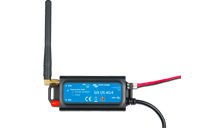
GX 4G modules

The professionals choice:

You’ll want to bring small devices on board for your trip. Or use household appliances like a microwave. These usually run of an AC outlet. Think of:
- Phone charger
- Refrigerator
Being able to plug-in these device saves you the trouble of finding a DC version.

Boat engines
Sailing yachts have one or two diesel engines (Catamarans) to get from harbour to horizon. The engines come with alternators to charge the engine batteries, drive fuel pumps, etc.
Once the starter batteries are recharged, the engines can also power the boat electrics and recharge the house battery. On bigger yachts you’ll find power hungry DC equipment such as anchor windlasses and bow thrusters. The engines have to be running before you can use them.
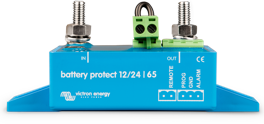
BatteryProtect
Discharging your battery too far will damage it. Adding a Victron BatteryProtect will disconnect the boat’s electronics when the battery voltage drops below a pre-set level. It will also automatically reconnect everything when the battery is sufficiently recharged.
There is more to a Victron BatteryProtect. The built-in shutdown delay ensures that vital electronics aren’t disconnected in error, i.e. when starting the engine causes a short drop in battery voltage.
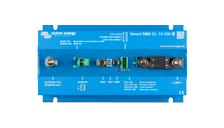
Battery Management Systems
Battery management systems take excellent care of Lithium batteries, protecting the individual cells of LiFePO4 batteries against over voltage, under voltage and over temperature and will shut down or reduce charging (VE.Bus products only) or disconnect the loads when this occurs.
Victron Energy offers several BMS options, in general the VE.Bus BMS and smallBMS signal separate devices to disconnect the charging (Inverter/Chargers, Cyrix-Li, DC-DC chargers) or disconnect the loads (BatteryProtect, Inverter/Charger), the modular Lynx distribution system features the Lynx BMS and other modules for more control over the DC busbar. For vehicles and boats all-in-one functionalities are available in the Smart BMS versions for Victron Lithium batteries, but also include current limiting to protect the alternator from overheating and BatteryProtect-like functionality to shut down the loads when pre-set critical battery conditions are met.
Victron Energy also offers full flexibility when it comes to selecting a third-party off-grid battery bank (and their BMS) of choice. A large number of well supported Lithium battery manufacturers can be easily integrated through the use of a mandatory GX-device. This flexibility enables our customers to perfectly match their off-grid needs for their unique power situation. When working with unsupported brands, a Victron Energy Battery Monitor is required to pass on accurate state of charge readings to the wider system.
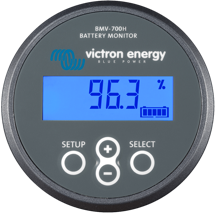
Battery Monitors
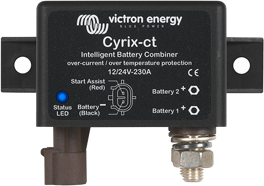
BatteryCombiner
The Cyrix BatteryCombiner is the only safe way to connect the house battery to the starter battery (to start your boat’s engines). With a BatteryCombiner you can charge the house battery from the alternator without running the risk of draining the starter battery (which always should be ready to go). When other sources of power are available (eg. shore/solar/generator power), the Cyrix BatteryCombiner will allow bi-directional charging from the house battery to the starter battery.
When the Voltages of the starter and house batteries are the same, use a Cyrix: its current rating should be equal or bigger than the current rating of the alternator. If the house battery is Lithium and the alternators Amperage is smaller than the house battery, or when the Voltages of the starter and house battery are different: use a Orion or Buck-Boost.

Boat Network
Keeping grips on all the systems on board can be a hassle. The solution: tie everything together in a single boat network using NMEA communication standards. Your boat network can include navigation equipment, tank senders, battery monitoring and much more. The status information can trigger alarms and shutdowns, adding to the safety on board. The Cerbo GX now supports the NMEA2000 out protocol, allowing you to monitor your boat’s network of systems from wherever you are.
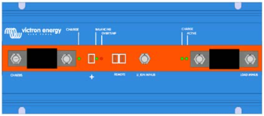
The BMS 12/200 is a dedicated battery management system (BMS) that protects Victron Smart 12,8V LFP batteries against deep discharges, overcharging and high temperatures with up to 200 Amps maximum DC current. When critical values are exceeded, the BMS acts immediately: loads are disconnected physically in case of a deep discharge and charging is stopped when there is a risk of overcharging. High temperatures trigger an immediate end to both charging and discharging.
This is the only BMS that can be directly connected to an alternator, protecting them from overload/overheating. This works with a combination of an AB fuse (rated in accordance with the expected max load current of the alternator) and an internal programmable input (which limits the input current electronically to 80% of the AB fuse).
Please check your manufacturer for the maximum charging current of your alternator and size AB fuses of the BMS 12/200 accordingly, see manual.
When different Lithium batteries & higher voltages are used, other solutions are needed, such as the VE.bus BMS and Lynx Ion BMS.

Boat Electronics
A sailing yacht is home to several electronic devices. These are all connected to the house battery. Think of:
- Boat control panel
- Log/depth sounder
- Chart-plotter or GPS
- Navigation lights
- Bow thruster
- Interior lighting
- Music player
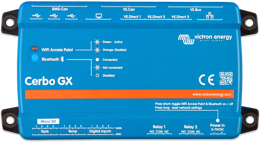
The Victron Cerbo GX is the communication-centre of your boat’s installation, allowing you to always have perfect control from wherever you are and maximises its performance. Simply connect through our Victron Remote Management (VRM) portal, or access directly, using the optional GX Touch 50 screen, a Multi Functional Display or our VictronConnect app thanks to its added Bluetooth capability.
The Victron Cerbo GX is an easy to use visual system. Instantly monitor the battery state of charge, power consumption, power harvest from PV, generator, and mains, or check tank levels and temperature measurements. Easily control the shore power input current limit, (auto)start/stop generator(s) or even set quiet periods to avoid starting the generator in the middle of the night. Change any setting to optimise the system, follow up on alerts, perform diagnostic checks and resolve challenges remotely. The Cerbo GX turns any power challenge into an effortless experience.
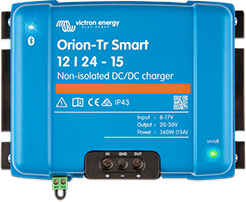
DC-DC chargers
DC-DC converters, or battery-to-battery chargers (converters with built-in charge algorithms) are used in dual battery systems, where the (smart) alternator and the start battery are combined with the service battery (of equal or different voltages) to charge it. They can also be used to charge applications that have dedicated batteries (eg. bow thrusters), or to power applications that have a voltage different than the service battery bank.
Most DC-DC chargers can be used in 12V or 24V systems and all are suitable for both lead acid and lithium batteries. Some DC-DC charger models can be parallel connected to increase the output current. DC-DC chargers are a perfect and safe solution to charge Lithium battery banks from smart alternators (and lead-acid batteries for that matter).
Charging lithium batteries from the alternator Most alternators cannot be directly connected to lithium batteries. A lithium battery will draw more current than the alternator can supply, which may result in permanent alternator damage. To not damage the alternator, current limiting is one of the options to stay within the safe zone of the alternator.
Victron offers multiple solutions to solve this problem, of which one of them are the DC-DC converters:
- DC-DC converters act as a current limiter between the alternator and the battery: the battery can be safely charged without blowing up the alternator.
- Victron also offers alternative solutions for dual battery systems powered by alternators. Some (smart) BMS products physically limit the current drawn from the alternator, in other systems, battery combiners might be a solid option. See the datasheets for more info.
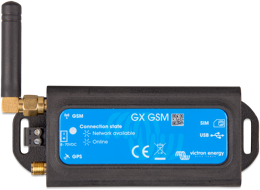
GX GSM Dongle
The Victron GX GSM is a 3G cellular modem that enables GX devices with mobile internet for the system and connection to the VRM Portal, allowing you to monitor your system from remote. When the boat is in range of a 3G network, it will send data to the VRM website and you can monitor the boat from your smartphone. The GSM module adds tracking the boat, recording your trips and putting up a geo-fence around the boat. You will get an alert via mail when the boat travels outside the geo-fence area.
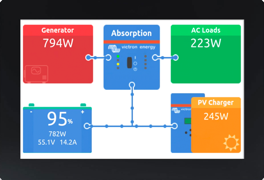
The Victron Energy Cerbo GX is the communication-centre of your systems installation, allowing you to always have perfect control from wherever you are and maximises its performance. The optional GX Touch 50 is a companion to the Cerbo GX, it’s five inch touch screen display gives an instant overview of your system and allows you to adjust settings in the blink of an eye.
Instantly monitor the battery state of charge, power consumption, power harvest from PV, generator, and mains, or check tank levels and temperature measurements. Easily control the shore power input current limit, (auto)start/stop generator(s) or even set quiet periods to avoid starting the generator in the middle of the night. Change any setting to optimise the system, follow up on alerts, perform diagnostic checks and resolve challenges remotely with the free Victron Remote Management (VRM) portal.
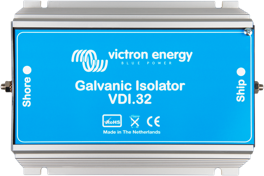
Galvanic Isolator
A galvanic isolator prevents electrolytic corrosion. The isolator is mounted directly behind the shore power connector on board. It blocks DC currents that might leak through the shore power earth terminal. These currents can cause corrosion to all metal parts under water, like the hull, propeller, shaft, etc. The galvanic isolator should have the same power rating as the incoming shore power.
It’s a misunderstanding that galvanic corrosion occurs only in metal and aluminium hulls. In fact it can occur on any boat as soon as a metallic part (the shaft and propeller) is in contact with water. Galvanic corrosion will quickly dissolve your sacrificial anodes, and attack the shaft, propeller and other metal parts in contact with water as soon as the boat is connected to the shore-side supply. It might therefore be tempting not to connect the ground conductor: this is however extremely dangerous because Ground Fault Current Interrupters will not work nor will a fuse blow in case of a short circuit to a metal part on the boat.
The safe option is to use a Galvanic Isolator for non-metal smaller boats, or use an isolation transformer for metal boats or boats with bigger systems.
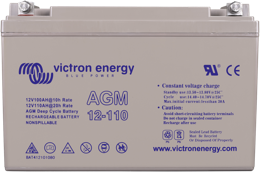
House battery
The house battery stores power for the boat’s electrical system. Sailing yachts typically have long intervals between battery recharges and the house battery should have a generous capacity.
For a house battery you can choose from two types: lead-acid and lithium. There are various reasons to favour one over the other. Here are a few common ones:
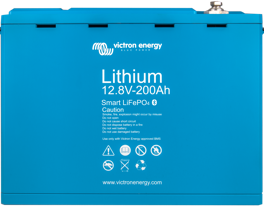
Inverter/Charger
The inverter/charger is the heart of the system. In the marina, it charges the batteries from shore power. While sailing it inverts the energy from the boat’s battery into AC power for household devices. The switch from charging to inverting and from inverting to charging is seamless.
- Victron inverter/chargers come with a handful of outstanding features:
- PowerControl: automatically manage battery charging to prevent an overload of the generator or shore power.
- PowerAssist: uses the battery as a buffer to assist the shore power during peak power demand.
- Perfect power: even sensitive devices run flawlessly on the pure sine wave power.
- High peak-power: use motorised equipment without overheating.
- Low self consumption.
For this power profile we would recommend:
We would recommend our Multiplus-II inverter/charger. If you have a generator on board you’ll need a Quattro inverter/charger, which has an extra input (shore power and generator).
We strongly recommend 24 Volts for new boats. The higher voltage is simply a better choice when it comes to meeting the power demands of a modern sailing yacht. If your boat’s system is based on 12 Volts, select a 12 Volts unit instead.
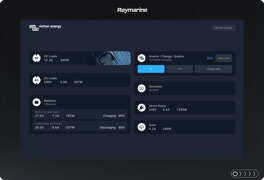
MFD GX Integration
The Victron integration between our GX range and several leading Multi Functional Display manufacturer brands enables you to easily connect an MDF to the heart of your power system such as the Cerbo GX, or the GX enabled Multiplus-II GX. Once connected you can easily monitor and control your boat’s power system, right on your Glass Bridge.
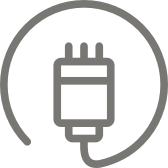
Shore Power
In the marina, the boat will be connected to shore power. Shore power recharges the batteries. It can also be used for maintenance and to run large AC loads.
Often shore power is limited in how much power you can draw, i.e. just 10 Amps. Berths with higher ratings might not always be available. Victron inverter/chargers allow you set a maximum shore power current. Now you can charge your batteries and turn on any equipment without blowing a fuse.
Sometimes shore power is less than perfect. You might run into voltage drops if you’re at the far end of the harbour. There could also be power surges, which could harm sensitive equipment on board. Victron’s inverter/chargers smooth out these problems and turn bad power into perfect power.
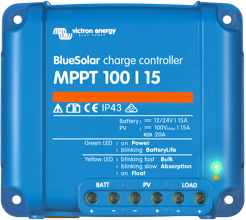
Solar charger
A solar charger- also called MPPT controller, harvests the power from the solar panels to charge the house battery. Solar chargers have the same charging cycles as our regular, fully automatic, battery chargers. When your boat is moored without shore spower, solar power is a great way to keep the batteries charged.
In a marine environment, the performance of solar panels changes constantly. Victron’s solar controllers use ultra fast maximum power point tracking to squeeze up to 30% more power out of your panels.
The rating of the solar charger is defined by the size of the solar panel. For solar panels of less than 150W or less, choose a 75/10 charger. If your solar panel produces between 150 and 220W, pick a 75/15 instead.
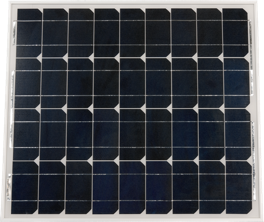
Solar panel
More and more sailing yachts area equipped with solar panels. After all, they extend the autonomy range without the noise of a diesel engine and… for free. Victron offers a wide range of small, highly efficient, solar panels that are just perfect for boats.
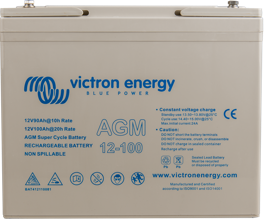
Starter Battery
The starter battery is needed to start your boat’s engine. These batteries are different from house batteries and engineered to deal with a large discharge current. The starter battery should always be ready to go. It’s best to isolate the important starter battery from all other electrical circuits on board, so it cannot be accidentally drained of power.
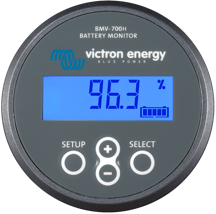
VE.Direct Bluetooth Smart dongle
The Bluetooth dongle enables you to use the VictronConnect app with VE.Direct enabled devices (without Bluetooth built-in). With the app you can have real-time insight and full control, and you can access all VE.Direct enabled devices such as the smaller VE.Direct inverters, the BMV 70x series battery monitors or MPPT solar controllers.
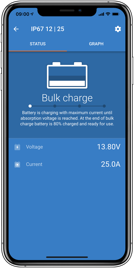
VictronConnect
All Victron products on your boat can be monitored and controlled from the palm of your hand. Just connect the VictronConnect App via Bluetooth and you’ll have direct access to values like battery voltage and current. You can also turn devices on or off, as well as change their settings.

VRM - Victron Remote Management
Monitor and manage.
Monitor and manage your Victron Energy systems from anywhere and catch potential issues early by setting alerts and alarms. With VRM you are always in perfect control from wherever you are.
VRM works with a GX-device such as the Cerbo GX with internet connection, the GlobalLink 520 or GSM LTE 4-g for smaller systems.
Monitor the battery state of charge, power consumption, power harvest from solar, generator and mains in real-time. Optimise the energy harvest and usage with history graphs and detailed analytical reports. Catch potential issues early by setting alerts and follow up on alarms to prevent definitive system failure.
Easily control the shore power input current limit, switch on the inverter, (auto)start/stop generators or even set quiet periods to avoid starting the generator in the middle of the night. With VRM you can change any setting, follow up on alarms, perform diagnostic checks and resolve challenges from wherever you are.
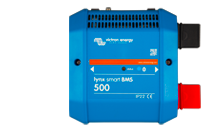
Lynx Smart BMS
The Lynx Smart BMS is a dedicated Battery Management System for Victron Lithium Smart Batteries (for non Victron Lithium batteries, see below). There are multiple BMS-es available for our Smart Lithium series of batteries, and the Lynx Smart is the most feature rich and complete option. Its main features are:
- Built-in 500A contactor, used as a fallback safety mechanism and also suitable as a remote controllable main systems switch.
- Battery monitor, indicating state of charge percentage and more data.
- Pre-alarm signal: provide a warning before the system shuts down due to -for example- a low cell.
- Bluetooth for use with our VictronConnect App, for setup and monitoring.
- Local and remote monitoring using a Victron GX device, for example the Cerbo GX.
Battery Management System
The dedicated battery management system (BMS) protects Victron Lithium Smart batteries against deep discharges, overcharging and high temperatures. When critical values are exceeded, the BMS acts immediately: loads are disconnected physically in case of a deep discharge and charging is stopped when there is a risk of overcharging. High temperatures trigger an immediate end to both charging and discharging.
Battery monitoring
Lynx Distribution system
Non Victron Lithium batteries
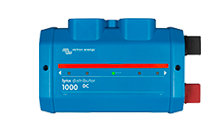
Lynx Distributor
The Lynx Distributor is a modular DC busbar, with locations for four DC fuses. It will monitor the status of each fuse, and indicate its condition with a LED on the front. When connected to a Lynx Smart BMS or Lynx Shunt, the status of the fuses will be visible in VictronConnect and VRM (when the Lynx Smart BMS is connected to a GX-device).
Multiple Lynx Distributors can be used to connect all the DC-loads and charge sources on one side of the BMS, on the other side, a Lynx Power In (without fuses) or another Lynx Distributor (with fuses) can be used to connect the battery bank to the modular busbar.
This product is part of the modular Lynx busbar system that also provides the Lynx Smart BMS, a dedicated Battery Management System for Victron Lithium Smart Batteries (for non Victron Lithium batteries, use the Lynx Shunt).
Power consumption will vary from yacht to yacht and from owner to owner, even on sailing yachts. Here are two examples - with a normal and a heavier daily energy consumption - of what an Optimal Energy plan for a sailing yacht could look like. Please note that many more factors come into play when designing and installing your optimal solution: your Victron Professional will gladly help you with that.
To see this detailed table and the entire section properly, consider using a modern browser.
It seems like your browser does not support the latest technologies to see this section properly, consider using a modern browser.
MultiPlus magic: small generator, big power.
An expert view: lithium or agm aboard, get your wiring right with wiring unlimited, see your system performance right from your glass bridge, see all our marine products and more configurations., real-time insight and complete control with our victronconnect app, find your local dealer.
Our well established global network of local Victron Professionals is dedicated to help find an optimal solution for your challenge.
Count on our worldwide service
At Victron we find it essential that customers are serviced and supported quickly and competently. This is why our global network of Victron Professionals pack the highest level of technical know-how and are committed to deliver repairs as fast as possible.
So you can start or continue your journey, wherever you’re headed.
- New Sailboats
- Sailboats 21-30ft
- Sailboats 31-35ft
- Sailboats 36-40ft
- Sailboats Over 40ft
- Sailboats Under 21feet
- used_sailboats
- Apps and Computer Programs
- Communications
- Fishfinders
- Handheld Electronics
- Plotters MFDS Rradar
- Wind, Speed & Depth Instruments
- Anchoring Mooring
- Running Rigging
- Sails Canvas
- Standing Rigging
- Diesel Engines
- Off Grid Energy
- Cleaning Waxing
- DIY Projects
- Repair, Tools & Materials
- Spare Parts
- Tools & Gadgets
- Cabin Comfort
- Ventilation
- Footwear Apparel
- Foul Weather Gear
- Mailport & PS Advisor
- Inside Practical Sailor Blog
- Activate My Web Access
- Reset Password
- Pay My Bill
- Customer Service

- Free Newsletter
- Give a Gift

How to Sell Your Boat

Cal 2-46: A Venerable Lapworth Design Brought Up to Date

Rhumb Lines: Show Highlights from Annapolis

Open Transom Pros and Cons

Leaping Into Lithium

The Importance of Sea State in Weather Planning

Do-it-yourself Electrical System Survey and Inspection

Install a Standalone Sounder Without Drilling

When Should We Retire Dyneema Stays and Running Rigging?

Rethinking MOB Prevention

Top-notch Wind Indicators

The Everlasting Multihull Trampoline

How Dangerous is Your Shore Power?

DIY survey of boat solar and wind turbine systems

What’s Involved in Setting Up a Lithium Battery System?

The Scraper-only Approach to Bottom Paint Removal

Can You Recoat Dyneema?

Gonytia Hot Knife Proves its Mettle

Where Winches Dare to Go

The Day Sailor’s First-Aid Kit

Choosing and Securing Seat Cushions

Cockpit Drains on Race Boats

Rhumb Lines: Livin’ the Wharf Rat Life

Re-sealing the Seams on Waterproof Fabrics

Safer Sailing: Add Leg Loops to Your Harness

Waxing and Polishing Your Boat

Reducing Engine Room Noise

Tricks and Tips to Forming Do-it-yourself Rigging Terminals

Marine Toilet Maintenance Tips

Learning to Live with Plastic Boat Bits
- Systems & Propulsion
- Subscriber Only

Many used cruising sailboats on the market will have a couple of solar panels, a wind turbine, or possibly both. But are they working? And just as importantly, are they installed safely? Recently, I outlined a DIY inspection of the electrical systems (see “ DIY Electrical System Survey and Inspection ,” PS February 2023). In this report, we’ll cover what to look for when inspecting solar power and wind turbine systems on a used boat you are planning to buy or already own.
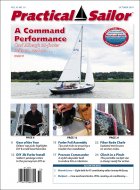
Subscribe to Practical Sailor
Already subscribed, related articles more from author.
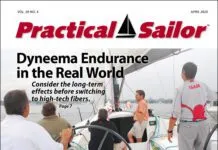
Download The Full April 2024 Issue PDF
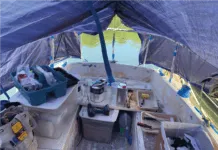
Rhumb Lines: A Delightfully Uncomfortable Truth
Latest videos.

Island Packet 370: What You Should Know | Boat Review

How To Make Starlink Better On Your Boat | Interview

Catalina 380: What You Should Know | Boat Review
- Privacy Policy
- Do Not Sell My Personal Information
- Online Account Activation
- Privacy Manager
If there's life on Europa, solar sails could help us find it
"As humanity continues to expand space exploration, chemical propulsion will hit its limit."
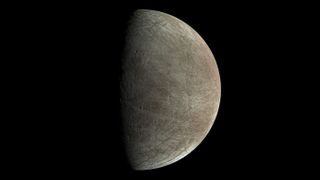
Solar sails, which harness sunlight as sailboats harness the wind, could be affordable probes in the search for alien life on at least two icy moons in our solar system — Jupiter's Europa and Saturn's Enceladus, a new study suggests.
Unlike conventional rockets , which require lots of fuel to generate thrust, solar sails leverage the subtle push of sunlight to cruise through space. They are propelled when photons, or particles of light, strike them and impart their momentum. This way, "the light itself functions like the wind," Manasvi Lingam, an astrobiologist at the Florida Institute of Technology and the lead author of the new paper, told Space.com.
The push given by light particles is slight but continuous, meaning they can eventually accelerate a solar-sailing probe to speeds unattainable with conventional rockets, which are heavier thanks to the propellant they carry — a problem that increases with the size of the spacecraft. Solar sails, however, gain momentum from the sunlight they capture, so "they don't have to carry their fuel onboard," said Lingam.
Related: What is a solar sail?
Given sails' reliance on sunlight, their use could be ultimately limited to the inner solar system, where sunlight is abundant. However, at least in theory, a network of tiny lasers here on Earth or placed in orbit at one of the Lagrange points could add further momentum and eventually propel solar sails to the outer solar system, said Lingam.
For instance, in the new study, his team estimates that a 220-pound (100 kilograms) solar sail could reach Jupiter's moon Europa in just one to four years and Saturn's moon Enceladus in three to six years.
Both worlds are thought to harbor a global salty ocean underneath their ice-covered surfaces, making them tantalizing targets in the search for alien life in our solar system. Enceladus is known to blast watery geysers from its south polar region, and hints of plumes have been spotted at Europa as well.
Get the Space.com Newsletter
Breaking space news, the latest updates on rocket launches, skywatching events and more!
Sampling such plumes, which may host intriguing biomolecules like amino acids, would allow scientists to study the makeup of the moons' oceans without needing to land a spacecraft and drill through thick ice.
When performing flybys through these plumes, high spacecraft speeds would lead to the particles striking a probe relatively hard, meaning "the molecules can be destroyed, and that, in turn, can destroy any signs of putative life," said Lingam. To avoid that, a solar sailing mission should be capable of reducing its speed to the minimum encounter velocity of about 6 kilometers per second (about 3.7 miles per second), Lingam and his team report in their new paper , published Feb. 28 in the journal Acta Astronautica.
— Watch NASA unfurl basketball-court-sized solar sail for deep space propulsion (video)
— Solar-sailing probes may soon get their moment in the sun
— Watch this Jupiter moon lander handle harsh terrain it may face on Europa (video)
This particular space technology is not unheard of. For example, LightSail 2, a crowdfunded, shoebox-sized spacecraft operated by the nonprofit Planetary Society, launched to Earth orbit in 2019. By November 2022, LightSail 2 had achieved 18,000 orbits and traveled roughly 5 million miles (8 million kilometers) during its three years in orbit — three times longer than its original design lifetime.
Solar sails have worked farther from home, too: Japan's Ikaros spacecraft demonstrated solar-sailing technology in deep space back in 2010.
Some scientists think solar sails could even propel humanity's first interstellar missions. For instance, the $100 million Breakthrough Starshot Initiative , announced in 2016, aims to build a swarm of lightweight microchip-sized spacecraft and send them to Alpha Centauri, the nearest star system to Earth. Propelled by lasers at 20% the speed of light, these light sails could reach Alpha Centauri in just 20 years—within our lifetimes.
After 65 years of exploring our solar system with conventional rocket technology, "at some point, we're going to encounter the limits of what can be explored with chemical propulsion," said Lingam. Solar sail technology could very well herald a new era of space exploration, he added, especially if it's going to be well-suited to search for signs of life in places "considered among the most promising habitats for life."
Join our Space Forums to keep talking space on the latest missions, night sky and more! And if you have a news tip, correction or comment, let us know at: [email protected].

Sharmila Kuthunur is a Seattle-based science journalist covering astronomy, astrophysics and space exploration. Follow her on X @skuthunur.
Pentagon UFO office finds 'no empirical evidence' for alien technology in new report
Our solar system's ocean moons may be habitable — and their icy shells could hold proof
SpaceX's Starship could fly again as soon as early May
Most Popular
By Mike Wall March 20, 2024
By Robert Lea March 20, 2024
By Josh Dinner March 20, 2024
By Mike Wall March 19, 2024
By Joe Rao March 19, 2024
By Meredith Garofalo March 19, 2024
By Josh Dinner March 19, 2024
By Jeff Spry March 19, 2024
By Robert Lea March 19, 2024
By Keith Cooper March 19, 2024
- 2 1 in 12 stars might have swallowed a planet
- 3 Whee! Zip down from the launch tower in SpaceX's new emergency-escape slide (video)
- 4 Wage interplanetary war in upcoming space strategy game 'Falling Frontier' (video)
- 5 7 things to buy to safely watch and photograph the total solar eclipse
Please purchase your tickets and make reservations online prior to your visit, as we cannot guarantee entry into the museum without an advanced reservation or ticket. Join us for daily flamingo feedings in Wildlife Circle at 11 a.m. and 3 p.m.

- English (United States) Select this as your preferred language
- Accessibility
- Babies & Nursing Mothers
- Getting Here
- Memberships
Voyage Solar System Model
- California Dinosaur Garden
- Birthday Parties
- Corporate Events
- Family Programs
- School Programs
- Summer Camps
- In the News
- Meet the Team
- 5 Things to Do with Kids in Palo Alto
- California Dinosaur Garden Q + A
- Americans Motivations for and Barriers to Engaging with Science
- Accessibility at the JMZ
- Ticketing Updates
- Avian Flu Information
- Connect with Us
A voyage that will forever change your perspective of home.

Discover the solar system right here in Palo Alto.
The Voyage Solar System Model, is a 1 to 10-billion scale model of the Solar System. All of the dimensions in this model, including the size of and distance between planets, are created to scale. The beginning of the installation (aka, the sun) is located between the Junior Museum & Zoo and the Girl Scout House. The installation ends with Pluto at the Palo Alto Rinconada Library.
Voyage is a program of the National Center for Earth and Space Science Education and Exhibitology. The exhibition is designed for permanent installation in communities worldwide. We are excited to be joining this community which aims to “celebrate our remarkable capacity as a race of explorers to decipher our place in space, and through scientific inquiry, reveal the majesty of the universe”.
Experience
As a free, outdoor exhibit, the Voyage Solar System Model is available to the public during and outside of Palo Alto’s Junior Museum & Zoo’s operating hours. Visitors are welcome to explore this exhibit on their own time and at no cost.
Below is a map of the entire exhibit.

Community Benefits
This beautifully designed and precise model resonates with our commitment to scientific accuracy even for our youngest children. More specifically, the new exhibit has the following community benefits:
Provides exhibition visitors a free science exhibit outside of our museum walls
Provides exhibition visitors a conceptual understanding of Earth’s place in space and the nature of worlds across our Solar System through the use of high precision models, text, imagery, and activities promoting inquiry-based exploration
Extends and enhances existing informal science and STEM education experiences to outdoor spaces
Fosters a community engagement model for STEM education with the means to engage students in grades K-16; educators across grades K-12, families, and the general public
Fosters experiences and programming that are strategic (addressing a community’s educational goals in STEM education), systemic (addressing the curriculum across local school districts), and sustainable (providing content and resources on an ongoing basis)
Creates a network of Voyage Communities and fosters inter-community exchange of ideas for educational programming

We aren't the only ones excited about this new exhibit!
From Sunil Nagaraj, President of the Astronomical Society of the Pacific and Palo Alto Resident: "Given that astronomy is so often a gateway for children to fall in love with science, this solar system model will inspire even more kids with the scale and beauty of our universe. This will be a real gem for the area as I hope it draws more students and teachers to the JMZ"
From Professor Geoff Matthews, Astronomy, Foothills College: " A solar system walk would be a fantastic resource for the community – a way to give people a sense of the vast scale of our solar system and embed science learning in a casual stroll through the park."
From Pamela Dorrell, retired early education teacher: "One of the things I always found so difficult about teaching kids about space is the insane, impossible distances. I am so glad they are installing this solar system model as it should make the surreal just a little more real… while still blowing their unsuspecting, little minds!"
From Professor Sonia Tikoo, Department of Geophysics, Stanford University: "This sounds awesome - the scaled Solar System Model would be a fantastic addition to Palo Alto and the Bay Area at large! The relative sizes of the planets in our solar system and the sheer distances between them are so vast that it is challenging for humans to intuit the scales involved. In particular, this model would be a great resource for teachers and students at all levels (from preschool through undergraduates), and will aid in understanding the diversity of planetary bodies within our solar system as well as in realizing how small we Earthlings really are in the grand scheme of the cosmos."
From Josh Bloom, Palo Alto High School Astrophysics Teacher, TOSA for Social-Emotional Learning: "It’s amazing how many of us don’t know just how vast the distances between the planets are, and the fact that no poster or image could ever accurately capture their true scale. . . It is a powerful experience to recognize that we are both insignificantly small and intimately connected to something much larger than ourselves."
Learn More about our Exhibits
Junior Museum & Zoo's new wheelchair-accessible Tree House is full of fun!
Engaging children's curiosity in science and nature!
Learn about natural history in Collection Corner.
Come and meet the Flamingos and help feed them in Wildlife Circle, at 11 a.m. and 3 p.m. each day.
Meet Animals and talk to Animal Caretakers in Wildlife Circle. Flamingo feedings every day at 11:00 a.m. and 3 p.m. Meet Sequoia the bald eagle at 12 noon Wednesdays, Saturdays and Sundays.
Experience the California Dinosaur Garden in the Dawn Redwood Courtyard.
Related Information
- Voyage Website
- Voyage Community Network
- Voyage Palo Alto
- Type 2 Diabetes
- Heart Disease
- Digestive Health
- Multiple Sclerosis
- COVID-19 Vaccines
- Occupational Therapy
- Healthy Aging
- Health Insurance
- Public Health
- Patient Rights
- Caregivers & Loved Ones
- End of Life Concerns
- Health News
- Thyroid Test Analyzer
- Doctor Discussion Guides
- Hemoglobin A1c Test Analyzer
- Lipid Test Analyzer
- Complete Blood Count (CBC) Analyzer
- What to Buy
- Editorial Process
- Meet Our Medical Expert Board
Where Is My Solar (Celiac) Plexus?
Some People Refer to the Solar Plexus as the Third Chakra
- Physical Symptoms
- Managing and Treating Pain
Solar Plexus and Emotional Health
Your solar plexus is a cluster of intertwining nerves that cross paths in a central location just below the sternum (breastbone) and above the diaphragm in the upper abdominal (stomach) area.
"Solar plexus" and "celiac plexus" refer to the same thing and can be used interchangeably. In the Ayurveda healing system and yoga practices, the solar plexus chakra is called Manipura, or the third chakra. The Manipura chakra is associated with fire, personal power, and the sun's yellow energy.
This article explains what you need to know about solar plexus anatomy, how it performs different bodily functions, what causes solar plexus pain, and how to "unblock" your solar plexus using yoga poses or breathing techniques that promote emotional health.
ozgurdonmaz / Getty Images
Solar Plexus Anatomy
The solar plexus is located in the center of the torso along the body's midline at the T12/L2 vertebral level of the thoracic spine . It sits in the upper abdomen near the pancreas and wraps around the roots of the abdominal aorta .
The solar plexus is part of the autonomic nervous system , meaning it is involved in automatic bodily functions like breathing and regulating blood pressure. The solar plexus is a nerve center hub that sends signals between the gut and brain.
Nerves from the solar plexus are connected with abdominal organs and glands, such as the:
- Gallbladder
Solar Plexus Function and Spiritual Interpretation
The solar plexus's ability to communicate between the gut and brain is key to survival. Nerve signals from the solar plexus control peristalsis (wave-like contractions that push digestive material through the intestines), which affects how the gastrointestinal (GI) tract digests food. Many digestion-related issues like irritable bowel syndrome (IBS) and acid reflux have links to the solar plexus.
When the body's stress response kicks into fight-or-flight mode, sympathetic branches of the solar plexus inhibit peristalsis and redirect blood flow to skeletal muscles, which disrupts digestion in preparation for running or confronting something threatening. Conversely, the solar plexus's parasympathetic nerves activate when the body feels safe and calm. These "rest and digest" nerve fibers promote peristalsis and healthy digestion.
There are ways to hack into the solar plexus and override some of its involuntary responses. For instance, taking a deep diaphragmatic breath followed by a long, slow exhale through pursed lips (as if blowing out lots of candles on a birthday cake) activates the vagus nerve and can soothe a "nervous stomach" via the solar plexus.
If you're feeling unmotivated or lacking gusto, taking quick, shallow breaths with short, forceful exhalations that emulate hyperventilation can trick your sympathetic nervous system into gear and put a "fire in your belly" by activating the sympathetic nerves emanating from the celiac plexus.
Solar Plexus Chakra in the Ayurveda Belief System
In Ayurvedic medicine, the solar plexus chakra is the third chakra in the body's seven-chakra system. It's located below the fourth (heart) chakra. In Sanskrit, the third chakra is called Manipura , which means "city of jewels" or "lustrous gem" because it's associated with the element of fire and the sun's sparkly yellow hue.
What Is Ayurveda?
Ayurveda is an ancient system of natural medicine that started in India many millennia ago. In Sanskrit, ayur means "life," and veda means "knowledge." Hence, the direct translation of Ayurveda is "life knowledge" or "science of life."
Prana is a broad term used to describe life-force energy and vital strength that circulates throughout the body. Optimizing prana is key to Ayurveda. All of the chakras are conduits for prana energy. The third chakra is the center of another vital energy called Samana vaya , which facilitates digestion and metabolism.
Solar Plexus Physical Pain Symptoms
In Ayurvedic medicine and yogic practices, "unblocking the solar plexus" or third chakra is a good thing. In this context, removing a solar plexus "block" opens up the body's central energy channel called Sushumna nadi , which allows life-force energy to flow freely through all seven chakras from the spine's base to the head's crown.
According to the Ayurveda belief system, physical pain symptoms of a solar plexus chakra "blockage" can include:
- Indigestion
- Pancreas issues
- Liver problems
- Colon inflammation ( colitis )
Accurately using the words "block" or "unblock" in reference to the solar plexus and pain symptoms varies depending on the context. In Western medicine, a "celiac plexus block" is a medical procedure that deadens nerves in the solar plexus that send pain signals up to the brain from the stomach area and is used to manage chronic upper abdominal pain that doesn't respond to other treatments.
Sometimes, "Blocking" the Solar Plexus Is Good
A celiac plexus block (CPB) can provide pain relief and offset the use of opioids for pain management in people with pancreatic cancer , pancreatitis , gastrointestinal cancer , cholangiocarcinoma , and Crohn's disease .
Managing and Treating Solar Plexus Pain
Treatments will vary depending on the cause of solar plexus pain. For example, if solar plexus pain is caused by blunt force trauma, such as getting the wind knocked out of you during an athletic event, self-care techniques such as icing the affected area, anti-inflammatory medication, and rest can provide relief and promote healing.
More serious medical conditions that cause solar plexus pain, such as pancreatic cancer, are often treated with a celiac plexus block and neurolysis , which help manage and treat upper abdominal pain associated with the solar plexus.
According to Ayurveda belief systems, there's a connection between the solar plexus and emotional health. Anxiety and stress—as well as low self-esteem and feeling powerless—can create solar plexus chakra imbalances that perpetuate these emotions if the third chakra stays blocked.
Breathing exercises are a simple way to balance and heal the solar plexus chakra while also hacking the parasympathetic and sympathetic branches of the autonomic nervous system in this plexus.
If the solar plexus is underactive and you're in a gloomy mood, take short, quick breaths to awaken prana energy, enhance feelings of self-worth, and cultivate an "eye of the tiger" go-getter attitude by activating sympathetic nerves. Ideally, you want to use breathwork to create an energized but not overexcited state of mind by balancing the push-pull mechanisms within your nervous system.
When solar plexus nerves are overactive, and you feel stressed out, take slower breaths with a deep inhale and a longer exhale. Diaphragmatic "belly breathing" activates parasympathetic nerves and calms the nervous system, which triggers the relaxation response and promotes emotional health.
Yoga Poses for a Blocked Solar Plexus
Below are some yoga poses that can activate and balance the solar plexus by opening or "unblocking" the third chakra, which boosts confidence and can help improve overall well-being.
Reverse Plank Pose (Purvottanasana)
Sit on a yoga mat with both legs extended in front of you, your torso erect, and palms on the floor by your hips. Inhale as you lift your upper abdomen and pelvis towards the ceiling while keeping your legs straight and pointing your toes. Hold the pose for 5-10 breaths.
Warrior 2 Pose (Virabhadrasana 2)
Stand with feet wide apart and bend one leg until the bent leg’s knee is above its ankle. Twist your torso and extend both arms outwards while looking forward, keeping the other leg straight. Hold for 3 to 5 breaths. Repeat on the other side.
Boat Pose (Navasana)
Lay flat facing upwards, then lift your legs and chest simultaneously to form a “V” shape. Extend both arms forward, keeping them parallel to the ground. Feel the muscles in your core and abdominal area contract. Hold for 5-10 breaths.
Dolphin Pose (Adho Mukha Svanasana)
From a plank position with knees/shins and elbows/forearms touching the matt, bring the hips up towards the ceiling while straightening the legs to form an “A” shape. Hold for 5-10 breaths.
Sun Mudra (Surya Mudra)
Sit cross-legged with your torso erect, elbows on your knees, and palms facing upwards. Fold your ring finger towards your palms and hold it in place with your thumbs while breathing deeply. This mudra pose awakens kundalini energy and the solar plexus’s "inner fire."
The solar plexus is a bundle of nerve fibers in the upper stomach area that shoot out from a central hub like sun rays. These nerves send signals back and forth between the brain and the gut. The solar plexus is called the third chakra in spiritual and yoga practices. When this chakra is blocked, it makes people feel less confident and lose their self-esteem. Yoga poses that activate the solar plexus can unblock this chakra and boost feelings of personal power. Quick, shallow "fire breathing" also unblocks this chakra and awakens vital life-force energy.
Yoga Journal. Everything you need to know about the solar plexus (navel) chakra .
Pereira GAM, Lopes PTC, Santos AMPV dos, et al. Celiac plexus block: an anatomical study and simulation using computed tomography . Radiol Bras . 2014;47(5):283-287. doi:10.1590/0100-3984.2013.1881
John RS, Dixon B, Hendrix JM, Shienbaum R. Celiac plexus block . In: StatPearls . StatPearls Publishing;2024.
Nutritionist Resource. How to balance your chakra for digestion .
Hansen AB, Moralez G, Romero SA, et al. Mechanisms of sympathetic restraint in human skeletal muscle during exercise: role of α-adrenergic and nonadrenergic mechanisms . American Journal of Physiology-Heart and Circulatory Physiology . 2020;319(1):H192-H202. doi:10.1152/ajpheart.00208.2020
Magnon V, Dutheil F, Vallet GT. Benefits from one session of deep and slow breathing on vagal tone and anxiety in young and older adults . Sci Rep . 2021;11(1):19267. doi:10.1038/s41598-021-98736-9
Russo MA, Santarelli DM, O’Rourke D. The physiological effects of slow breathing in the healthy human . Breathe . 2017;13(4):298-309. doi:10.1183/20734735.009817
Arhanta Yoa. Solar plexus chakra: Healing powers of manipura chakra .
Surya World. Prana from ayurvedic point of view .
Sahaja Yoga Science. The central channel-sushumna nadi .
Arhanta Yoga. Solar plexus chakra: Healing powers of the manipura chakra .
Urits I, Jones MR, Orhurhu V, et al. A comprehensive review of the celiac plexus block for the management of chronic abdominal pain . Curr Pain Headache Rep . 2020;24(8):42. doi:10.1007/s11916-020-00878-4
Sachdev AH, Gress FG. Celiac plexus block and neurolysis . Gastrointestinal Endoscopy Clinics of North America . 2018;28(4):579-586. doi:10.1016/j.giec.2018.06.004
Cornman-Homonoff J, Holzwanger D, Lee K, Madoff D, Li D. Celiac plexus block and neurolysis in the management of chronic upper abdominal pain . Semin intervent Radiol . 2017;34(04):376-386. doi:10.1055/s-0037-1608861
Goodnet. 5 yoga poses to open the solar plexus chakra .
By Christopher Bergland Christopher Bergland is a retired ultra-endurance athlete turned medical writer and science reporter.
SOUTHERN CALIFORNIA MARINE ENTERPRISES
Site navigation [skip].
- Tempered Water Air Condioning
- Self Contained Air Conditioning
- Split Gas Air Conditioning
- Seawater Pumps
- Air Cooled Air Conditioning
- DuraSea Rooftop Air Conditioner
- EnviroComfort R-410A Retrofit Kit
- Cuddy dc Air Conditioning Kit
- March Pump Family
- Breathe Easy InDuct Air Purifier
- Breathe-Easy-portable
- Chilled Water Air Conditioning
- Radome ECU (HSA16K) for Ductable Radar Dome Applications
- Guidelines for Selecting A/C for Your Boat
- MasterVolt Batteries
- Charge Master Series
- Mass Charger Series
- ManualChargeMate2502_090205
- ManualChargeMate1202_090205
- DC MASTER / MAC/MAGIC Converters
- Charge Regulators
- Mastervolt Inverter/Charger Combos
- Isolation Transformers
- Mastervolt Panels/Displays
- AC System Monitor
- Standard Line Power Distribution Panels
- Delux & Premier Line Power Distribution Panels
- Solar Regulators
- Transfer Switches
- Sol-Go Solar Panels
- Cobra Wire & Cable
- FTZ Electrical Connectors
- Zeus Alternator Regulator
- EXHAUST HOSE.pdf
- FUEL HOSE.pdf
- SANITATION HOSE.pdf
- WATER SYSTEM HOSE.pdf
- U-Line Ice Makers
- ISOTHERM Ice Makers
- Vitrifrigo Ice Makers
- Eskimo-Ice EI540D & EI1000D
- LED General Lighting Festoon Base Replacement Bulbs
- LED General Lighting BA-15 Base Replacement Bulbs
- LED G-4 Bulb replacements
- Flood and Spot Light LED Replacement Bulbs
- LED General Lighting Misc. Replacement Bulbs
- LED Navigation Encapsulated Replacement Bulbs
- LED Navigation Fixtures and Bulbs
- LED Exterior Flood Light Fixtures
- LED Engine Room/Utility Lights
- LED Waterproof Strip Lighting
- High Output LED Light Bars
- LED Ceiling & Wall Fixtures
- Blown Glass LED Hanging Light Fixtures
- Bilge Pumps
- Deck Washdown
- Water Pressure Pumps
- CB SERIES TOP LOADING
- 2690_CD-030_spec_sheet-20090630-Web
- L-2607 CF Series Portable Refrigerators-Freezers
- L-2604 CR Series Built-in Refrigerators
- CDR-50 DRAWER REFRIGERATOR
- L-3209 HZB Series Portable Ice Makers Spec Sheet
- ADLER/BARBOUR COLDMACHINES
- 2693_AB_ColdMachine_spec_sheet-20090630-Web
- 2692_AB_CoolMatic_specsheet-20090630-Web
- 2146_GRU_Passagemaker_specsheet-20090227-Web
- 0831_KRA_specsheet-20090717-Web
- Cruise 30.pdf
- cruise 65-130.pdf
- cruise 165-271.pdf
- cruise freezers.pdf
- drawer 49-55.pdf
- drawer 65.pdf
- cruise 105-190.pdf
- DE-0041/EV-0041
- DE-0061/EV-0061
- DE-788 / EV0788
- ltplates2013
- LT SPEC SHEET
- Single Door Refrigerators
- Single Door Freezers
- Two Door Units
Sea Classic / Sea Steel
- Drawer Units
- Conversion Units
- SeaLand VacuFlush Systems
- Tecma Toilets
- Isotemp Water Heaters
- AquaMatic Mid to Large Powerboats - 40-80ft
- BLUE SEA SYSTEMS
- CZONE DIGITAL SWITCHING
- Espar Diesel Heaters
- Johnson Pumps
- LunaSea Lighting
- March Pumps
- Marine Hardware
- Marine Systems, Inc.
- PanelTronics
- Sea Recovery
- Victron Energy
- Whisper Power
- Zeus by Arco
C42LX STAINLESS STEEL
C51ix stainless steel, c60ix stainless steel, c62ix stainless steel, c75lx stainless steel, c85ix stainless steel, c90ix stainless steel, c115ix stainless steel, c130lx stainless steel, dp2600ix stainless steel.

IMAGES
VIDEO
COMMENTS
Only Today, Enjoy All Categories Up To 90% Off Your Purchase. Hurry & Shop Now. Don't swipe away. Massive discounts on our products here - up to 90% off!
Browse Auto Parts & Accessories by category type and find the parts that fit. Shop Now. Visit Virtual Showrooms & explore Installation Services. Get quick, convenient services.
Solar on a sailboat goes together like hands and gloves, but sailboat solar systems can be installed in a variety of ways. The solar components themselves create an infinite combination of possibilities for off-grid sailing. Victron Energy chargers, Renogy Panels, Sunpower Yachts, BlueSea Systems, and many more brands have entered the ...
THE AVAILABLE SPACE. In practical terms, a modern 40ft monohull would have the space for around 1,200W of PV panels (cockpit arch, sprayhood top, deck), maybe 1,500W with the addition of a few portable panels for use at anchor. The 1,200W of fixed position solar array could produce around 360Ah on a sunny summer's day (zero shading) or more ...
A solar-power installation on a sailboat is made up of two independent systems: one system to charge the batteries, and another system to provide 120-volt AC power for household appliances. In the charging system, the solar panels convert sunlight into electrical current and deliver it to the batteries via a solar charge controller.
Spending a lot of money on solar panels now might not feel ideal, but it is the most cost-effective decision. 1. Renogy Starter Kit. This starter kit is going to be perfect for installing on almost any sized boat. There are four solar panels, each can be fitted permanently to the boat.
A 10-watt horizontally mounted panel should generate between 3- and 5-amp hours per day. We'll need at least 13 volts to fully charge our 12-volt battery. As most solar cells generate at least 0.45 volts, you'll want a panel with a minimum of 33 cells, which should provide around 14.85 volts.
Marine solar panels with best Sunpower cells, 23.7-25.4%+ efficient, A+ grade solar cells only. All info and consulting available to help you choose the ideal solar panels for your needs. Visit or call, we're more than happy to help.
We had a 200w setup, nothing fancy but enough to supply our need for sailing the Bahamas. You will need between 2-8 solar panels for your sailboat. The exact amount depends on your sailboat's space and how many electronics you need to power. Most solar panels can absorb between 100-300 watts per hour.
Another factor you'll need to consider is the size of your boat battery bank. In general, a 100Ah deep cycle battery will need 180 watts of solar to fully charge, assuming you have at least four hours of sunlight a day. Thus, if you have a 200Ah battery bank, you'll need at least 360 watts of solar. In this case, two 200-watt panels would ...
ZNShine Solar ZXM6-NH120-370/M. Solar panels from ZNShine Solar are inexpensive and fit all kinds of applications, including boat systems. ZXM6-NH120-370/M provides 370 Watts of power with a 19.88% efficiency. It performs well in low-light conditions. Graphene coating increases power generation and allows self-cleaning.
Here's our choice of the best boat solar panels. 6 of the best boat solar panels available right now. Giosolar 1,000W flexible solar panel. Best flexible boat solar panel. Delivering a mighty kilowatt of power, (not far off the amount used by a one bedroom house), this Giostar package comprises ten separate 100W panels, each of which is 1,050 ...
WATTS/AMPS: 400W/22A. SIZE: 4 x 47.0" x 21.3" x 2.0". PROS: Includes x4 100W panels along with a charge controller and everything else needed to set up, ideal for sailors looking for a lot of power, easy mounting system, great price for a comprehensive kit. CONS: Rigid solar panels can only be on flat surfaces or mounted on rails ...
PV panels for boats work just like panels for residential use — they collect sunlight and route the energy either to a storage or use system. Since boat solar systems are entirely off-grid, most require the following: Solar panels; A charge controller; An inverter; Mounting brackets or other mounting hardware; A backup battery for energy storage
One 100-watt solar panel that receives direct sunlight for 5 hours will produce approximately 500 Wh of electricity (5 hours x 100 W = 500 Wh). Not considering conversion losses, that's enough electricity to power a mini-fridge for 24 hours or power a boat's GPS display for 10 hours.
This yacht sets sail with solar. The 60 square meters of solar panels produces 30-50 kWh of energy per day, enough to power all of the onboard electronic equipment for around seven hours. Solar-powered Baltic yacht. Baltic Yachts began delivery in July of its Baltic 146 Path, which includes an 8,714 watt solar rooftop and energy storage system ...
Questions call 773-965-2546 Recreational cruising sailboats and powerboats (and commercial) - Having plenty of electric power on board while cruising can make the difference between a fantastic experience and a marginal one. We know; we are cruising sailors. If you are considering solar power for your sailboat or powerboat (or camper van) and want to learn more about the technology, check out ...
He is an avid boater with vast experience in marine electrical systems and provides training and support to our dealer network and marina partners. Our company goal is to offer the boating and RV community "Outstanding Customer Service and Unbeatable Pricing". Direct Contact: 1-800-788-2322 EXT 701. [email protected].
These solar panels have aluminum and tempered glass frames, ensuring a durable and weather-resistant use. Weighing 2.75 pounds and measuring 2.32 x 13.86 x 17.13 inches, they are compact and portable. Pros. Easy to store and carry. They come in a complete kit. Provide excellent weather resistance.
A temperature sensor is only useful for systems with larger solar arrays as smaller solar systems do not provide sufficient power to over heat the batteries. * Solar Wire - While most any wire can be used in a solar system, solar wire is designed for maximum conductivity and is well insulated with a UV resistant cover. It is typically single ...
A solar charger- also called MPPT controller, harvests the power from the solar panels to charge the house battery. Solar chargers have the same charging cycles as our regular, fully automatic, battery chargers. When your boat is moored without shore spower, solar power is a great way to keep the batteries charged. In a marine environment, the ...
Powering a 12-volt air conditioning system, this solar array installed by The Yacht Rigger in St. Petersburg, FL, generates 1.8 kilowatts. Many used cruising sailboats on the market will have a couple of solar panels, a wind turbine, or possibly both.
Solar sails, which harness sunlight as sailboats harness the wind, could be affordable probes in the search for alien life on at least two icy moons in our solar system — Jupiter's Europa and ...
Guidelines for Selecting A/C for Your Boat; Electrical. Mastervolt. Batteries. MasterVolt Batteries; Battery Chargers. Charge Master Series; Mass Charger Series; Battery Isolators ... Delux & Premier Line Power Distribution Panels; Solar Regulators; Transfer Switches; Victron Energy. Batteries; Sol-Go Solar Panels; Wire & Electiral Connectors ...
Together, the solar sail quadrants will make up the 17,800-square-foot sail. Marshall leads the solar sail team, which includes Florida-based Redwire Corporation as prime contractor and Huntsville-based NeXolve as subcontractor. ... The second data source was the DSN's Goldstone Solar System Radar, located near Barstow, California, which ...
Phone: (650) 329-2241. Email: [email protected]. Non-emergency 24-hour dispatch center: (650) 329-2413. Last updated on November 17, 2023. The City of Palo Alto Utilities (CPAU) is a trusted, unbiased source of information for residents, contractors and others looking to learn more or install a home solar photovoltaic (PV) system.
This exhibit is a 1 to 10-billion scale model of the Solar System. All of the dimensions in this model, including the size of and distance between planets, are created to scale. The beginning of the installation (aka, the sun) is located between the Junior Museum & Zoo and the Girl Scout House. The installation ends with Pluto at the Palo Alto Rinconada Library.
Managing and Treating Solar Plexus Pain . Treatments will vary depending on the cause of solar plexus pain. For example, if solar plexus pain is caused by blunt force trauma, such as getting the wind knocked out of you during an athletic event, self-care techniques such as icing the affected area, anti-inflammatory medication, and rest can provide relief and promote healing.
Panels. Mastervolt Panels/Displays; ME-ARC50; AC System Monitor; PANELTRONICS. Standard Line Power Distribution Panels; Delux & Premier Line Power Distribution Panels; Solar Regulators; Transfer Switches; Victron Energy. Batteries; Sol-Go Solar Panels; Wire & Electiral Connectors. Cobra Wire & Cable; FTZ Electrical Connectors; Zeus Alternator ...